
in Geelong and The Bellarine
From its photogenic waterfront and enviable beaches to an ever-growing culinary scene, there are endless reasons to venture across Bass Strait and explore Geelong and The Bellarine.



From its photogenic waterfront and enviable beaches to an ever-growing culinary scene, there are endless reasons to venture across Bass Strait and explore Geelong and The Bellarine.

ravelling to the region is within easy reach now the Spirit of Tasmania calls Geelong its home on the mainland. A 9-to-11-hour overnight sailing, or potential daytime sailing from September to April, will see you step foot in the thriving bayside city of Geelong.
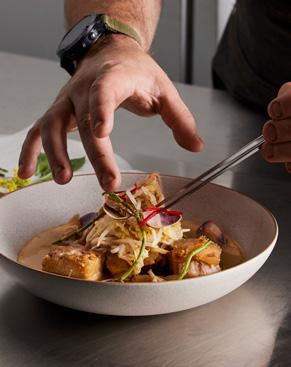
At the heart of Geelong is a flourishing creative precinct. Geelong Library and Heritage Centre is a work of art both outside and in. Next door, one of the country’s oldest galleries, Geelong Gallery, displays nationally significant works from contemporary to old. Geelong Arts Centre is undergoing a transformation to become the largest regional space for creative and performing arts in Australia.
In a nod to Geelong’s wool-producing past, the National Wool Museum pays homage to this fibre’s significant history along with stories dating back 60,000 years to the first living cultures in the region. On the outskirts of town, explore other reimagined precincts, including Boom Gallery on Rutland Street and the Fyansford Paper Mills.

Warm up from the inside out with endless opportunities for a hearty feed. Dine fireside at elevated gastropub, Ambergris Hotel, which
brings an old-world charm into the CBD. Little Malop Street in Geelong is a melting pot of global cuisines; you’ll find everything from a big Southern bowl of Jambalaya at Pistol Pete’s Food ‘n’ Blues to sticky-sweet Greek desserts at LoukouMadness. Look down on the bustling precinct with cocktail in hand from the rooftop bar at The Aborist or be transported to the prohibition era for a sly cocktail at The 18th Amendment Bar.
For bay views as you get your fill, Sailors’ Rest, Wharf Shed Cafe and Pavilion Café offer modern Australian dining and unrivalled views of the waterfront. In a street flush with boutique shops, cafes and specialty stores, Tulip stands out on Pakington Street as a long-running hatted restaurant plating up memorable flavours.
By the glass
Gin is having a big moment in Geelong. Beneath the 108-year-old brick chimney at the historic Federal Mills precinct, nearby neighbours to the Spirit terminal, Anther Distillery produces and showcases a tantalising array of gin that’s also served at 1915 restaurant next door. Also experimental in its gin varieties, Ceres Distilling Co, has helped reinvent Grovedale alongside its neighbour Blackman’s Brewery – with 16 taps pouring craft beer straight from the source.
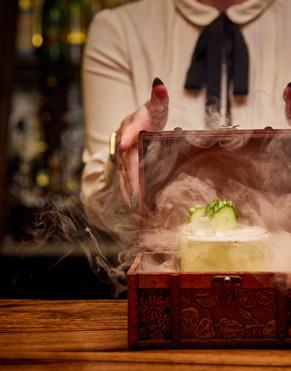
Set in an 1880 bluestone wool store, Black Sheep Chamber of Gin celebrates the handiwork of the local distilleries from the region. You’ll also find gin at The Whiskery, Thirty Acres at Bellarine Estate, FarmDog Brewery and Queenscliff Distillery.
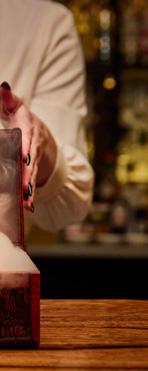
For another kind of drop to warm your soul, the region’s cool climate reds are a fitting choice. Try James Halliday favourites, Lethbridge Wines, Clyde Park Vineyard, Scotchmans Hill and Banks Road Vineyard. Back in Geelong, Union Street Wine and Geelong Cellar Door both champion local and international wines in intimate settings.
A mass of granite slabs and boulders bubbling up from the Western Plains, the You Yangs Regional Park offers endless adventures with hiking, mountain bike riding and horse-riding trails to explore. From the highest peaks, admire the 360-degree views over Wadawurrung country. Further inland the Brisbane Ranges National Park will have flora enthusiasts enthralled with the state’s richest wildflower habitat found in its many hills and gullies.
Drift east, around the bay, and discover chilled-out coastal villages, towns bursting with Victorian-era
charm and a mecca of makers and growers –best discovered via the Bellarine Taste Trail.
At the tip of the peninsula in Queenscliff, grand buildings and heritage architecture have been drawcards for more than 100 years. The town played a significant role as a maritime haven and defence stronghold. Visits to Fort Queenscliff, built around one of only three black lighthouses in the world, the Queenscliffe Maritime Museum, Queenscliff Pier and Point Lonsdale Lighthouse provide glimpses into this seafaring history. Away from the water, Queenscliff is home to the Bellarine Railway, which welcomes heritage trips for the kids during daylight. Jump on The Blues Train (Oct to May) at Queenscliff for a rocking evening or enjoy the journey in reverse aboard the gastronomic Q Train from Drysdale.
Cosy nights beckon at Lon Retreat, The Woods and Athelstane House, all located on the peninsula, where fireplaces are just one of the features of your stay.
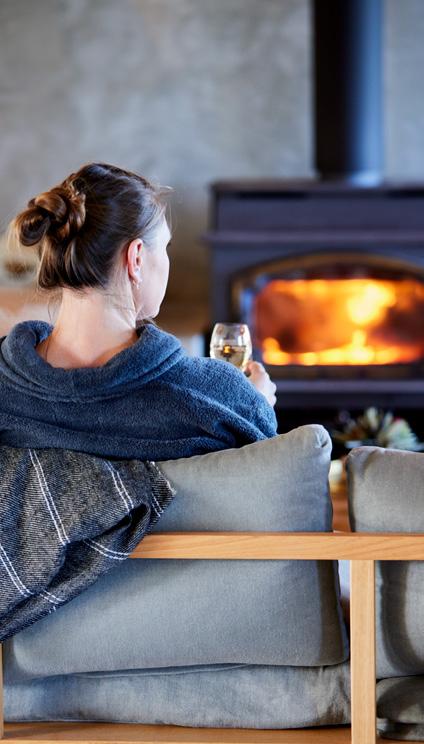
So pack the car and embrace the wintry delights in Geelong and The Bellarine.
To plan your trip head to visitgeelongbellarine.com.au

CLOCKWISE FROM LEFT Fort Queenscliff offers a glimpse into the area’s defence and seafaring history; Taste the attention to detail in every plate at Ambergris Hotel; Get cosy at Lon Retreat; Swim laps at the sea baths at Eastern Beach; Sip on awardwinning cocktails at the 18th Amendment Bar.
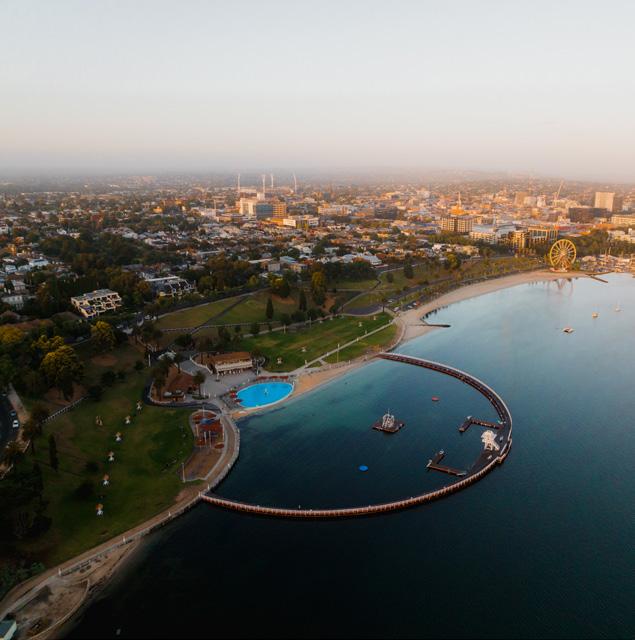
No one really wants to think about writing a Will — but it can be extremely empowering, and much easier than you expect.
A well-articulated estate plan (which includes your Will) ensures your affairs and assets are managed as you wish, and can significantly reduce stress and conflict for your loved ones when you pass away. It also provides an opportunity to establish lasting support for the people and causes you care about with bequests and the creation of trusts.

What’s more, preparing a Will with a local, estate planning expert from TPT Wealth is likely to be faster, easier and less expensive than you think.
TPT Wealth has decades of experience helping local people prepare Wills and plan their estates since being established in 1887 as a Tasmanian Trustee company.
“Most people have a lot of questions,” says Kathy Coldicutt, Senior Estate Planner, TPT Wealth. “It’s our job to have the answers and the expertise to guide you through the process. It’s important people walk away satisfied and confident everything is in order.”
To find out more, visit tptwealth.com.au or call 1300 138 044
What is an estate plan?
Your ‘estate’ refers to all of your assets and liabilities – that is everything you own that has financial value (including money), as well as any debts. An ‘estate plan’ covers how you would like your affairs and assets managed and distributed once you pass away. It includes your Will, information about your beneficiaries and the name of your Executor.
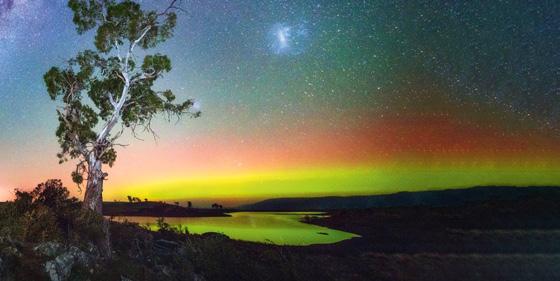
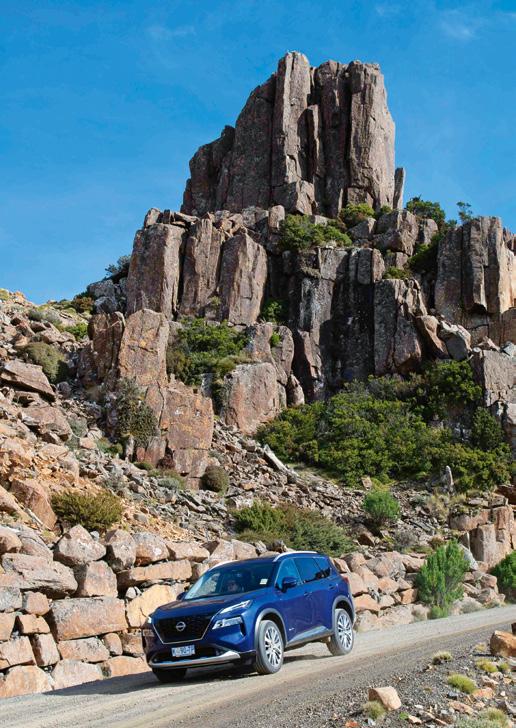

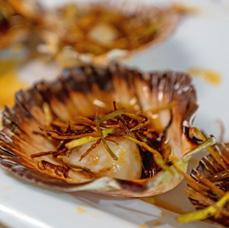

As we celebrate our 100th year, we reflect on our humble beginnings in 1923 and our evolution into an iconic and trusted institution.
Through relentless advocacy for safer roads and enhanced quality of life, we’ve played an integral role in shaping the Tasmania we know and love today.
Our centenary festivities will span the state, offering a platform for reminiscing about our rich history, celebrating our achievements and envisioning our aspirations for the future. We remain deeply grateful for the overwhelming support and participation of our members and eagerly anticipate another century of dedicated service to our community.
As seen throughout our 100-year history, our tireless lobbying led to the Tasmanian Government’s release of its response to the Legislative Council Select Committee Inquiry into Road Safety in Tasmania. We’re encouraged by the government’s collaborative Team Tasmania approach to tackling road trauma. Our efforts have paved the way for initiatives like enhanced enforcement cameras to detect speeders, illegal mobile phone use and drivers not
wearing seatbelts. We pledge to continue advocating for our 210,000+ members.
As winter descends, we’ve joined forces with Tourism Tasmania for this edition of Journeys to present our members with the ultimate winter guide: 100 reasons to stay in Tasmania this winter. This comprehensive list showcases the finest experiences our island offers during the colder months, highlighting attractions, events and adventures that will beckon you to discover Tasmania’s enchanting winter wonderland. Bundle up and embrace the magic of Tassie’s winter season!
In our pursuit of continuous improvement, we invite you to participate in a brief survey to help us understand how you consume Journeys. Scan the QR code below to take part. Your input will be invaluable as we strive to provide a more engaging and accessible experience for all our members.

Journeys is published for The Royal Automobile Club of Tasmania by Hardie Grant Media, Building 1, 658 Church Street, Richmond VIC 3121 hardiegrant.com
Managing Director Clare Brundle Editor Mary Weaver Art Director Dallas Budde
Senior Designer Sue Morony

Senior Account Manager Kellie Hammond

Advertising Senior Account Manager Colin Ritchie colinritchie@hardiegrant.com
Production Coordinator Shahirah Hambali Printer IVE Group Mailhouse D&D Mailing Services
Distribution Australia Post Australia Post No. 100003899
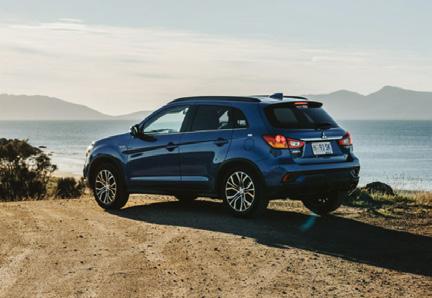
Ridiculous video screens in the middle of the dashboard of most modern vehicles are a concerning distraction for road users with plenty of buttons to push which lowers the driver’s eyes down and away from the road. Of course, vehicle manufacturers think they are a wonderful selling point regardless of the fact they are more dangerous than mobile phone usage to a driver.
Stephen WillettThe Tasmanian Government’s third-party notification process allows a person to criticise another person’s driving without the target person having access to the necessary information that would enable them to contest the criticism and leaves the target person open to driver’s licence suspension. This is unfair and leaves the notification process open to abuse.
 Michael Wadsley
Michael Wadsley
I have just read Garry Bailey’s latest article on speed limits. We all want to be safe on the roads but continual reduction of limits will not do it. We now have recently improved roads that are 80km/h, far less than the previous 100km/h speed limit. The constant barrage of “speed kills” messages misses the point that it’s not the speed limit but rather not driving to the conditions. Recent statistics suggest speed was responsible for just 16% of crashes yet we spend an inordinate amount of time in this pursuit.
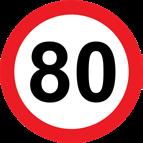 Geoff Wells
Geoff Wells
When I travelled in Britain, we noticed that the centre lines on many roads had a painted arrow curved to the left to remind motorists to keep left, especially as many European drivers travel their roads. It would be worthwhile and simple for Australia to adopt this idea to help reduce the terrible road toll.
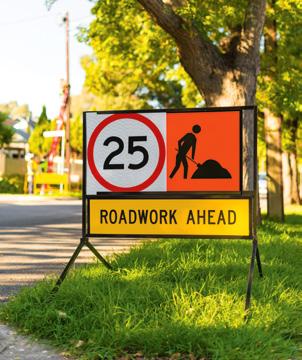 Merelyn Briton // Launceston
Merelyn Briton // Launceston
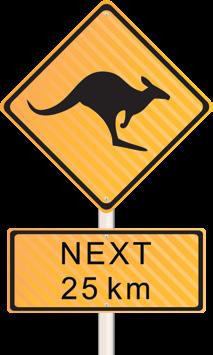
Your article on roadkill is a good start but so much more should be done to save wildlife. Devices such as ‘Sonic Animal Guard’ a whistle that warns off animals, should be mandatory fitting on all vehicles. The device may not prevent all collisions, but it can contribute to a roadkill reduction. Wildlife help and rescue phone numbers (eg Bonorong) should be printed on driving licences and road signs. Phone numbers and information on how to help an injured animal should be printed on vehicle registration renewals because education of all road users is another contributing solution. Making a slower speed limit at dawn and dusk mandatory, just as during school drop/pick up times, would also be a step in the right direction.
Jane // PenguinWe’re keen to hear your thoughts on any motoring or travel-related topics and auto questions. Please keep them brief – we reserve the right to edit.
Is there any sort of management with road repairs? Roads are ripped up for kilometres and then left as is for weeks. There will be an excavator left at one place and a grader somewhere else and us motorists must travel for so long at reduced speeds. Please can someone explain on TV now and again what is going on, so motorists don’t get so frustrated.
John // Devonportjourneys@ract.com.au
@ractofficial
With savings at over 600 Tasmanian and interstate outlets, choosing a business in the 2023-2024 Seniors Card Directory has never been easier.

Remember to look for the sign or ask if Seniors Card is accepted. To live more and pay less, pick up your free copy of the Directory at Service Tasmania, Libraries Tasmania or Visitor Information Centres. You can also access a copy online at seniors.tas.gov.au or by calling 1300 135 513
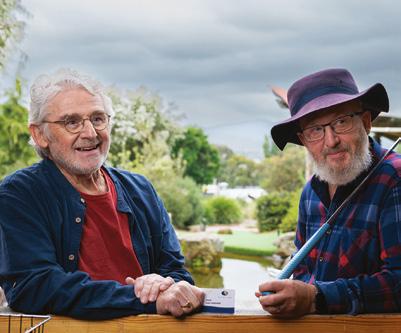
“Why hasn’t someone put in place a roundabout at the eastern end of the Bowen Bridge to keep the flow of traffic moving quicker? It seems such an easy fix.”
Jeff
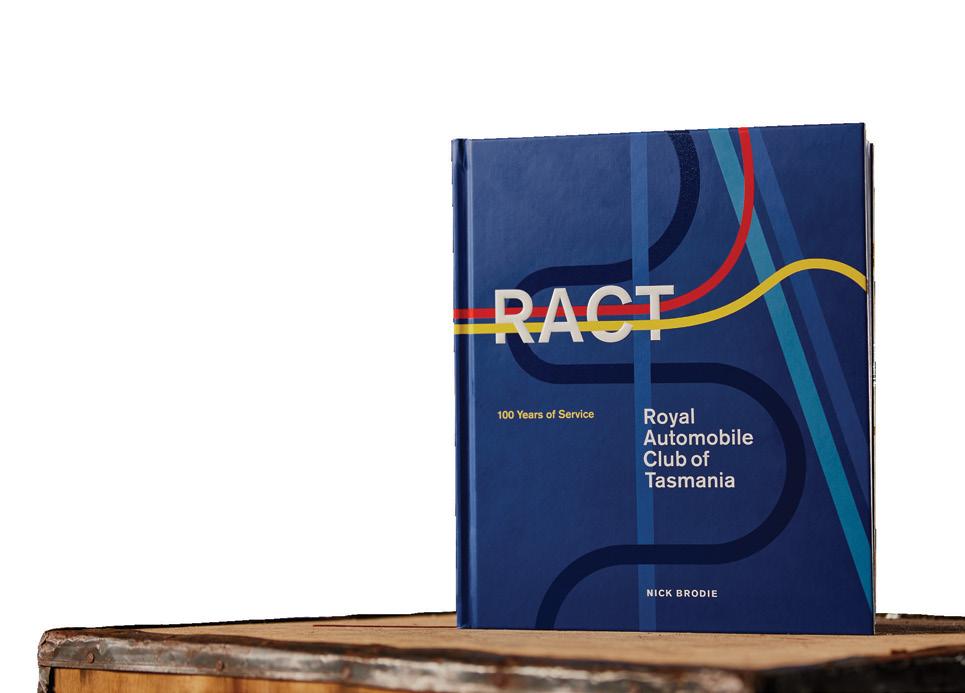

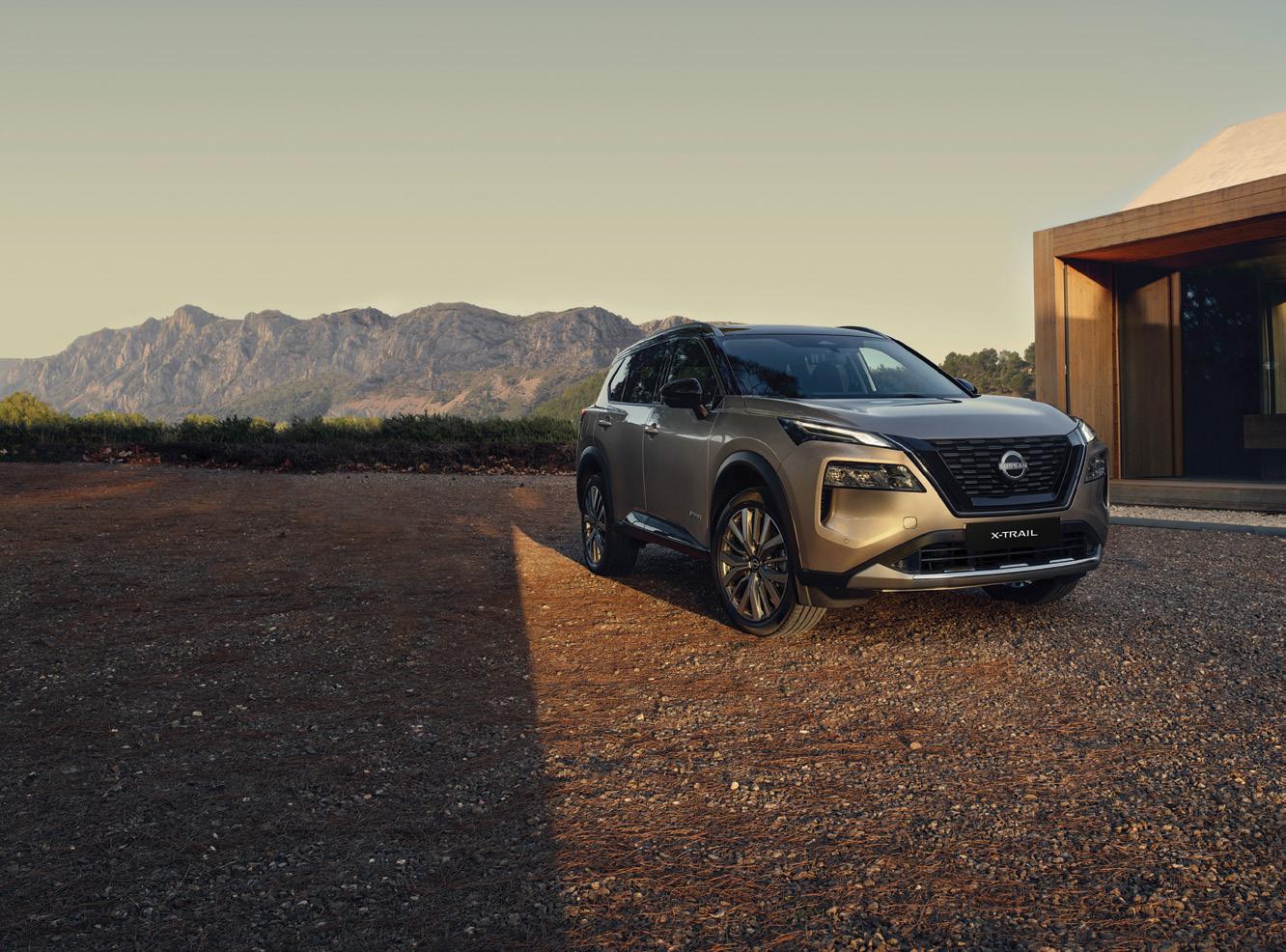

14–15 July
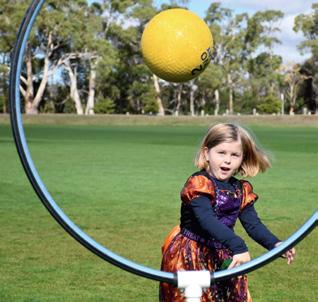
Celebrate Grove’s apple-picking history and scare evil spirits from the orchard to bring on a bumper crop at this much-loved festival. You can also listen to Tasmania’s best folk bands and join a costume competition, all while sipping on cider. williesmiths. com.au/mid-winter
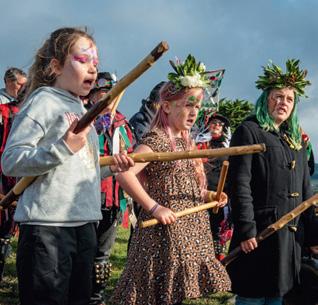
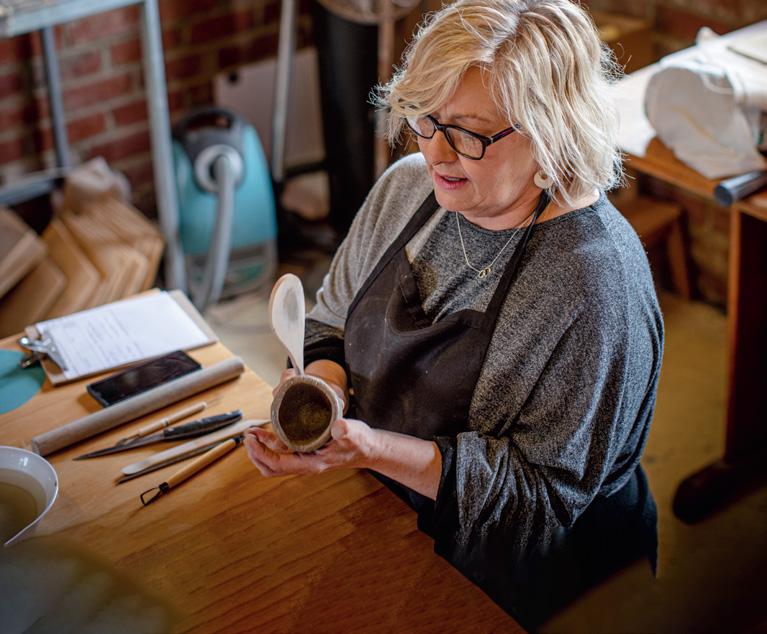
All event details are up to date at the time of print, but can change. For updates, consult organisers directly.
As an off-season special, Leap and Wander Studio in Derwent Valley, just 30 minutes from Hobart, offers a cosy refuge. Join a watercolour painting or pottery workshop while sharing spiced mulled wine and soup. leapandwanderstudio.com
30 July
Celebrate the start of the scallop season at this one-day annual event in Bridport. It features a program of entertainment accompanied by the best local beverages and fine food. tassiescallopfiesta.com.au
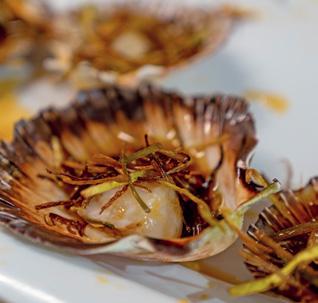
After great success this summer, the City of Hobart has extended their Healthy Hobart program with fastpaced activities including laser tag and quadball as well as more relaxing yoga and pétanque. Oh and did we mention these programs are free? hobartcity.com.au/community/ healthy-hobart
Triple M’s breakfast team is hosting garden parties to celebrate 100 years of RACT. Come along and share your RACT stories, plus have a chance to win some prizes. Join them in Launceston on 28 July and Queenstown on 18 August. Listen 6-10am live on the LiSTNR app. ract.com.au/garden-parties

Our guide to the upcoming nomination process
The RACT Constitution requires a ballot of members at the end of directors’ elected terms where there are more candidates than vacant positions.
We’re an independent voice for Tasmanians and consumers, across the areas of our business activity. Our business is increasingly complex and any successful nominee will need to have significant business acumen and be able to demonstrate material and relevant experience in order to contribute to the Board and ensure the continued successful guidance of RACT.
Our election process:
1 Prior to the election, nominations will be sought. This process will be conducted with the help of external recruitment professionals and provide potential candidates with information about the specific skills and experience being sought by the Board.
2 Eligibility to nominate for election and the election process is governed by RACT’s Constitution which can be found at: ract.com.au.
The Board considers candidates for the award of Honorary Life Membership on an annual basis. In the past such nominations have been approved by the Board and put to members for voting and announcement at our AGM. Following recent amendments to our Membership Bylaws, in future these awards will be nominated by members and determined by the Board. We would therefore ask that members contact us with any nominations for Honorary Life Members prior to 31 August 2023.
3 We’ll issue details of the nomination process via our website and other electronic channels when available. If you’d like to express an interest to receive details on the nominations process please email returningofficer@ract.com.au
4 Eligible members nominating for election will need to identify and substantiate their skills, experience and attributes in accordance with our skill requirements, and participate in an interview to evaluate their candidacy.
5 To produce a valid result, more than 2% of members are required to vote either online or, on request, by post.
6 To improve the information members receive in respect to candidates, the Board will provide additional communication to members regarding the nominees that the Board recommends members elect and why.
7 To ensure the Board can continue effectively should there be insufficient votes, in the event that there is no valid election result in 2023 these recommended candidates will be appointed by the Board to fill what will technically be casual vacancies in accordance with the Constitution.
Guidelines for the criteria by which the Board will consider any nomination are that the nominee shall be of good character and must have demonstrated exemplary service and conduct to the Club such that it warrants what is the most prestigious award available to bestow by the Club.
Please provide your nominations and reasons why you believe the nominee should receive Honorary Life Membership to returningofficer@ract.com.au
Tesla is comfortably Australia’s biggest-selling electric vehicle brand despite having a limited two-model line-up comprising the bestselling Model 3 sedan and recently launched Model Y SUV. But plenty of rivals are lining up to have a crack at the champ, including Mercedes-Benz, which now has six dedicated electric models with more on the way, and Hyundai, which recently grew its EV range to three with the launch of the slinky Ioniq 6 fastback sedan. Based on the same Electric Global Modular Platform (E-GMP) as the established Ioniq 5, the slippery five-door liftback sedan comes in three variants, all with the same 77.4kWh lithium ion battery but offering different range and performance

depending on whether it’s a single or dual motor model. The entry level Dynamiq costs $74,000 (MRLP) and features a single rear-mounted electric motor producing 168kW/350Nm and driving the rear wheels to deliver an impressive 614km of range on the WLTP cycle. The Techniq and Epiq cost $83,500 and $88,000 respectively and feature twin electric motors, sending 74kW/255Nm to the front wheels and 165kW/350Nm to the rears. The extra motor shaves 2.2 seconds off the cars’ 0-100km/h time (5.1 seconds), but reduces range for both to a still respectable 519km (WLTP).
For more visit hyundai.com.au
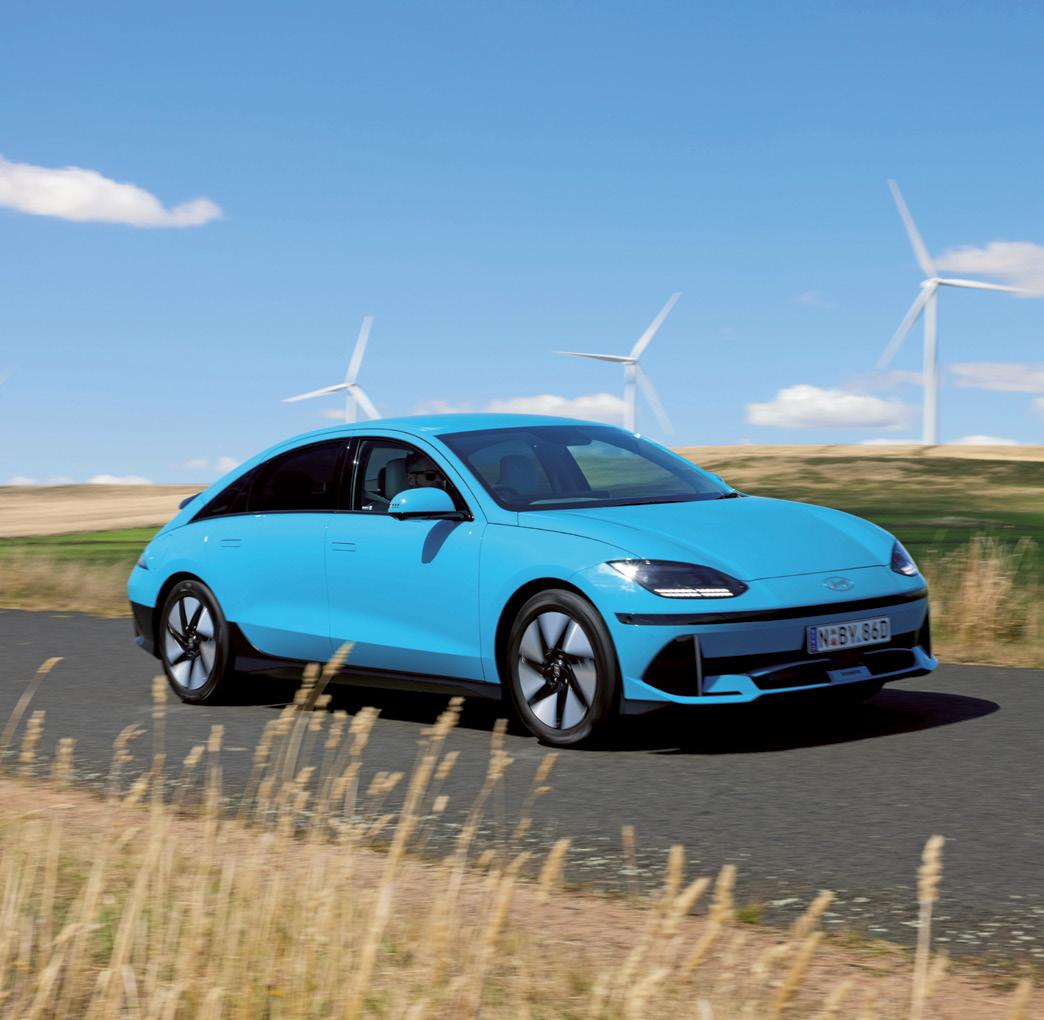
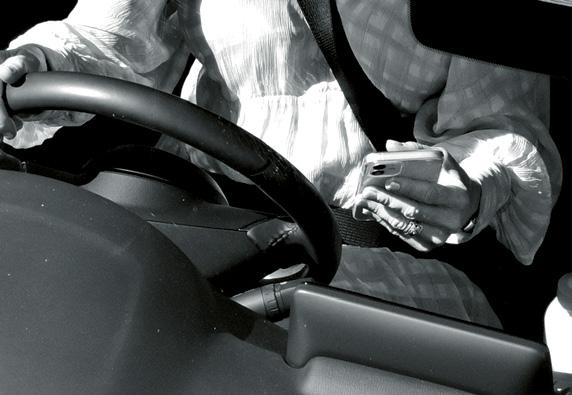
Ford Australia has confirmed that its US-manufactured battery electric Mustang Mach-E SUV will go on sale here later this year.
Available in Select, Premium and flagship GT variants, the Mustang Mach-E range kicks off with the entry-level rear-wheel-drive Select, powered by a 71kWh battery and single electric motor producing 198kW/430Nm, achieving an estimated range of 470km. Stepping up to the Mach-E Premium brings a larger 91kWh battery, a single 216kW/430Nm electric motor and the longest range in the line-up of close to 600km.
At the top of the tree sits the flagship Mach-E GT with dual electric motors delivering a feisty 358kW/860Nm to all four wheels, with the extra performance trimming the 91kWh battery’s range to 490km. No specific launch date or pricing has been revealed but in the US the Mustang Mach-E competes with the Tesla Model Y, suggesting a price range of between $70,000 and $100,000 depending on variant. The Mach-E will be Ford Australia’s first all-electric passenger vehicle, following the launch of the electric E-Transit commercial van, and will be followed by the all-electric Puma light SUV, as the Blue Oval looks to have at least five electrified vehicles available here by the end of 2024. Customers can reserve their Mustang Mach-E online or via one of Ford’s EV approved dealers. For more visit: ford.com.au

Big utes are big news in Australia, with unprecedented demand for American fullsize pickups driving a local remanufacturing boom that’s luring new players to a sector currently dominated by Ram.
6,149
The number of Ram pickups sold in Australia in 2022, representing a 53 percent increase on 2021 sales. Its rival, the Chevrolet Silverado, notched up 2,389 sales for a 12.8 percent increase over the same period.
20,000
The number of vehicles Ram Trucks Australia says it can remanufacture each year when at full capacity, thanks to the addition of a third assembly line at its Melbourne facility in 2022.
70
The percentage market share that Australia represents of Ram’s pickup sales outside of North America, making this the brand’s most important export market.
5,000
The number of locally re-engineered Chevrolet Silverados that had rolled off GMSV’s Melbourne assembly line as at November 2022, two years after the brand launched in Australia.

Cycling in Australia will be safer in the future thanks to an ANCAP safety initiative to assess the presence and effectiveness of anti-dooring technology on new vehicles.
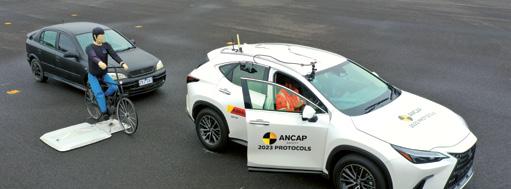
‘Dooring’ is one of the most common causes of crashes for riders, because bike lanes often overlap the door zone, or the space taken by the open door of a parked vehicle. To reduce the risk of these dooring crashes, ANCAP’s new 2023-25 test and rating criteria will encourage the inclusion of anti-dooring technology in all new vehicles. Vehicles being tested must alert the occupants of a cyclist approaching from behind – either through visual information such as a warning light on the door, by an audible and/or haptic ‘warning’ alert, or by physically preventing occupants opening the door.
“Dooring is a serious risk for cyclists, particularly in cities,” said ANCAP CEO Carla Hoorweg.
“One of the ways we can help prevent these incidents is to encourage in-car technology that reminds car drivers and their passengers to check for cyclists before they exit their vehicle, and where there is a real risk, temporarily prevent them opening their door until the cyclist has passed.”
For more visit ancap.com.au
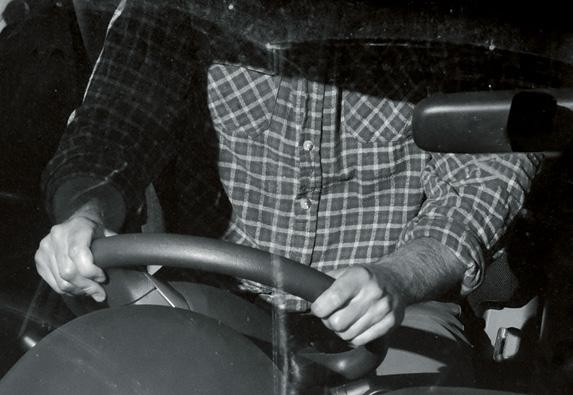
Performance meets practicality in this sporty new medium SUV from Cupra, which boasts a versatile crossover body style, all-wheel-drive traction and a high-performance 2.0-litre turbo four-cylinder engine.
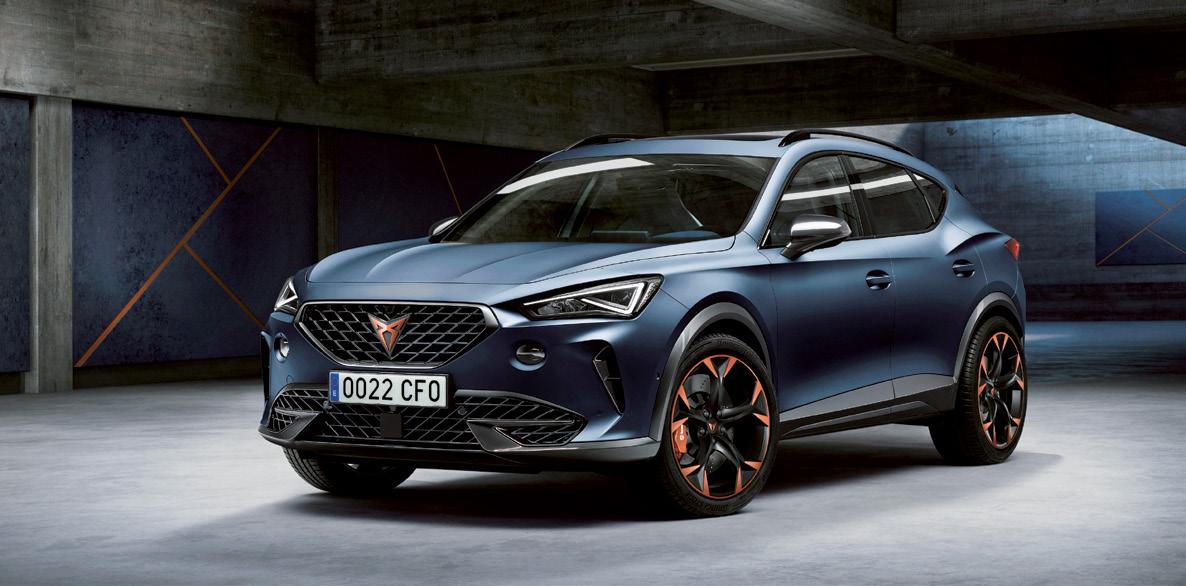
FEW CAR MAKERS are as adept at spinning multiple make-model-variants off a common set of components as the Volkswagen Group, which for years has carefully tweaked the recipe to give us different-tasting VWs, Audis, Skodas and more. Last year the German car maker’s Australian arm introduced some zesty Spanish flavours to our palates with the introduction of Cupra, the sporty arm of VW’s Spanish brand Seat.
Cupra’s four-model range includes the Leon hot hatch, Born ‘electric hot hatch’, Ateca SUV and Formentor crossover sampled here. Based on the VW Group’s widely used MQB platform the Formentor is available in front-wheel- (FWD) or all-wheel drive (AWD), and with a 2.0-litre turbocharged four-cylinder engine offered in three states of tune, plus a 1.4-litre plug-in hybrid electric variant.
The entry-level Cupra Formentor V drives all four wheels but gets the least potent engine tune at 140kW/320Nm for a retail price of $49,990; at the other end of the spectrum is this flagship Formentor VZx, priced at $63,990 and packing a high-performance 2.0-litre turbo four-cylinder. The engine punches out a potent 228kW/400Nm and drives all four wheels via a seven-speed twin clutch. The fiery VZx stands out from the SUV herd with dynamic styling and overtly sporty looks, including a quartet of exhaust tips and big 19-inch alloy wheels. Our test model came with an optional Brembo brake package ($4150) and matte paint ($2000), pushing its price to a heady $70,140. That might seem expensive but compare its claimed 4.9- second 0-100km/h sprint time with that of a Porsche Macan – you’ll need to spend $112,400 with the Stuttgart marque to best this spicy Spaniard. Switch the Formentor VZx’s steeringwheel-mounted dial to the sportiest Cupra drive mode, point it at a winding road, and prepare to be thrilled. The grip and poise is excellent, with well-weighted and accurate steering, powerfully progressive brakes, a characterful engine note and terrific acceleration. Dial it back and there’s still plenty to appreciate: a comprehensive standard equipment list, decent rear seat accommodation, a 420-litre boot, and the latest safety
and electronic driver assistance features. For drivers wanting an SUV that delivers practicality and exceptional performance, saying ‘hola!’ to this Spanish flyer could be just the ticket.
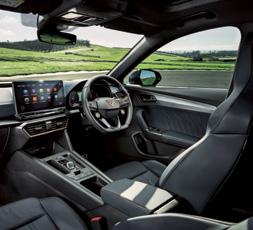
RETAIL PRICE: $63,990 (MRLP)
BODY STYLE: Medium SUV
SEATING: 5
FUEL CONSUMPTION: (Combined): 7.7L/100km (175g/km CO2)
ANCAP SAFETY RATING: 5 Star (2021)
ENGINE: EA888 Series 2.0-litre four-cylinder petrol turbo (228kW/400Nm)
TRANSMISSION: Seven-speed twin clutch
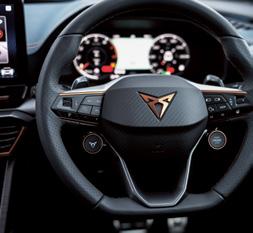
DRIVE TYPE: All-wheel drive 0-100KM/H: 4.9 seconds
For more visit cupraofficial.com.au
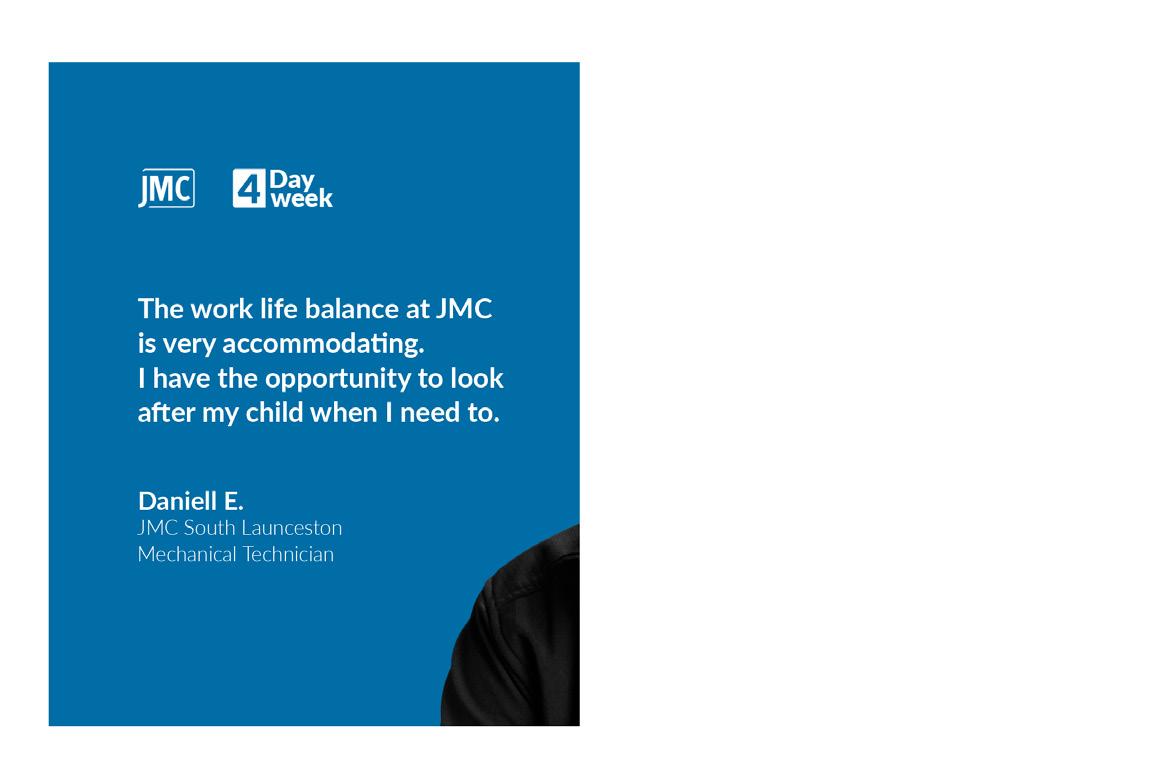
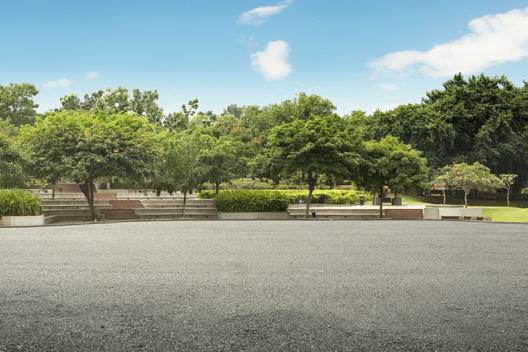

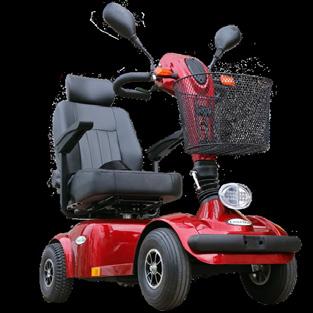
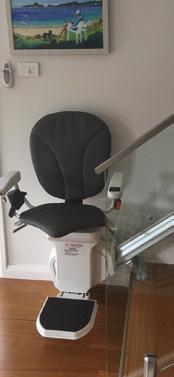
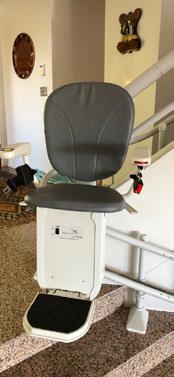
Chevrolet Corvette
ENGINE
3.8-litre pushrod in-line six-cylinder
The iconic American sports car turns 70 this year, with the occasion to be marked by the launch of the first electrified Corvette, the E-Ray, and the Australian arrival of the high-performance Z06.
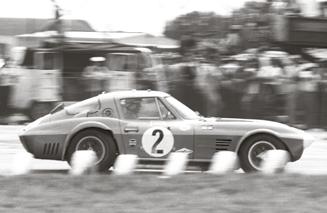 Story Harry Weller
Story Harry Weller
It’s hard to imagine now but America’s first mass-production sports car, the Chevrolet Corvette, had a near-death experience two years into its life.
In 1954, sales of the 1953 original and its hastily refreshed successor tanked in the USA. GM had rushed the fibreglass-bodied two-seater roadster into production just a few months after revealing the EX-122 concept car. The new model rode on a shortened version of an existing sedan chassis and was powered by a warmed-up 3.8-litre pushrod in-line six-cylinder hitched to a two-speed automatic gearbox. With styling overseen by legendary GM
designer Harley Earl, the Corvette had all the show but not enough go to match the new wave of post-war British sports cars, including the twin cam Jaguar XK120.
It wasn’t until 1955, with a 4.3-litre V8 and the option of a manual gearbox, that the C1 roadster finally gained traction. By 1962, the Corvette’s small block V8 was a fixture and had grown to 5.4 litres, with a more powerful fuelinjected option available. GM had honed the sports-car formula and launched the C2 Corvette roadster and the Stingray coupe variant.
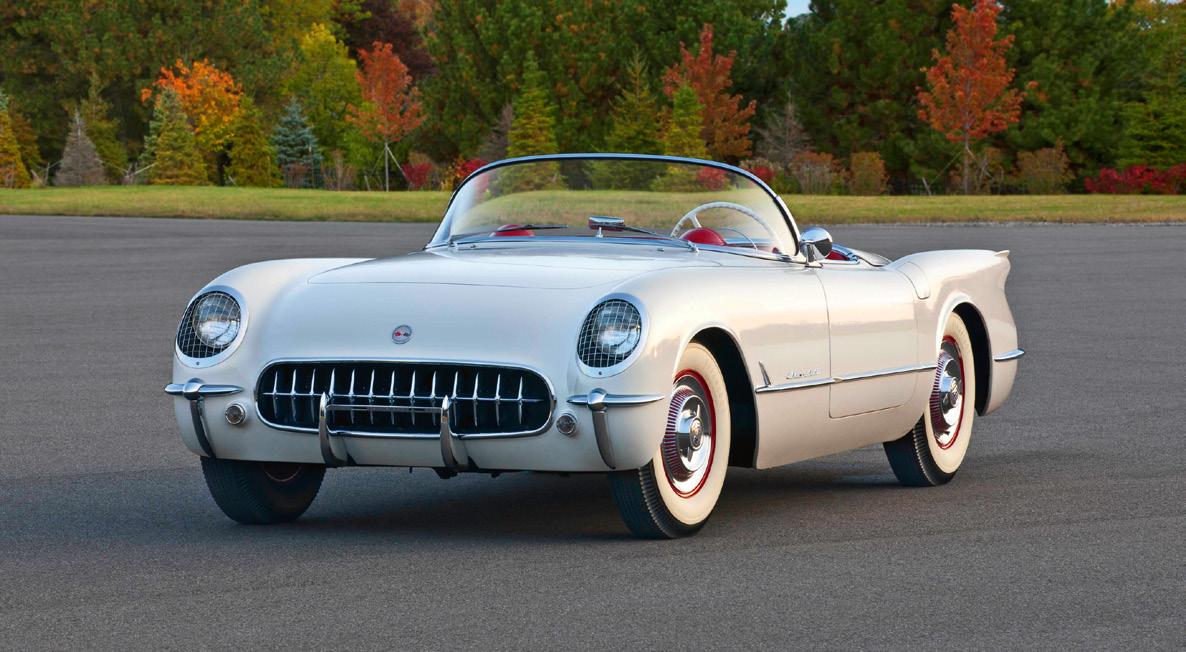
Now in its eighth generation, the Corvette has never deviated from its two-door two-seat sports car origins, and has cemented itself as the most potent American rival to European sports cars.
In 2020, with the launch of the current C8 version, GM finally delivered on the long-rumoured mid-engine model, mounting a 369kW/637Nm 6.2-litre LT2 V8 behind the cockpit, taking the Corvette’s exhilarating performance and dynamics to the next level. In 2021, General Motors Special Vehicles imported the first factory right-handdrive versions of the C8 Corvette Stingray coupe and convertible to Australia and, early this year, previewed the first right-hand-drive version of the high-performance Z06, ahead of showroom arrivals in late 2023 or early 2024. The Z06 packs a naturally aspirated 5.5L DOHC V8, with race-car-like flatplane crank enabling an 8600rpm redline and outputs of 500kW/623Nm.
Australia is also in line for the Corvette E-Ray, the first all-wheeldrive and hybrid-electric model in the brand’s history. The E-Ray, with a frontmounted electric motor bolstering the performance of the formidable LT2 V8, launches in the US this year to mark the Corvette’s 70th birthday. There’s plenty of life yet in this nameplate.
For more visit gmspecialtyvehicles.com
MODEL CLAIM TO FAME America’s first mass-production sports carThe Tasmanian Government, in collaboration with Brighte Finance, are bringing you the Energy Saver Loan Scheme. A 0% interest free loan of up to $10,000 is available on a range of energy efficient products, including Solar, Battery Storage and Heat Pump Hot Water. Call us at I Want Energy today to arrange a free consultation, and leave it to the experts.


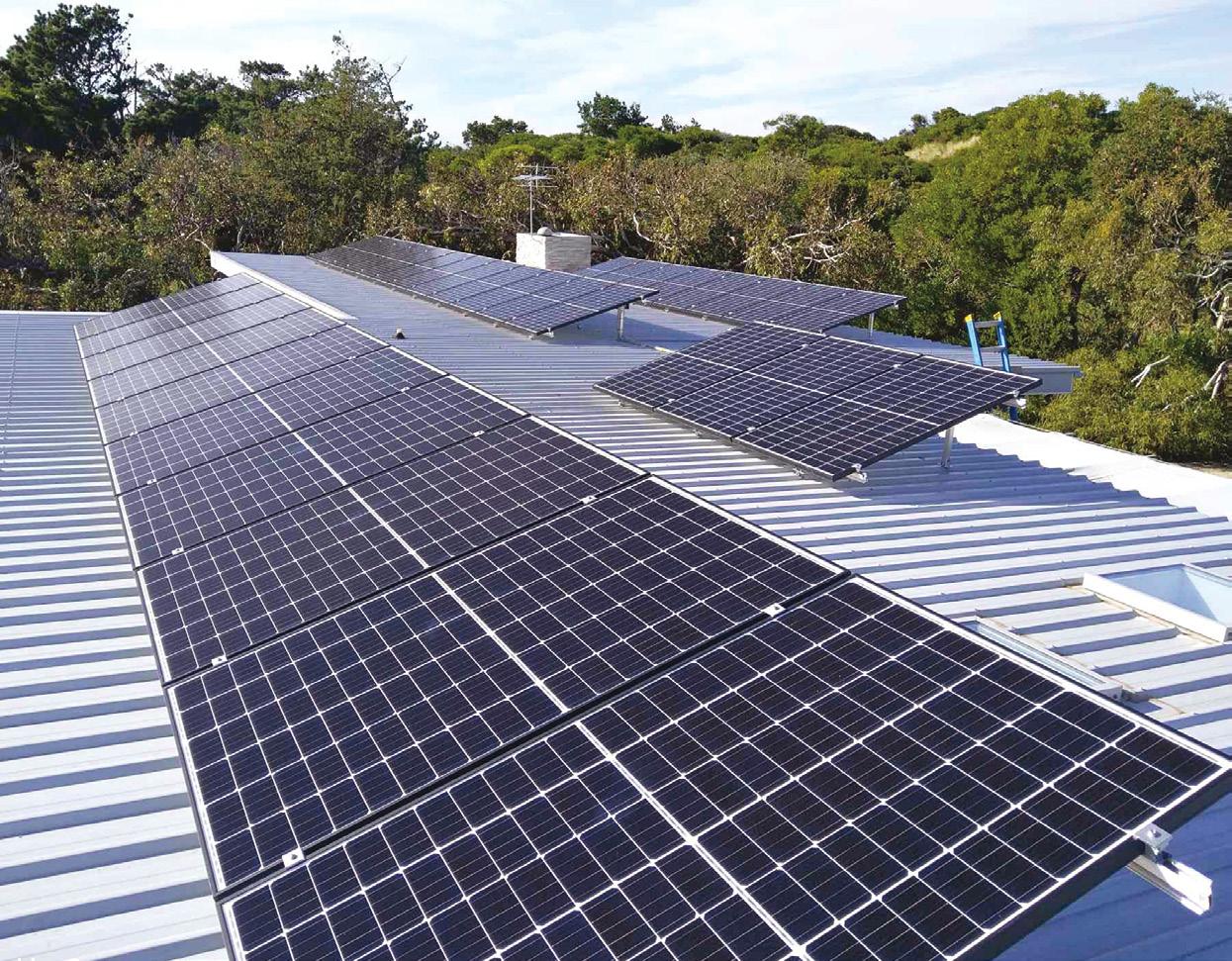
We take a new medium SUV, the Nissan X-Trail e-POWER with e-4ORCE, for a spin to Ben Lomond National Park.
Words & photos Chris Crerar
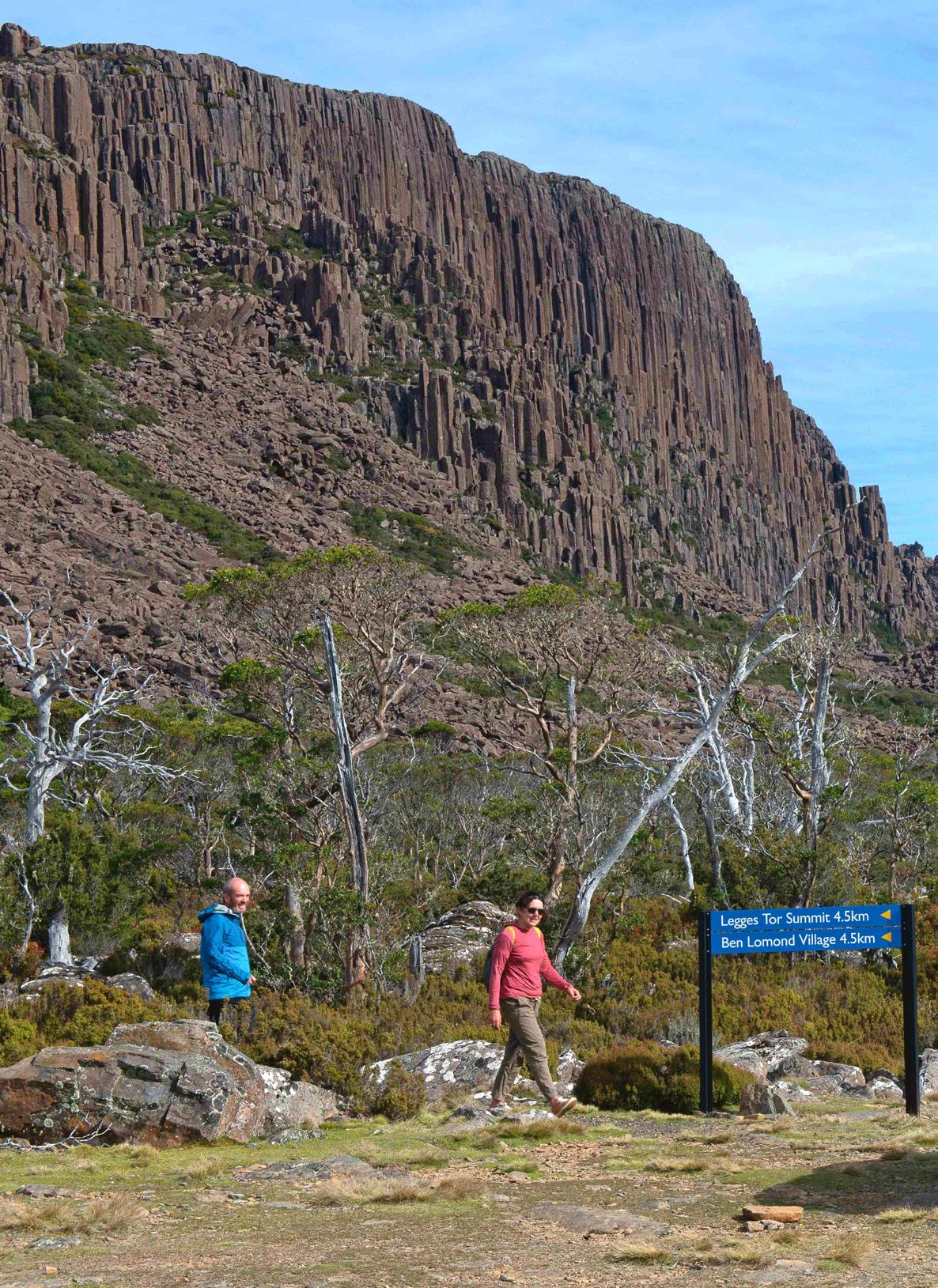
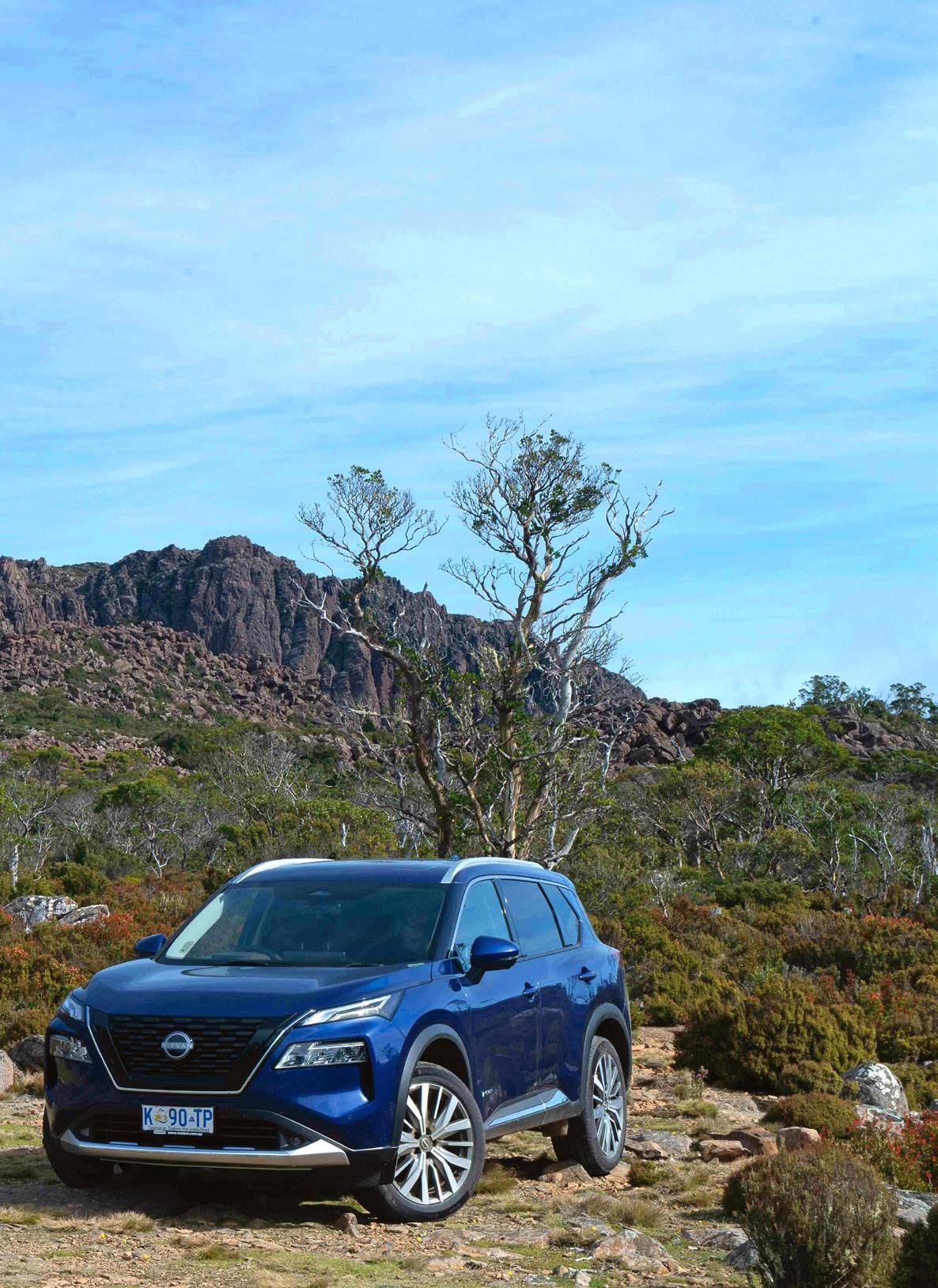
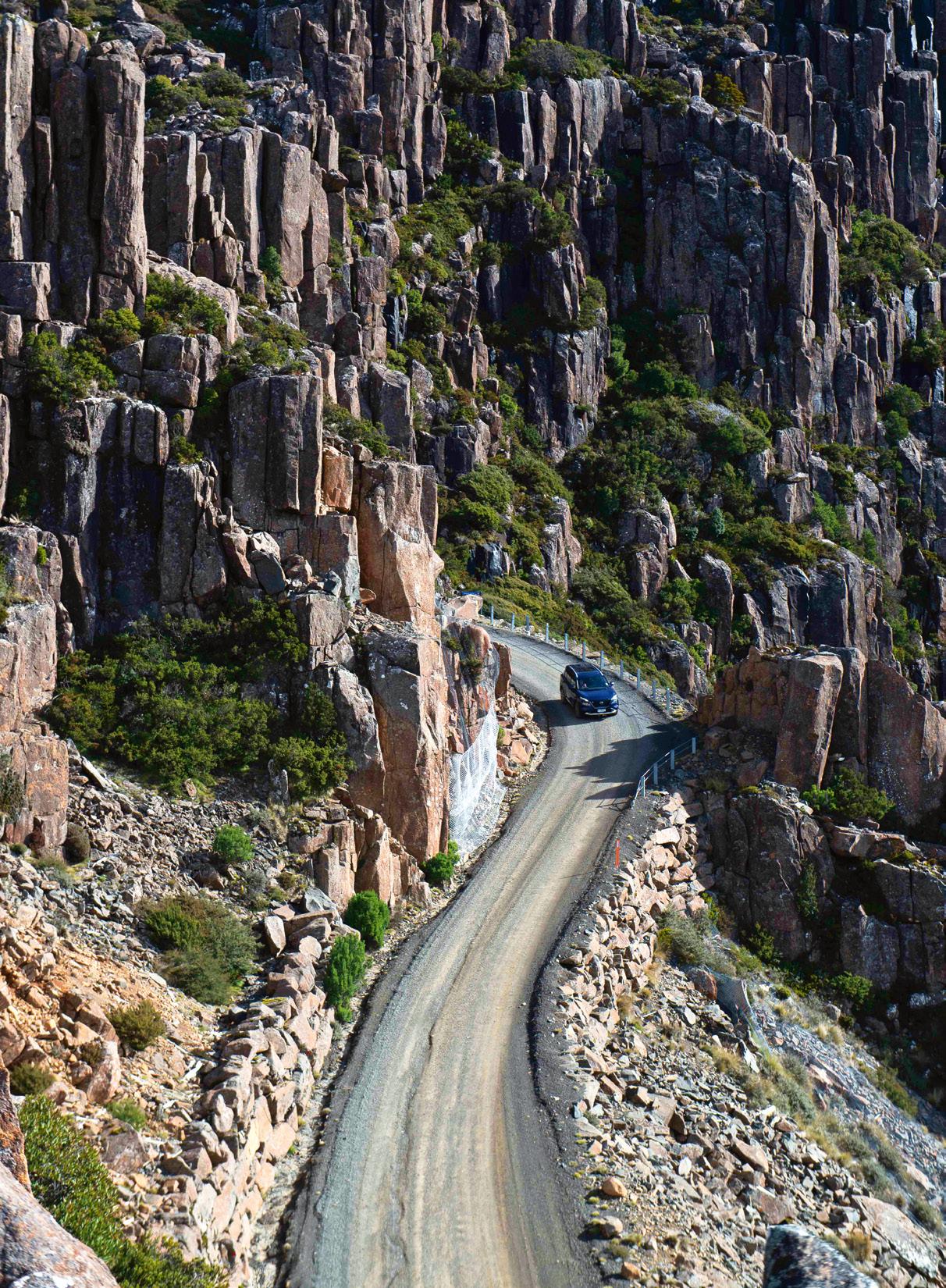
It’s a crisp, clear early-winter morning when I front up to Motors Nissan Launceston to collect one of the latest cars to hit Australian roads.
I’m liking the sound of the heated seats and steering wheel that sales rep Michael is pointing out on the new Nissan X-Trail when he shifts up a gear technically and begins explaining the medium-size SUV’s unique drivetrain.
It’s a bit early for my brain, so I pay close attention. Michael explains that the new Nissan is neither a plug-in EV nor a hybrid. Under the bonnet, it retains a 1.5-litre internal combustion engine but it’s not there to drive the wheels. Instead, the turbo-petrol three-cylinder engine acts as a generator and inverter to charge the car’s 2.1kWh lithium battery, negating the need for it to be plugged into a power source. The battery and petrol engine work in tandem to power the electric motor – or two, in this ‘e-4ORCE’ model – which drives the wheels.
I’ve chosen Ben Lomond National Park as a testing ground for this top-of-the-range Ti-L e-POWER e-4ORCE X-Trail. That’s a mouthful, but basically e-POWER refers to Nissan’s chargeas-you-go EV system and e-4ORCE to the dual electric-motor drivetrain and braking system.
Nissan claims e-4ORCE is a gamechanger in terms of stability, cornering and braking performance, on top of the benefits of a 4WD system driven by two independent front and rear electric motors.
I’m looking forward to leaving the sealed highways and experiencing how this SUV performs on gravel back roads and up Tasmania’s second-highest mountain to the Ben Lomond ski village which, at an elevation of 1460m, is the highest place you can drive to on the island.
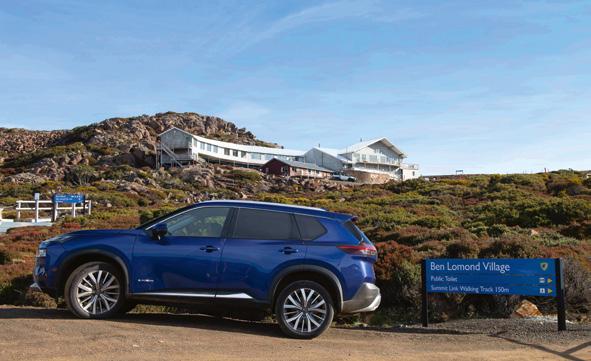
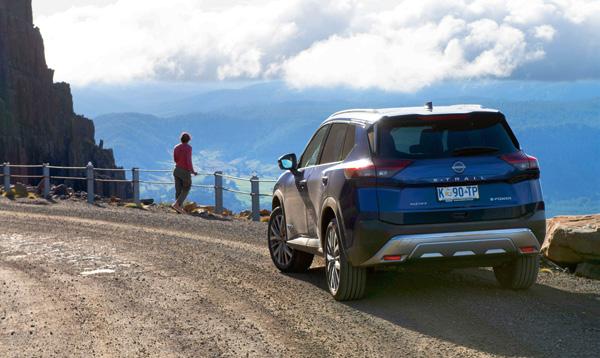
“The turbo-petrol three-cylinder engine acts as a generator and inverter to charge the car’s 2.1kWh lithium battery, negating the need for it to be plugged into a power source.”
The winding roads of Jacobs Ladder; The interiors have a sleek design; The minimalist dash design.
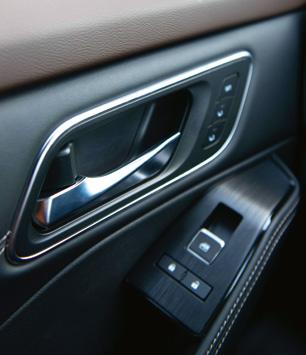
Heading south out of Launceston, my first impressions are of an X-Trail that’s highly evolved from the boxy, budget original versions first released in Australia 22 years ago. It feels refined and well-designed. I feel hugged in place by the firm, comfortable leather seats and love the clean minimalistic design of the dash, instrument cluster and infotainment screen. There are only four dials on the dash and centre console – one each for the passenger and driver’s climate control, one for the driving mode selector and an actual volume-control dial (so welcome!). Not bad at all for a vehicle laden with technology.
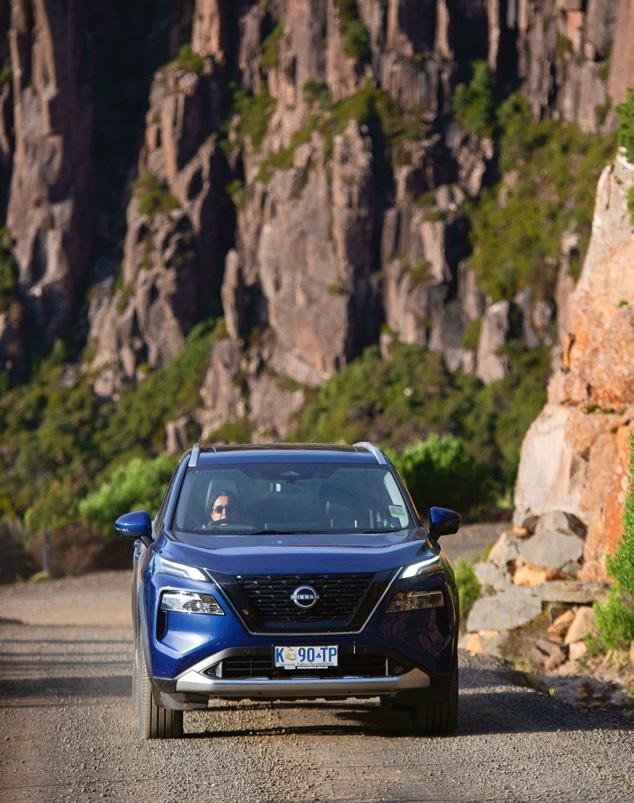
With a panoramic glass roof, three-zone climate control, Apple CarPlay, an ‘intelligent’ rearview mirror and even a little faux woodgrain, the X-Trail Ti-L feels more like a mid-range luxury vehicle than a family-focused SUV.
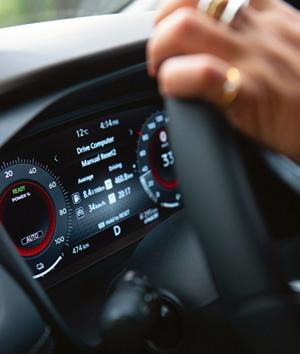
Following Michael’s encouragement, I select the e-Pedal drive mode as we head towards the historic village of Evandale for a caffeine break. At its simplest, the e-Pedal combines acceleration and braking in one. Step on the accelerator to move and lift off to brake. There are some real benefits here as braking, or decelerating, comes through the electric motors going into reverse and charging the battery, and also in terms of sustainability as it reduces reliance on the traditional braking system. I can see it would be great to use once you’re comfortable with it, but on this first drive I find my foot reaching for the brake pedal.
•
• Not a plug-in hybrid


Source: carsguide.com.au
With its 20-inch alloy wheels and cobalt metallic paint, the X-Trail stands out amid the muted tones of Evandale’s colonial buildings. We pull up at the Clarendon Arms and throw off the morning chill with hot coffee and carrot cake.
Back in the car, we’re soon on classic country roads heading directly for Ben Lomond’s imposing dolerite ramparts. The X-Trail accelerates powerfully and more like a dedicated EV than a hybrid, helped by the one-speed automatic transmission. It’s a confidence-inspiring SUV to drive, making easy work of corners and braking smoothly. I often joke to interstate friends that Tasmania’s early road builders were paid per corner, as our roads are so windy – so having a car that corners well is a real bonus.
As drivers, we know roadworks can be frustrating. CCF Tasmania CEO, Andrew Winch answers some of the most frequently asked questions from Tasmanian drivers regarding roadworks
Q1
Why is there so much roadwork around Tasmania now?
The overwhelming message from the community is they want safer roads and action toward reducing accidents. The Tasmanian roads being worked on have been reported as unsafe or a high-accident zone and these upgrades will provide a better travel experience and aid in getting all of us home safely.
Road works are an important part of the Tasmanian framework in ensuring locals and visitors are provided with a safe and reliable road network. Road works also ensures the Tasmanian transport industry can move freight around the state quickly and safely and can get products to global markets.
Unfortunately, due to the short window of good weather in Tasmania, and especially with the wet summer we have had, we need to act quickly now before the harsh effects of winter hit us. Where we can, we coordinate our works to have the least amount of impact. The weather, temperature and rain can all cause delays through the impacts of drying and setting of the road surface.
Q3
Why not remove signs when road workers aren’t there?
road surface. Your Speed is Our Safety signage is in place permanently.
Q4 Why wasn’t there an “end of roadwork” sign, up?
Contractors aim to display all necessary signage in order to meet National and State requirements. However these are temporary signs and they can sometimes be impacted by weather conditions, vandalism and theft.
Q5 Are roadwork sites policed?
Q2
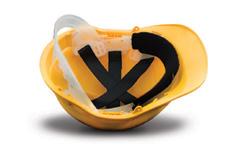
Why not concentrate on certain sections/small stretches of road at a time rather than multiple sections?
Even if you can’t see any roadworkers active at a site, the signs are always there for a reason and should always be followed for your own safety and the safety of other road users. The reduced limits reflect the roads not safe to drive at full speed and could be due to notso-obvious reasons such as loose gravel, machinery nearby, narrow lanes, new or no line markings, or changes to the
There is an emerging change in attitude by Tasmanians to the need for more enforcement around roadworks. Your Speed is Our Safety is working collaboratively with TasPolice and the Tasmanian Government to monitor worksites as a means of limiting safety risks to roadwork teams and the public alike. This includes using technology such as speed camera trailers.
Everyday hundreds of our road workers risk their safety on Tasmanian roads. If you ignore speed limits or traffic instructions for road works, you are putting lives at risk.
Please, SLOW DOWN FOR ROAD WORKERS. Your speed is our safety.
Nissan’s slick promotional videos claim the e-4ORCE powertrain and braking system will deliver power to the wheels with the most grip, ensuring confidence and stability through corners. It certainly feels like reality matches the hype in the X-Trail’s case.
Lunch at White Beach’s Pickers
Pantry; the VW Arteon contains modern touches like rainsensor windscreen wipers and Park Assist
Before long, we’ve turned onto the gravel road into Ben Lomond National Park, climbing rapidly through tall eucalypt forests. The instrument cluster tells me when the car is purely EV and when the petrol engine is assisting to run the electric motors. Heading up the mountain is a combined effort, but it takes the incline in its stride. The X-trail feels safe and capable on this relatively rough dirt road. It’s solid over bumps and potholes, and tracks well over the more corrugated sections. More of an SUV for weekend getaways than an off-roader, it does what it’s been designed for very well.
Those wanting to really get off the beaten path will love the no-plug-in charging, while others will be turned off by still needing to stop at a petrol pump and not being able to fully tap into Tasmania’s 100 percent renewable energy network. At 6.1L/100km, the e-POWER X-Trail enjoys 20 percent better fuel economy than its conventionally powered stablemate but is considerably higher than the rival hybrid RAV4’s 4.8L/100km.
We emerge from the forest at the base of what some say is Australia’s most dangerous road. Jacob’s Ladder does feel distinctly biblical as the road zigzags skyward through its six hairpin bends. Hemmed in by menacing dark stone cliffs and towers, with few roadside barriers to prevent a vehicle falling over the precipice, Parks Tasmania signs instruct motorists to proceed slowly with caution and not to stop.
My companion turns the drive mode dial onto off-road and we nervously inch forward onto Jacob’s Ladder. While the X-Trail feels safe and reassuring, we continue slowly up through each of the bends, mostly because our hearts are firmly in our mouths but also because the views are so incredible that it’s worth driving slowly just to absorb them.
We let off cheers as we round the final bend and drive out onto the plateau towards the ski village. We’re a little disappointed that there’s not a patch of snow to be seen but agree that the new Nissan would look right at home up here in deep winter parked next to a snow-covered lodge.
Book a test drive of the Nissan X-Trail Ti-L at Motors Tasmania in Launceston; motors.com.au
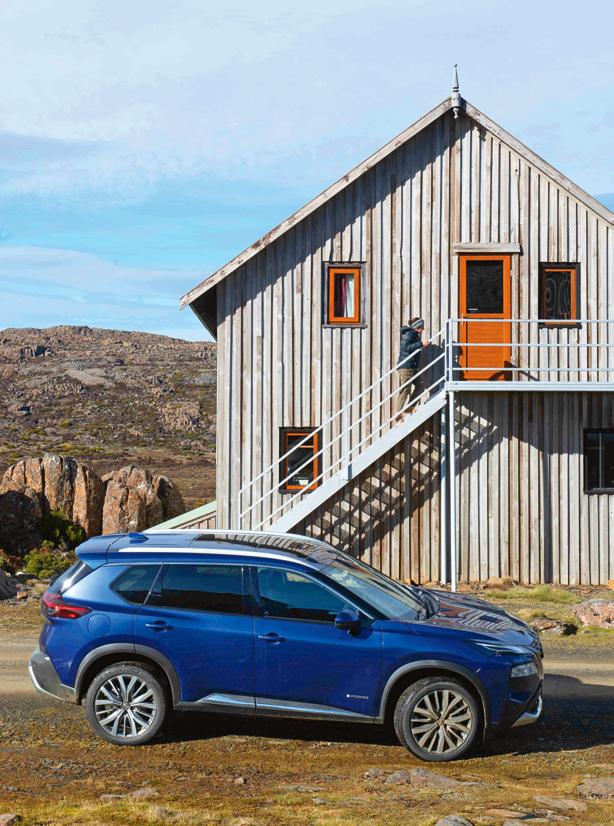
PRICING • Starting from $61,617 drive away depending on colour
BODY STYLE • Medium SUV
SEATING • 5 seats
FUEL CONSUMPTION •
X-Trail Ti-L (4WD) e-POWER (HYBRID) uses 6.1L/100km of ELECTRIC/PULP Combined highway/city
SAFETY • 5 Star ANCAP Rating
ENGINE TYPE • 1.5L turbo threecylinder engine with variable compression technology
BATTERY • 2.1kWh lithium battery (1.8kWh usable)
CHARGING/PLUG • The car’s battery is charged via the engine. The engine is connected to a motor-generator and inverter which is connected to the battery
RANGE • 900km per tank
TRANSMISSION • One speed automatic (CVT)
DRIVE TYPE • Electronic 4x4 system (e-4ORCE)
MAX. POWER • Power, kW @ rpm (front/rear) 150 / 100 ³
MAX. TORQUE • Torque, Nm @ rpm (front/rear) 330 / 195 ⁴ 0-100KM/H • 7.0 seconds
•Farm-gate shop
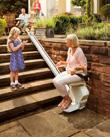
•Truffle hunting tours
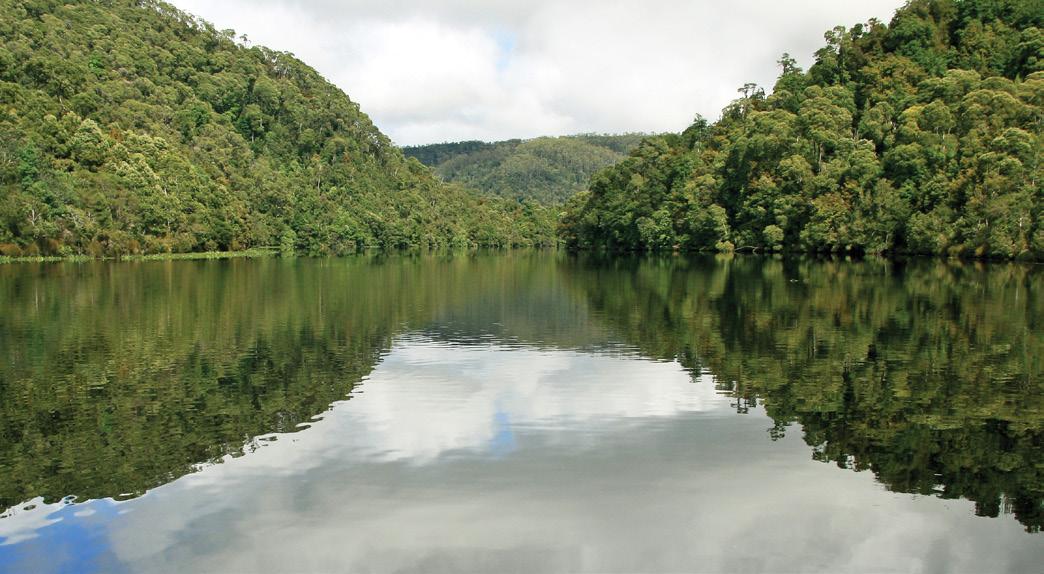






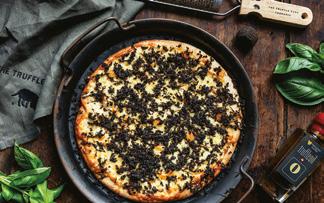
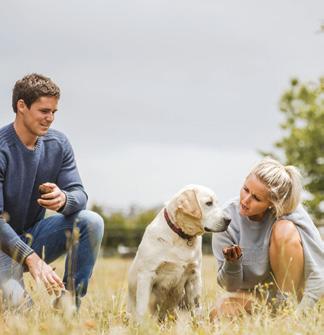
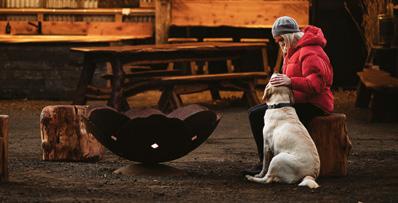
•Truffle products


844 Mole Creek Road, Deloraine, Tasmania Ph. 0437 849 283 thetrufflefarmtasmania.com.au
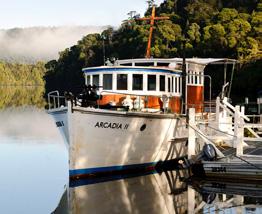
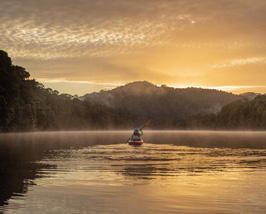
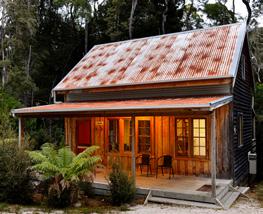
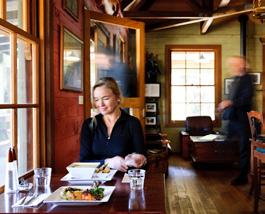




•Fresh truffles the_truffle_farm tasmanian_truffles

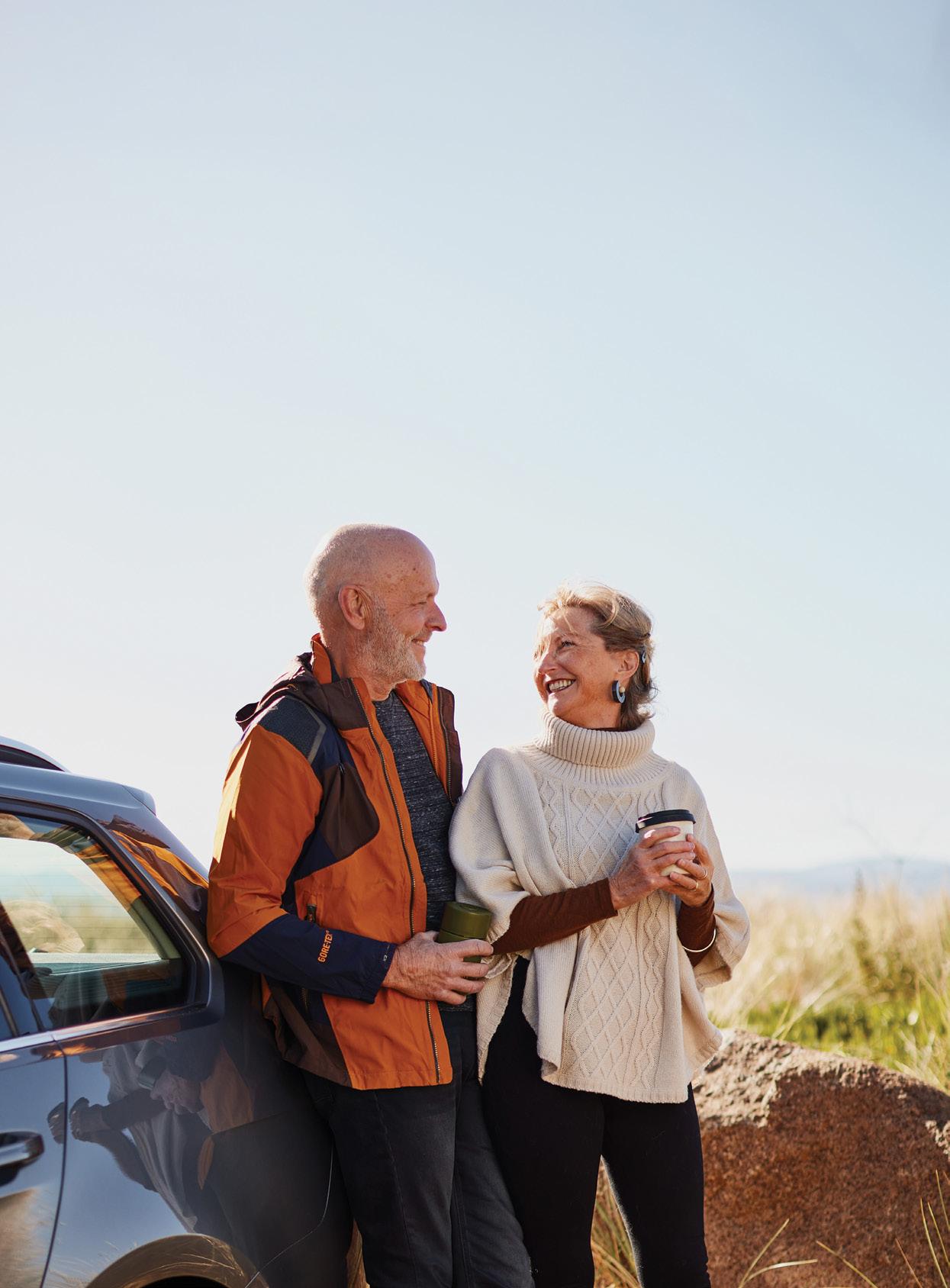


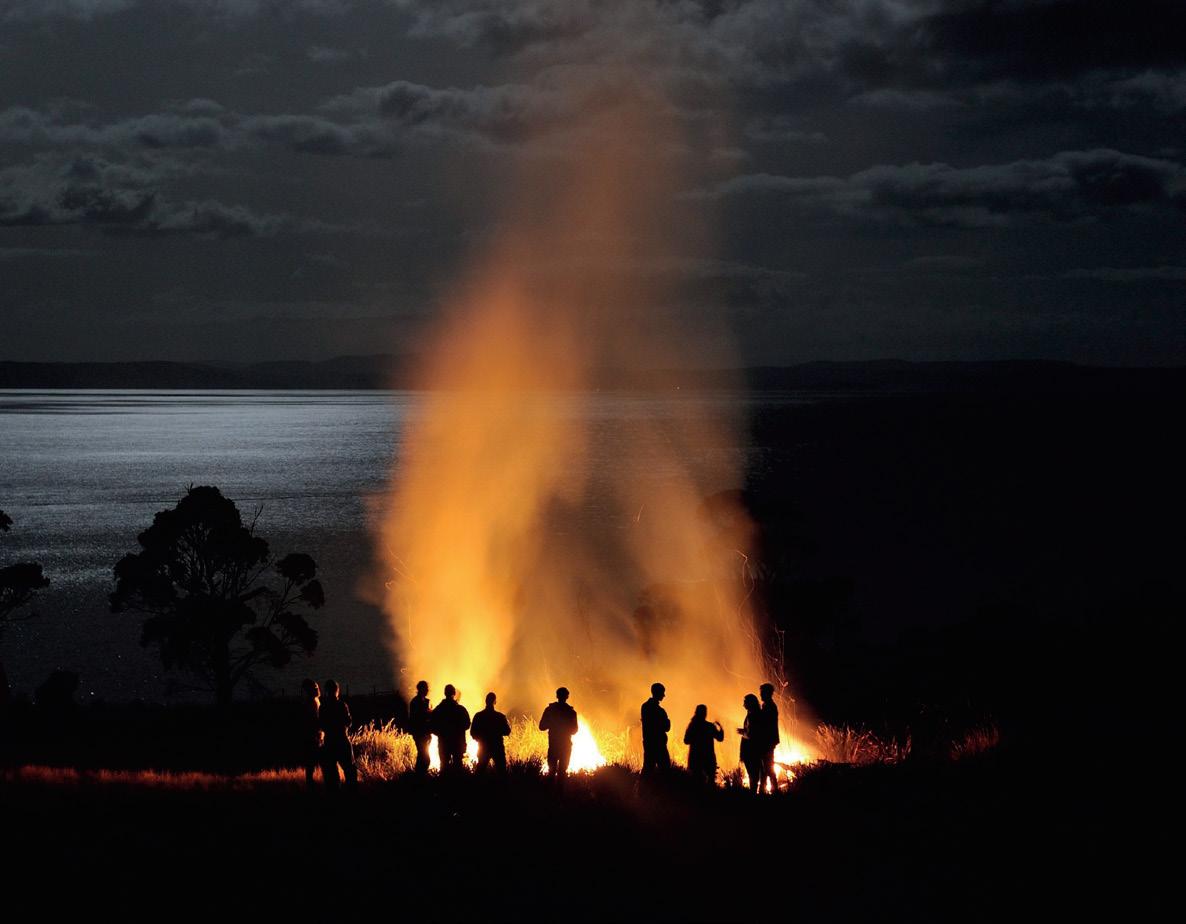
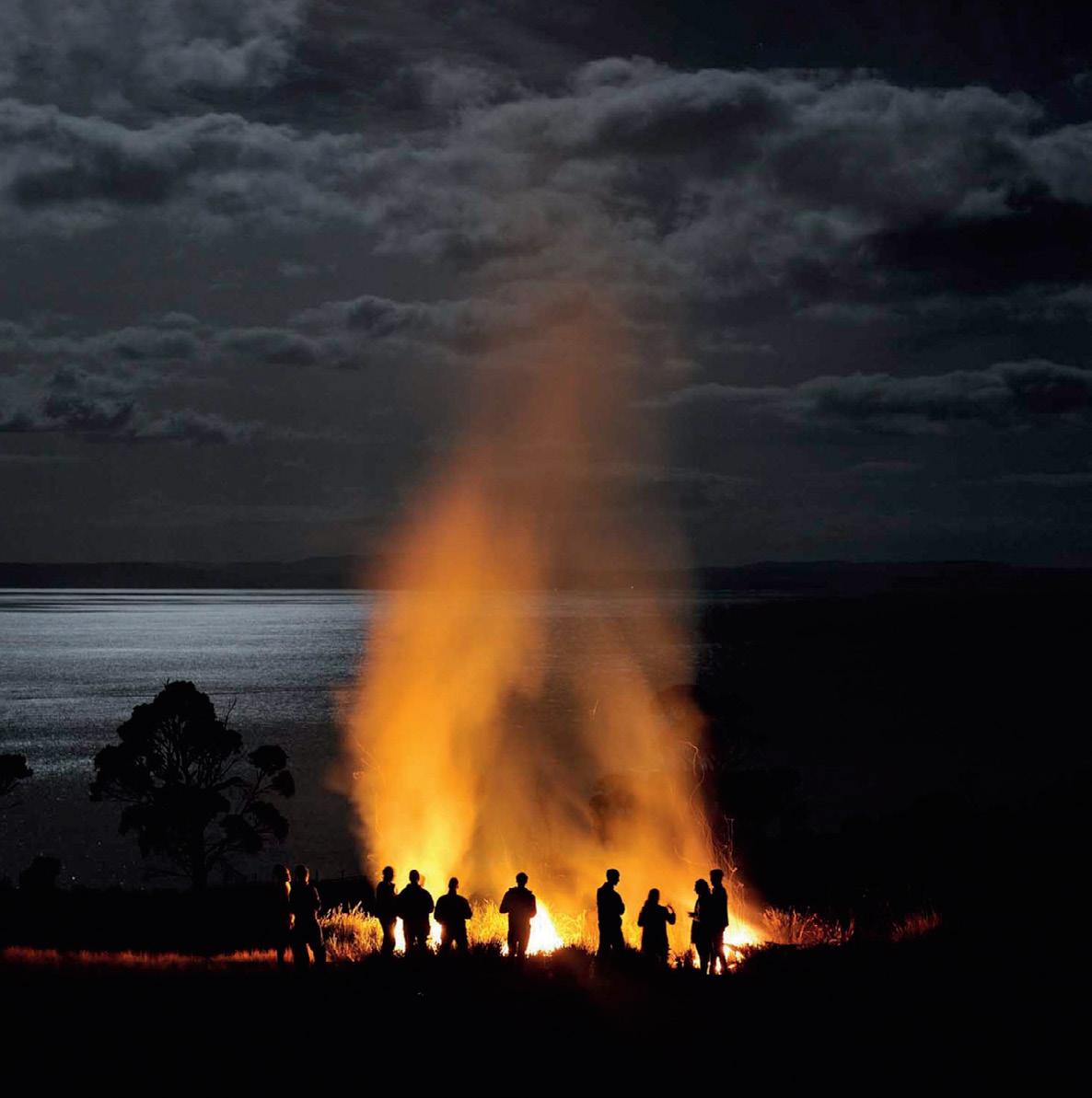
Tasmania only gets more Tasmanian in the Off Season. It’s a time when we don’t just endure the cold and dark, we live for it. If you want to wake up this winter, join us for Tasmania’s Off Season as we really turn it on. To celebrate RACT’s 100 years of service, Journeys has partnered with Tourism Tasmania to commission this special editorial feature and guide to experiencing Lutruwita/Tasmania.
When you live in Lutruwita /Tasmania
it‘s easy to forget what a big deal it is to be able to travel this island. A simple trip for us – like hiking up a mountain near our house or visiting rellies elsewhere in the state – is a bucketlist experience for many mainlanders and people living internationally.
From a seaside scallop festival to time in the Tasmanian Wilderness World Heritage Area, we’ve captured a range of experiences that encourage you to stick around this winter. Most can be relished solo or enjoyed with your bestie. Some are adults-only but most are family-friendly and great for groups.
As we travel and experience different parts of Lutruwita, it’s important to learn about Palawa Country and the connection, belonging and custodianship Palawa people have to these lands. Rather than only viewing Country as the physical environment or land,
Palawa and other Aboriginal people know Country as a deeply symbolic and significant being that includes people, plants, animals, seasons, story and belonging.
This winter season, we can take the opportunity to deepen our own understanding of, and connection with, this magnificent island. There are many ways to do that, but learning the island’s true history, and names of places and Palawa nations isn’t a bad place to start.
Winter conditions here can be dramatic and challenging. Being prepared,, even on a short jaunt, can literally be lifesaving. Ideally, always have spare dry clothes and blankets in the back of your all-wheel-drive.
1. Mull it over
On a winter’s morning the dark waters of the Huon are often glassy and misted. Sounds a bit nippy, but you can enjoy this scene from the enclosed cabin of a vintage vessel while cradling a complimentary cup of mulled cider. Now we’re talking. Huon River Cruises’ vessel, La Drone, takes up to 12 passengers on 90-minute trips from Castle Forbes Bay. This part of Taluna/ Huon River is within South East Nation.
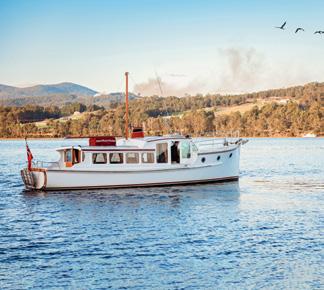
2. Branch out
Styx Tall Trees Conservation Area, near Maydena, protects forest supporting the tallest flowering trees on earth: Eucalyptus regnans or mountain ash. Today, less than 15 percent of these types of eucalyptus forests remain in Lutruwita/Tasmania. So gather your nieces and nephews, your kids and your grandkids, and take them there to appreciate not just the wow factor of these environments but their essentialness. Styx is on Big River Nation.
3. Slow to island pace
Four-kilometre walks are big on Bruny. One is to the dolerite magnificence of Fluted Cape and another through the rainforest of Mount Mangana to the island’s highest point of 571m. Grass Point Track is in South Bruny National Park, as is the island’s longest trail (18km) around Labillardiere Peninsula. Check ferry timetables for super saver tickets. On Lunawuni/Bruny Island, you’re on South East Nation. Members can save on Pennicott Wilderness Journeys through ract.clubconnect.com.au. T&Cs apply.
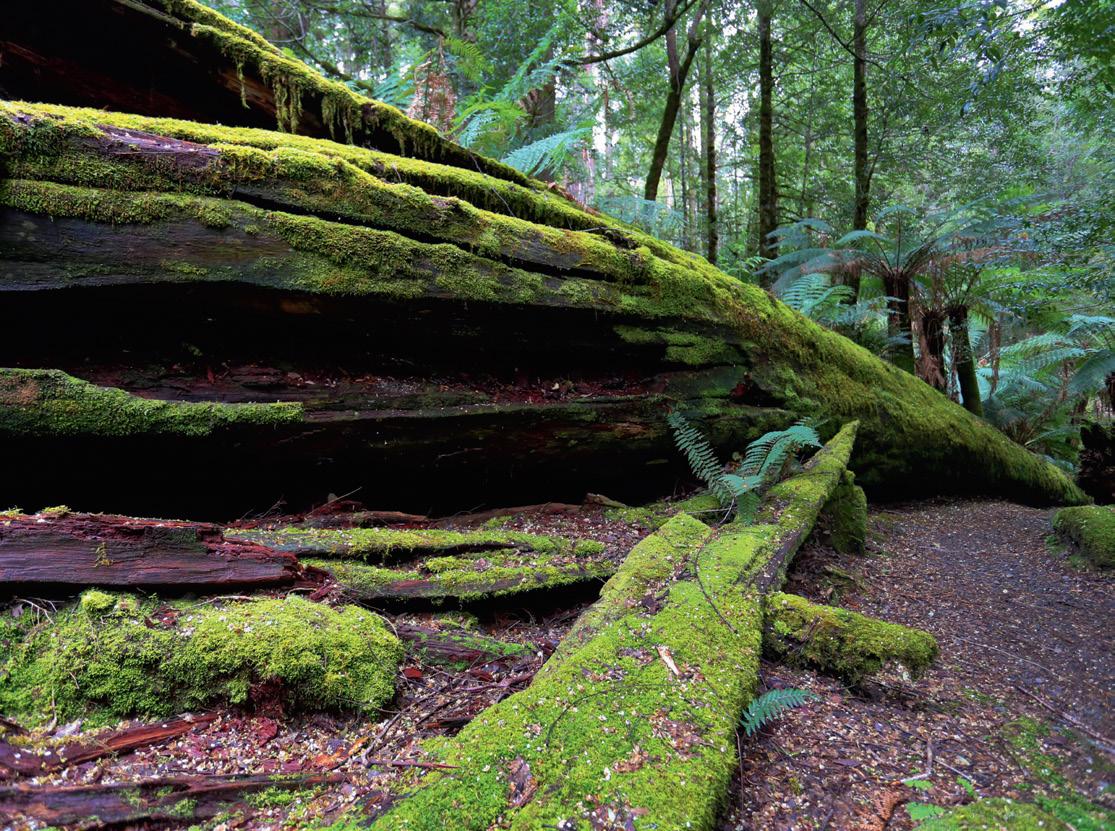
4. Track and field
Waterfalls in the rainforests of Mount Field National Park, such as Horseshoe and the fully accessible Russell Falls, can thunder down in winter. For something completely different, drive the 16km unsealed road up to Lake Dobson and walk into the alpine heathland via the ski fields. If the weather is suitable, continue hiking to the string of frozen glacial lakes on Tarn Shelf. When you’re at Mount Field, you’re on Big River Nation.
5. Village people
Richmond has oodles of Georgian architecture, as we know, but also a market every Sunday. “Only highquality handmade local products,” says organiser Gerard Webb. There’s often a food truck and Dave the harpist performing. Stay at Aquila’s adults-only off-grid glamping, which has woodheated cabins and an equal-access ecotent. Stay two or more winter nights and receive Coal River Valley pinot noir, cheese and chocolates. Richmond is on Oyster Bay Nation.
6. You belong to the city
Get a fresh perspective of your capital on takara nipaluna (walking Hobart), a 90-minute equal-access experience by Blak Led Tours. Joining the ranks of Salamanca Market and Farm Gate Market is Hobart Twilight Market at Sandy Bay and Franklin Wharf on certain Fridays. Upriver, at Piyura Kitina/Risdon Cove, there’s a new one-hour tasting tour called kipli takara (bush foods walk). When in Nipaluna/Hobart, you’re on South East Nation.
100 reasons to stay in Tassie this winter
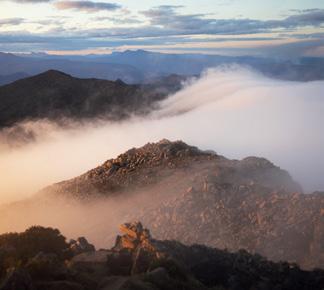
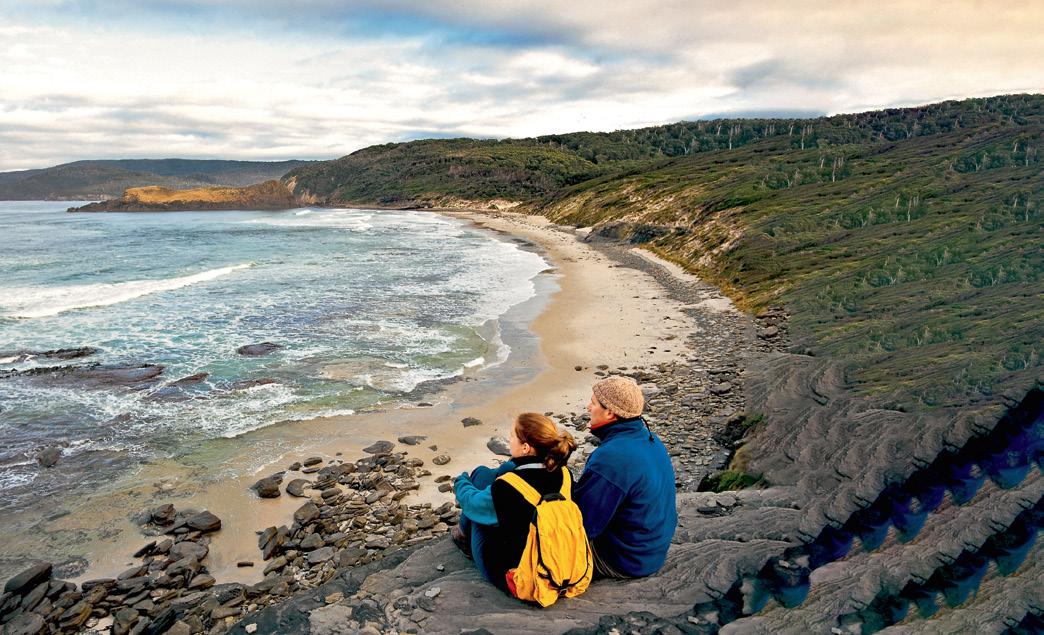
7. Tarn good day
On Hartz Peak Track, when snow has settled on the alpine heathlands, emerging from the trees into the open landscape is like walking from the wardrobe into Narnia. Pop something warm in a thermos to have at Lake Esperance or Ladies Tarn. Peak bagging Hartz Peak is more a summer activity unless you’re prepared for sub-zero howling-gale conditions from the pass. When in Hartz Mountains National Park, you’re on South East Nation.
8. Do go chasing waterfalls
Not far from the telephone box at the Besser-block community hall in Pelverata is a well-marked turn-off up an unsealed road to the trailhead for Pelverata Falls. Park and walk for about 3km alongside paddocks and through the bush to a lookout onto one of the longest waterfalls on the island. They cascade over a 114m dolerite cliff into the gorge so, after decent winter rainfall, prepare to be blown away on South East Nation.
9. Take it to the edge
Cockle Creek is the southernmost point of Australia’s public road network. An 8km trail leads you into Southwest National Park and through eucalypt forest, ferny gullies, open grasslands and stands of trees. This is the eastern end of the South Coast Track. Eventually you’ll cross a creek, smell the sea and emerge at black shale cliffs. Cockle Creek, on Laylatiya/Recherche Bay, and South Cape Bay are part of South East Nation.
10. Ewe should try this Grandvewe and Hartshorn Distillery in Birchs Bay have a treat for you this Off Season. The experience starts with a guided sheep-cheese and sheep-wheyspirit tasting. After that, you choose a blank 500ml bottle of vodka or gin, sit down with a hot beverage and your complimentary Hartshorn Distillery beanie, and decorate your take-home bottle. This one-hour tour is equal-access. In Birchs Bay you’re on South East Nation.
11. Drink in the view
Bangor Vineyard Shed in Dunalley is family-friendly, wheelchair-accessible, pet-friendly (outside only) and carbonnegative. “Our food is sourced from the land and sea around us,” says owner Matt Dunbabin. This winter, Bangor is offering a black-glass tasting – a 40-minute food and wine experience in a private room, designed to heighten and challenge your senses of taste and smell. Book online or on arrival. While in Dunalley, you’re on Oyster Bay Nation.
12. Take the long way home
Who knew that the 176km Midland Highway was called ‘the main road’ or ‘Hobart Road’ back in the day? It’s also called Heritage Highway for tourism purposes. Names aside, it’s our main north-south intercity commute route, but have you ever driven it for pleasure? Imagine dedicating a whole day or weekend to stopping at the little towns and villages you usually fly past, like Longford, Conara, Tunbridge and Jericho.
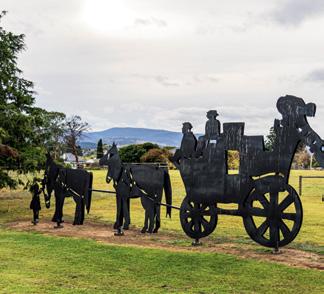
13. Tier it up
Before Snug River pours off a cliff, many other tributaries feed into its flow so, in the Off Season, it can be pumping. After rain or snow, the 2km track down to Snug Falls can be slippery so take care. Expect to cross paths with Snug locals and their dogs. It’s not a long walk but there’s no reason you can’t take your thermos and have a nice warm cuppa. This area is part of South East Nation.
14. See the light
Catching sight of nuyina /Aurora Australis – the southern lights – isn’t something you can count on but you can be proactive in seeking it out. The deeper it is into winter, the later it is at night, the further south you are, the bigger the skyscape and the higher the geomagnetic activity – there are apps for that – then the greater your chance of witnessing nuyina.
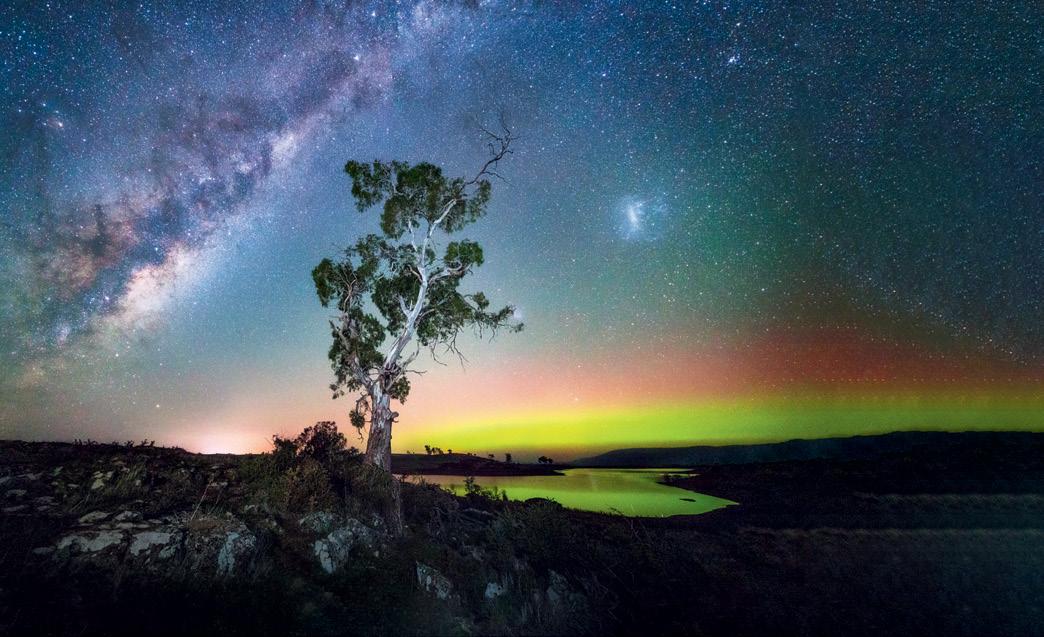
Imagine dedicating a whole day or weekend to stopping at the little towns and villages you usually fly past
15. Head in the clouds
The eroded dolerite intrusion overlooking Nipaluna/Hobart is magical in winter. At 1271m above sea level, seasonal snow often falls on Kunanyi/Mount Wellington, though when Pinnacle Road closes, you can still hike and bike along roads and tracks. At The Springs, halfway up, drink hot chocolate under a blanket around the fire at Lost Freight Cafe. Pakana woman Theresa Sainty tells us “Kunanyi was one of the first place words we revived”. The mountain is on South East Nation. Members can save on Mount Wellington Tours through ract.clubconnect.com.au.
T&Cs apply
16. Get a taste for something new
Even if you live in Nipaluna/Hobart, there are probably many places you haven’t eaten at yet because you’ve got your favourites. Understandable, but you should go to Moonah for Afghan cuisine at Zafira. The kabuli pulao is winter comfort on a plate. Also in Moonah you’ll find Nepalese restaurant Chulesi and the warm and welcoming Nara Thai. In Nipaluna/ Hobart, you’re on South East Nation.
17. Be on the lookout
Nununi woman Trukanini (1812-76), is honoured and remembered with a lookout in her name on her homeland of Lunawuni/Bruny Island. Truganini Lookout, at the island’s isthmus or The Neck, is a 20-minute drive from the ferry terminal. It’s nearly 300 steps up to a memorial plaque and views in every direction. Down at sea level are muttonbird and penguin rookeries to visit (only use red torches to view the birds). This is South East Nation.
100 reasons to stay in Tassie this winter
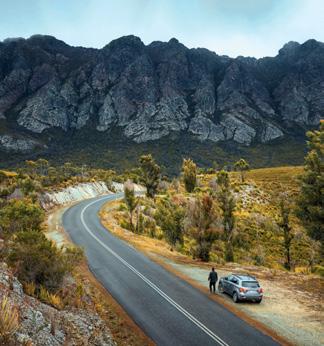
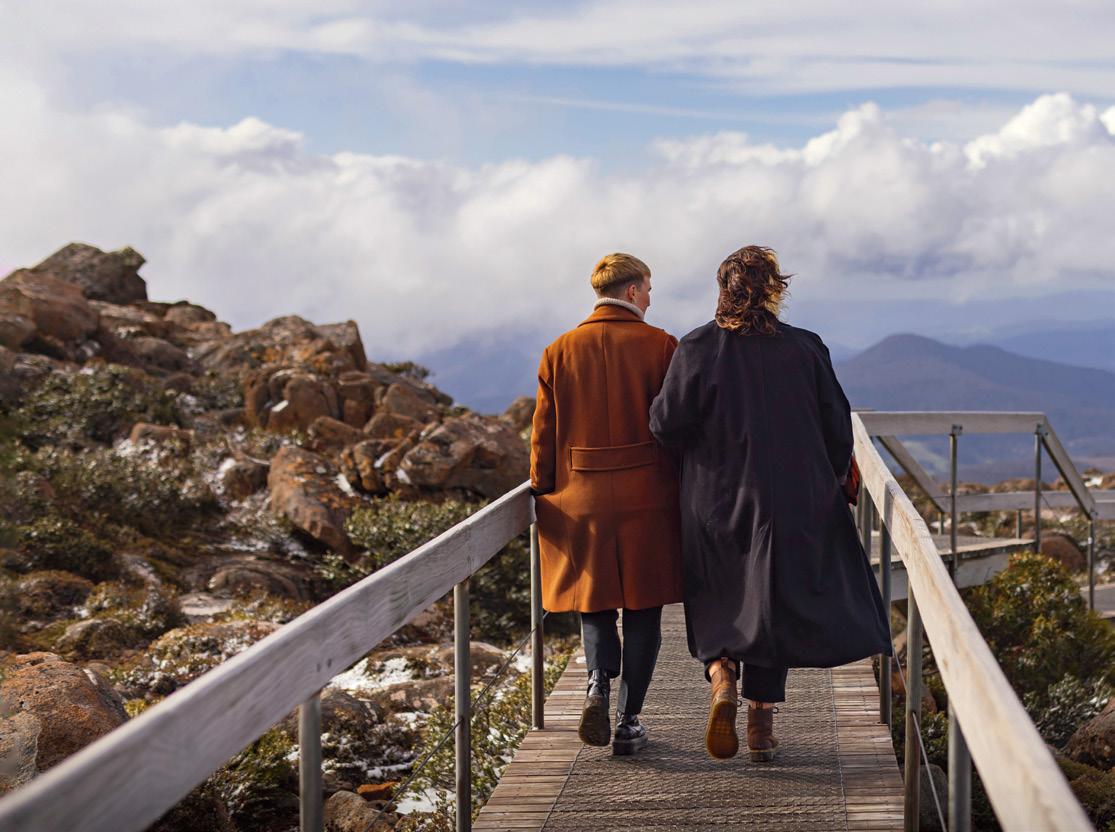
18. Road to somewhere
When Strathgordon was built in 1969 it rained every day for six weeks. Not a surprise as it rains on average 300 days a year there. Also not a problem because, near the end of scenic 119km Gordon River Road, you’ll find the fire-warmed Pedder Wilderness Lodge serving hot meals and warming spirits. Where the road terminates at Gordon Dam you can traverse the 140m-high wall. In this area, you’re on South West Nation.
If you’re in the Mount Field area without a Parks Pass or you want to see waterfalls in a natural setting but without the infrastructure or other people, it’s a 45-minute walk from the carpark in Tyenna to Marriotts Falls. Mid-year, the track can be quite muddy and there may be fallen trees across the rainforest trail. In that area, you’re on Big River Nation.
There are more antique stores in New Norfolk than you can throw a convictmade brick at. Start your antiques journey somewhere manageable like 20th Century Artifacts and work your way from there through the rest of the town’s antique stores. For time out, have coffee at the exquisite Black Swan Bookshop (closed Tues and Wed). Wulawali/New Norfolk is on Big River Nation.
While winter can be the best time for hiking here at lower altitudes, tenting can be brutal. Three Capes Track, in Tasman National Park, is a four-day/ three-night Parks and Wildlife hut-based route to the Southern Hemisphere’s tallest sea cliffs. When you’re visiting Tukana/Tasman Peninsula you’re on Oyster Bay Nation.
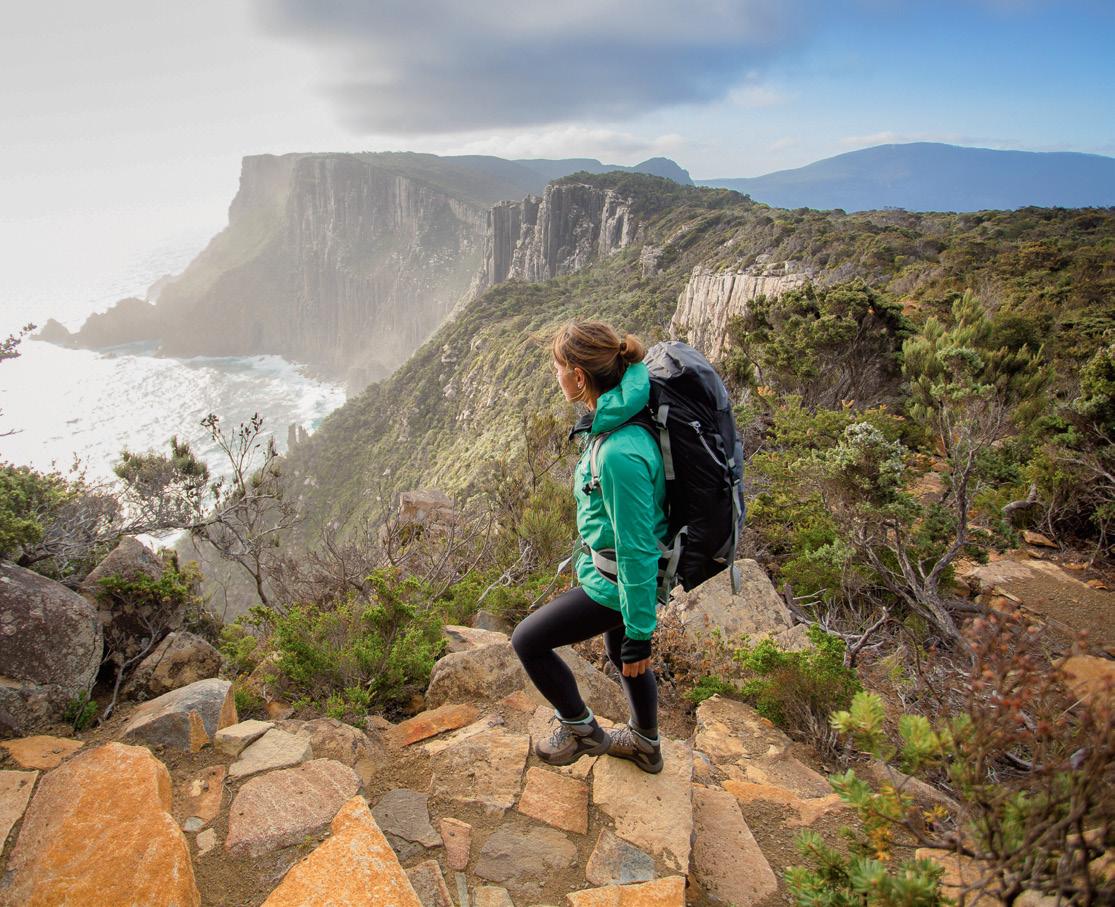
22. Get tunnel vision
Maingon Bay Lookout, south of Port Arthur, is an accessible viewing platform close to the car park from where you can scan the bay for migrating whales. There are more than 100 steps down to another viewing platform for Remarkable Cave where, on an incoming tide with decent swell, you will get sprayed. If that leaves you wanting more, walk to Maingon Blowhole (90 minutes return). While travelling Tukana/Tasman Peninsula, you’re on Oyster Bay Nation.
23. Karst your eyes
Junee Cave and State Reserve are just a few kilometres from Maydena. Take an easy 10-minute walk along a forestry road and a stunning rainforest track to the entrance of the cave. Here, Junee River surfaces after a 30km subterranean journey through nearly 300 caves. Fun fact: Australia’s deepest known cave is here in Niggly-Growling Swallet cave system. Around Maydena you’re on Big River Nation.
24. Winter springs
A short walk from Hastings Caves Visitor Centre can see you lolling in a thermal pool surrounded by tree-ferny forest. At 28 degrees Celsius it’s not hot but, on a chilly day, far warmer than the air temperature. Nearby are picnic tables and an open fire in an undercover area where you can warm up afterwards and relax over a barbecue lunch. Hastings Caves State Reserve is part of South East Nation.
100 reasons to stay in Tassie this winter
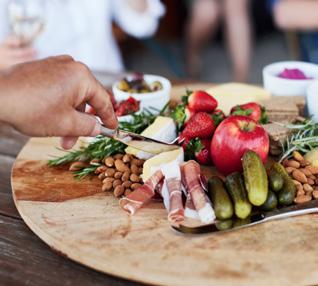
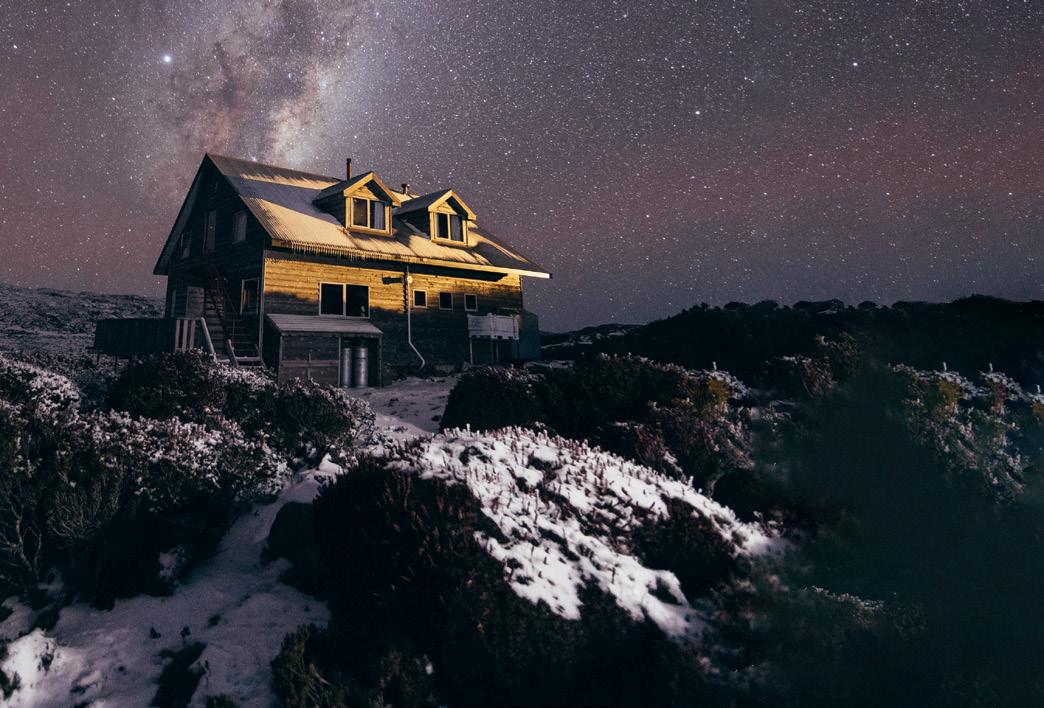
25. Live on the land
Curringa Farm is a 300ha property in Hamilton that owner Tim Parsons says is “much more than the typical hobby farm”. There’s cottage and studio accommodation, including equal-access Blue Wren, and you can get barbecue hampers or self-cater. Stay two nights or more this winter and receive a $35 bottle of wine or lanolin hand cream. Around Hamilton, where Lukina Minanya/River Clyde flows, is Big River Nation.
26. Ben there, done that
Did you know that Legges Tor (1572m), in Ben Lomond National Park, is the island’s second highest peak? The park also has one of the state’s few ski fields so you can ski, board, toboggan or cross-country ski. This Off Season, there’s a Winter Wonderland Ski Package. Collect skis or a snowboard from the Ben Lomond Base and set off for a day. Ride the ski lifts and spend time on the mountain. Turapina/ Ben Lomond and surrounding area is on Ben Lomond Nation.
27. Fly high
Ever done a guided zipline? Hollybank Treetops Adventure in Underwood has a six-line course with the longest one at 400m. You don’t need experience; everyone is fitted for gear and trained before flying over the forest valley. The only age limit is that kids can’t be under three. When choosing your winter ziplining outfit, be sure to factor in wind chill. Here, where Rupila Mangina/Pipers River flows, is North East Nation.
Legges Tor, in Ben Lomond National Park, is the island’s second highest peak.
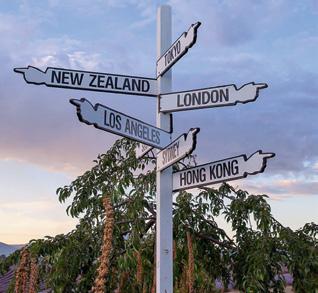
28. Sunday best Evandale Market is Tasmania’s longestrunning village market. Known for antiques and secondhand-book stalls, this extensive market also sells fresh produce, crafts, preserves, plants, everything. It’s at Falls Park every Sunday 8am-1.30pm, indoors and outdoors, even in winter. “We brave the weather,” says Ginni Woof, sister of the market’s long-time organiser, Peter. At Evandale, Plipatumila/South Esk River passes through and North Midlands and Ben Lomond Nations meet.
29. Feast your eyes
There’s nothing like a good country-town bakery but Cressy’s Rustic Bakehouse really takes the cake. Expect to audibly gasp the first time you walk in. The pastries, decorated doughnuts and iced muffins taste as good as they look. Enjoy super-friendly staff, outdoor seating in the full sun or plenty of indoor seating – all warmed up by the on-site baking. Tinamirakuna/Macquarie River flows near Cressy.
Although the time to see lavender in full bloom is summer, there are benefits to visiting Bridestowe Lavender Estate in winter. There’s no gate charge, for starters, and there’ll probably be a fire going inside. You can take a private behind-the-scenes guided driving tour or do a workshop to craft your own take-home lavender fragrance. Nearby, Pulawuta Napina/Little Forester River passes through this part of North East Nation.
Brady’s Lookout Cider, in Rosevears, brings back its Embrace the Dark cider tasting experience this winter but with extra. Over the two hours you will have a cider mill tour and a sensory tasting, but you’ll also make a couple of bottles of your own Méthode Traditionnelle cider to take home. Only for adults, and fully accessible. At Rosevears, Kanamaluka/ Tamar River flows through Northern Midlands Nation.
Launceston was designated a UNESCO City of Gastronomy in 2021, of which there are only around 50 in the world to date. This recognises that the city and surrounds, with more than 150 food producers and more than 200 eateries, are exceptional food regions by global standards. This Off Season, if you can, treat yourself or others to local leatherwood honey, fresh wasabi, French black truffle, clotted cream, Angus beef, wild abalone and juicy wallaby fillets from Lenah Game Meats. Members can save 10% off the best available rate at the time of booking at Hotel Verge. T&Cs apply.
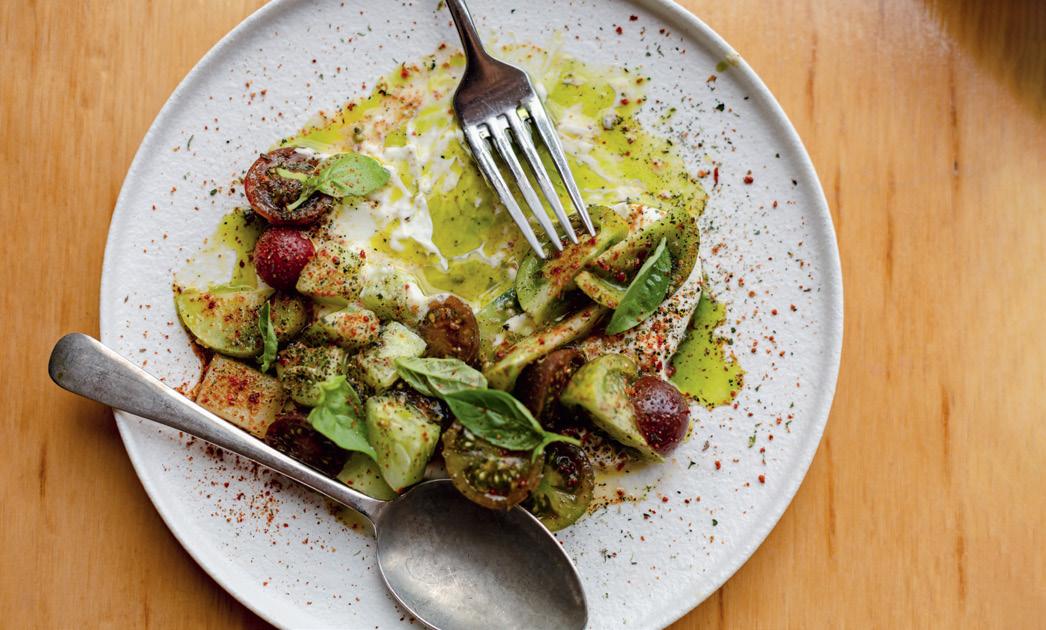
Although the time to see lavender in full bloom is summer, there are benefits to visiting Bridestowe Lavender Estate in winter.
Close to Derby and Gladstone is the very photogenic Little Blue Lake. It’s been elevated to tourist-attraction status but, keep in mind when you’re posting photos, it isn’t a natural phenomenon. This big old unrehabilitated mining hole has filled up with water that is bright aqua because it’s low-key toxic. High mineral levels render the water unsafe so please don’t swim in it. This beguiling scar is on North East Nation.

Are you keen for some outdoor adventures this winter but don’t have the skills, the knowledge or the gear? Wild Tamar, based in George Town, will do what it takes to get you active and loving life in the North Tamar region. Only 35 minutes from Launceston, Kinimathatakinta/George Town and the surrounding country is ideal for river or ocean kayaking, mountain biking, fishing, scuba-diving wrecks, skydiving and spotting seals and penguins.
Scottsdale has fabulous free-range pork and a top microbrewery, but also the scenic 26km North East Rail Trail stretching southwest from there to Tulendeena. The trail has views to mountains and farms but also passes through lush forested sections. The gravel surface is a fine enough grade for touring and hybrid bikes. Bicycles, including e-bikes, can be hired at Scottsdale’s art gallery. You’ll be travelling across North East Nation.
Deloraine’s Truffle Farm Tasmania invites you to get down this winter for a fun fungi experience that’s nearly two hours long. After hunting on hands and knees for the little fruiting bodies, everyone warms up around the fire pit tasting various truffle products, eating truffle-topped pizza, toasting marshmallows and sipping Tassie wine or beer. Deloraine, where Wayarupi/ Meander River travels through, is part of North Nation.
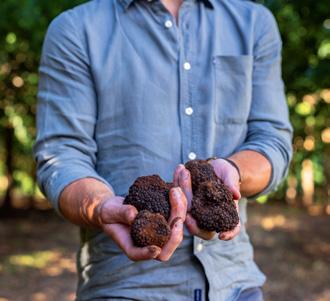
If you’re keen to see wildlife in its natural habitat this winter then head to Narawntapu National Park. Kangaroos and wallabies graze from dusk to dawn on the marsupial lawn at the visitor centre. You may even spot a Tasmanian devil. There’s an abundance of bird life so spend time there caravanning, camping, hiking and wandering the sand flats. Narawntapu/country between Badger Head and West Head is on North Midlands Nation.
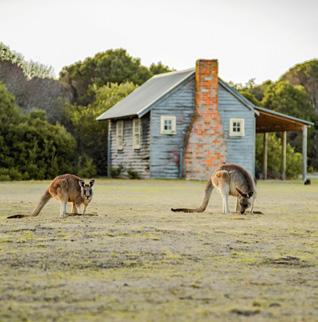
Mountain biking is a warming and endorphin-releasing activity so, this winter, head to Blue Derby where there are more than 125km of trails for all levels of skill and experience. They’re all free to use. Note that Blue Tier and Big Chook trails are closed for most of July and August. You can bring your own gear or hire bikes in town. These trails are on North East Nation.
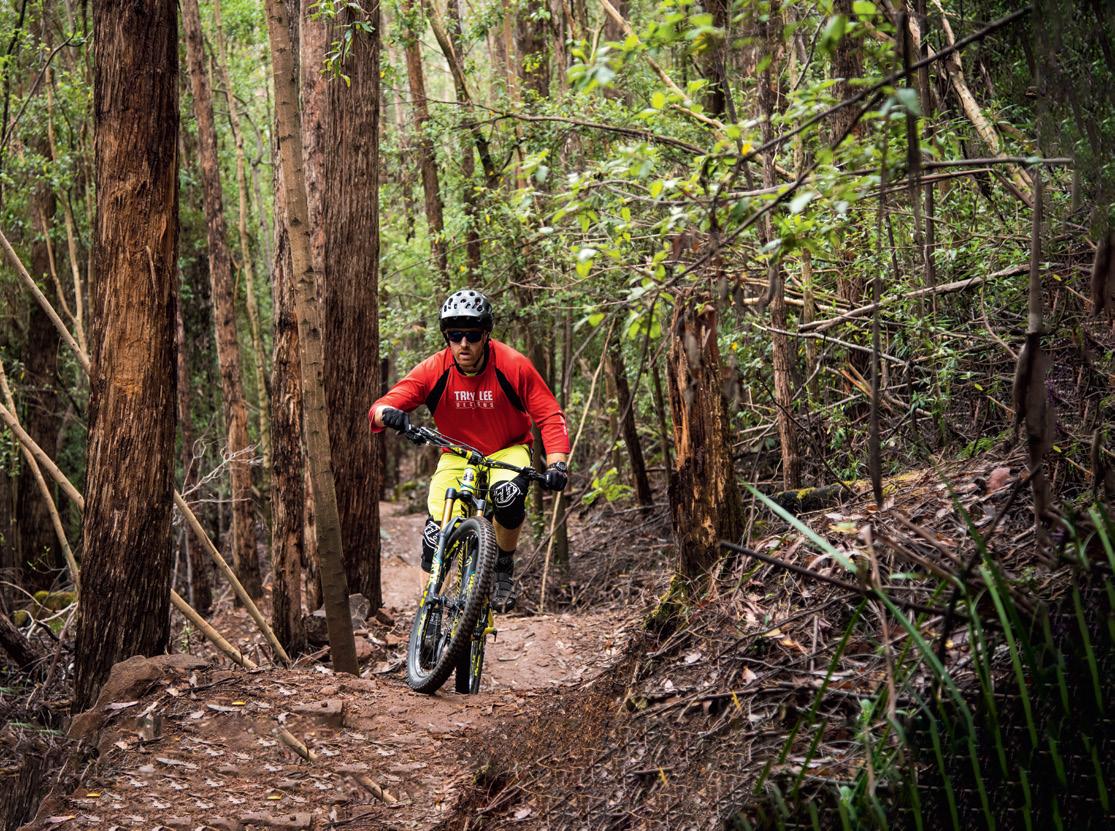
There are many exceptional walks in Meander Valley and Meander Bridge Cafe is a lovely stop. For a hike that’s challenging and rewarding, Meander Falls Track is 10km return alongside the river, or take Split Rock Track (not clearly marked) back to make it a loop. Weather permitting up on the Central Plateau, there’s an accessible boardwalk to Pine Lake that winds between gnarly pencil pines. In these mountains where Wayarupi/Meander River begins, you’re on North Nation.
You’ll smell Turkish Tukka’s charcoal grill well before you reach the restaurant on George St in Launceston. “We serve traditional Turkish dishes. We make everything here in the shop, everything fresh,” says owner Yusuf Karazor. From this beautiful casual restaurant and takeaway space, he serves dishes he was raised on as a child. Everything is mouthwateringly delicious, but make sure you try a wrap and the baklava.
Spend a few hours at Trowunna Wildlife Sanctuary in Mole Creek, where there’s onsite forest and natural habitat. Three daily interactive tours, included in the entry fee, feature Tasmanian devils, quolls and wombats along with education about Trowunna’s breeding programs. “Since the 1980s,” owner Androo Kelly says, “we’ve bred devils under stud conditions for 22 generations.” Private tours are available. Mamulipi/Mole Creek, the town, is on North Nation.
The REASSIGN project for the Northern Midlands highlights specific colonial estates and buildings through the retelling of tales from the time of British settlement following invasion in 1803. There are palawa perspectives included but, in most cases, you’ll need to read between the lines to realise what many of these so-called characters were really getting up to in their pursuit of empirebuilding on stolen land.
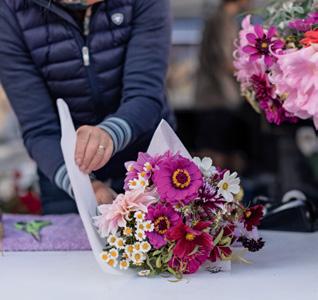
At Harvest Market Launceston, stay warm on a chilly morning by eating freshcooked comfort food. Bolani Stall fries up handmade potato-stuffed Afghan bolani while Seoul Food specialises in sweet and savoury Korean pancakes. Grab a coffee from Ritual when you have a spare hand. Take home seasonal fruit and veg, handcrafted cheeses, ethically produced meat, grainy bread, tasty pastries, and even some cider, wine or mead.
44.
Although Aboriginal-owned and -guided wukalina Walk doesn’t run in winter, you can make your own way to the 216m-high granite summit of Wukalina/Mount William, which is often decorated with Tasmanian devil scat. There are 360-degree views of the area from up there. In the open coastal heathland, further into the park, is where you’re more likely to spot kangaroos, wombats, echidnas and wallabies. Around Wukalina/Mount William National Park you’re on North East Nation.
Have you ever walked to Cataract Gorge from Launceston CBD? Although nature is the gorge’s main attraction, especially Plipatumila/South Esk River, highlights along the way include the restaurant, suspension bridge, old power station with interpretation centre and 1972 chairlift –its central span of 308m is quite possibly still the world’s longest single chairlift span. The self-guided 5km loop from Kings Park takes two to three hours. Cataract Gorge Reserve is wheelchair accessible.
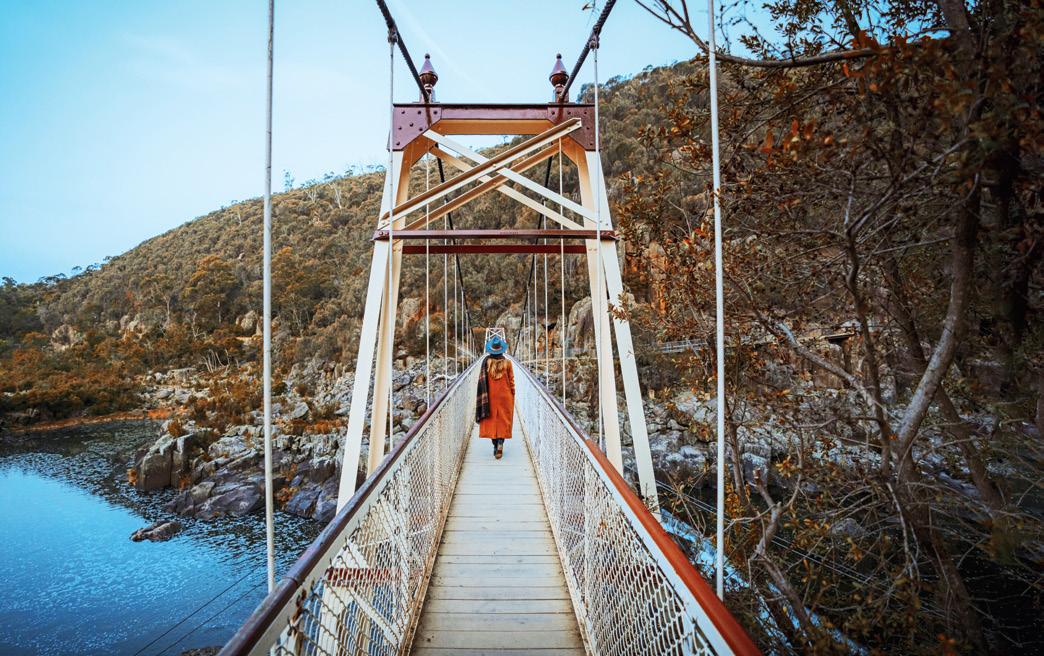
100 reasons to stay in Tassie this winter
At Harvest Market Launceston, stay warm on a chilly morning by eating fresh-cooked comfort food.Take a hike 45. Take me to the river
In many parts of Australia, a scallop is the neck of a blouse or a deep-fried potato cake. Here, there’s a festival dedicated to the marine bivalve mollusc. After a few years on ice, Tassie Scallop Fiesta in Bridport is back for another fingerlicking good day (30 July). Come for the music, wine masterclass, chef demo, pie judging and competitive scallop splitting. Bridport, where Pulawuta Napina/Little Forester River meets the sea, is on North East Nation.
Get over to Flinders Island for walking, biking, fishing, snorkelling and diving, but also sleeping in, staring out to sea and wildlife watching. Furneaux Museum in Emita is worth a visit. Walk up Mount Strzelecki, the island’s highest and often misty peak, which takes four to five hours return. Book a winter week at Sawyers Bay Shacks and car hire costs will be covered. Flinders is part of Tayaritja/ Bass Strait Islands.
Calling all bird nerds, avian appreciators and people who like to picnic in interesting places. Get on down to Tamar Island Wetlands, just a few kilometres from Launceston’s city centre. In the interpretation centre you’ll learn a lot about these vitally important ecosystems. You can also do a 4km return walk to Tamar Island, on Kanamaluka/Tamar River, along a wide boardwalk. Expect to be observed by pelicans, cormorants, swans and maybe sea eagles.
From the beaches of Musselroe Bay you can look out to Tayaritja/Bass Strait Islands. It may not be swimming weather but there’s always birdwatching, walking and bream-fishing opportunities at Little Musselroe Bay. These beaches do have strong currents, rips and reefs so check with locals if you’re planning on surfing or swimming. The camping area is closed in winter. Layrapinthi/country at Mussel Roe is on North East Nation.
There are more than 30 vineyards in the Tamar Valley, mainly on the western side of Kanamaluka/Tamar River. You couldn’t make a dent in that many in a day, but what about working your way through them over a winter of weekends?
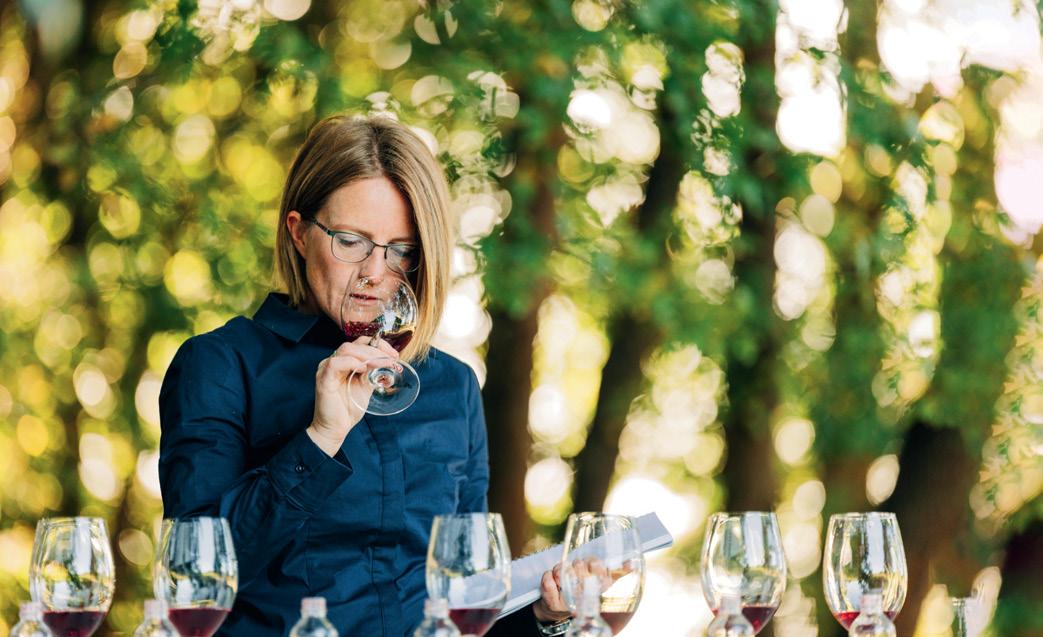
To find and book special Off Season offers from wineries and more in this region, head to www.discovertasmania.com.au.
Members can save on Tamar River Cruises through ract.clubconnect.com.au. T&Cs apply.
Commercial tourism may be booming in Tasmania these days but Henty Dunes are still providing free amusement 24/7. Just let the kids loose with their boogie boards and/or flattened cardboard boxes. For a good long beach walk, drive to Ocean Beach Lookout and go from there. This is Timkarik/country north of Macquarie Harbour including Strahan. Members can save at Strahan Village through ract.com.au. T&Cs apply.
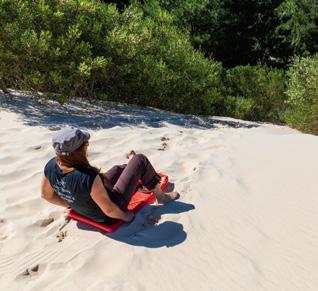
Seeing snow in Lutruwita/Tasmania is never guaranteed but your chances increase with every winter visit to Cradle Mountain-Lake St Clair National Park. Walk to Dove Lake if conditions are stable or do some shorter forest walks outside the park behind Cradle Mountain Lodge, where you can drop in afterwards for a fireside drink. Wulinantikala/Cradle Mountain is on Big River Nation. Members can save at Cradle Mountain Hotel, head to ract.com.au for more information.
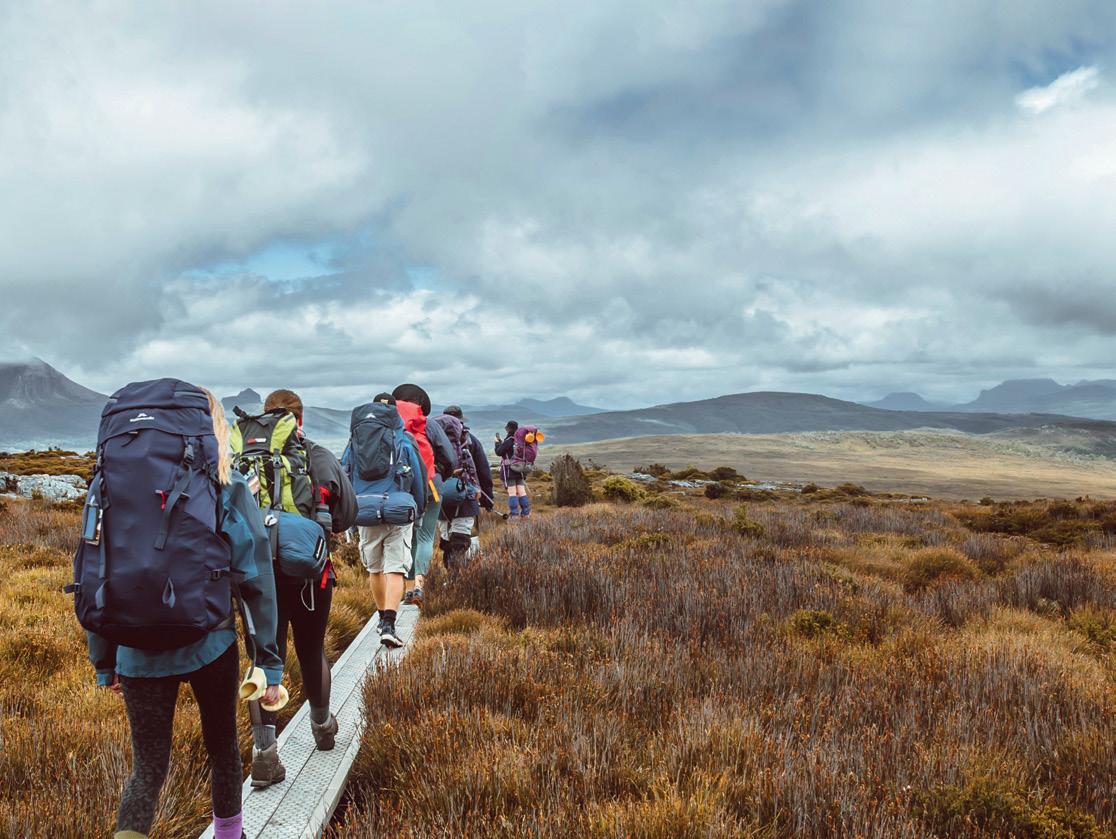
The water at Boat Harbour Beach is notably colder than nearby Sisters Beach and the wind can really hit that cove. Go for a brisk walk or an icy plunge if that floats your boat. Or just park your car facing the water with the windows up listening to the hits of your favourite decade. When you’re hungry, get over to Seekers Bar and Cafe. Boat Harbour is part of North West Nation.
You honestly can’t make this stuff up: there are miniature goats you can cuddle and pat at Hideaway Farmlet in Penguin. The farmlet also has free-ranging chickens and Wiltshire horn sheep. Hideaway’s 90-minute Sunset Sessions during winter, when goat coats are even fluffier, also include hot chocolate, Tasmanian whisky and marshmallow toasting around the fire. Penguin is on North Nation.
Drop in at Cradle Mountain Lodge afterwards for a fireside drink.
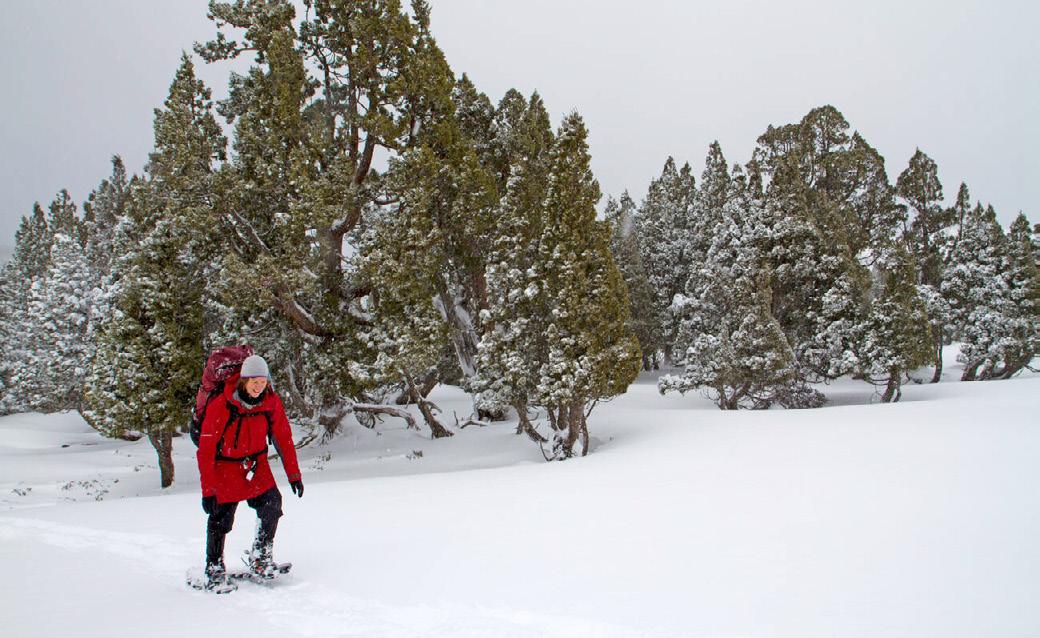
55. Celebrate change
Queenstown has been reinventing itself since before Mount Lyell mine closed down, but is trying to maintain and celebrate its unique identity. We’re invited to be part of this evolution so stay a couple of nights and go mountain biking, dine at The Empire, see a show at The Paragon, take in the street art and galleries, do a RoamWild Tour and hang out in the town’s first wine bar: Moonscape.
56. Take a hike
It’s an 11.5km return hike through cool temperate rainforest to Montezuma Falls, which drop 104m down a treed cliff face. In terms of effort-to-reward ratio, you won’t be disappointed. You can hike or bike from Williamsford along a former tramway route. Although the track only has a few steep sections, it can take three hours to hike there and back. Carry wet-weather gear because you’re on the West Coast.
Ever thought of having a wintery week on King Island? Martha Lavinia has arguably some of the world’s best surfing waves and, in winter, the prevailing winds generally come from the south-west making Martha Lavinia and Colliers the best surf spots. Golfers, you’ll be teeing off on a seriously scenic course at Ocean Dunes, which stays open in the Off Season even though conditions can be hit and miss.
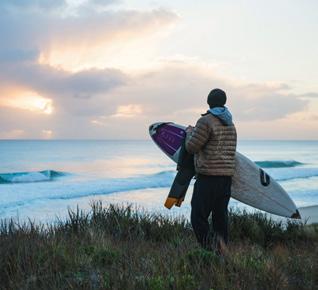
58. Connect with nature
The extensive Takayna/Tarkine has a coastline, eucalyptus forests, heathlands, button-grass plains, waterways and cool temperate rainforests of sassafras, leatherwood, myrtle, celery-top pine and tree ferns. These rainforests support more than 60 species of fungus and protect many rare birds, animals and even forms of lichen. Take the Tarkine Drive this Off Season between Marrawah and Trowutta.
You don’t need to be a cross-country skier to, at the very least, poke your head into Walls of Jerusalem National Park this winter. This glorious alpine landscape, dominated by towering fluted dolerite, transforms under snow. Even just putting on your boots and starting the walk is utterly awe-inspiring, and deceivingly easy to begin with. This park, that Tulaminakali/Mersey River flows through, is on Big River Nation.
Queenstown has been reinventing itself... but is trying to maintain and celebrate its unique identity.59. Hit the wall 57. Get offshore
60. Embrace the journey
A road trip to Queenstown, no matter what direction you’re travelling from, is a scenic experience. When coming from Nipaluna/Hobart, stop for lunch at Derwent Bridge Wilderness Hotel for the food, fire and good atmosphere. Making your way to Queenstown from the North West, especially if you haven’t seen those bare peaks for a while, will take your breath away. Be prepared for snow and ice.
Whether you’re road-tripping on the Tarkine Drive, staying at Corinna or campervanning the North West or West Coast, make sure you stop off at the mouth of Arthur River. This place is also known as The Edge of the World. Winter swells and heavy rains create dramatic scenes of fresh rushing water coursing into the rolling ocean. The mouth of Maytim/Arthur River is in North West Nation.
62. Horse around
Five kilometres from Queenstown, on that crest where Mount Lyell and Mount Owen’s shoulders meet before you head down towards Gormanston, find a park (it won’t be hard). On one side of the road is Iron Blow Lookout and, on the other, a 500m-long raised metal walkway leading to a lookout onto Horsetail Falls. Sometimes just a trickle in summer, water really gallops down that 50m drop during the wet West Coast winter.
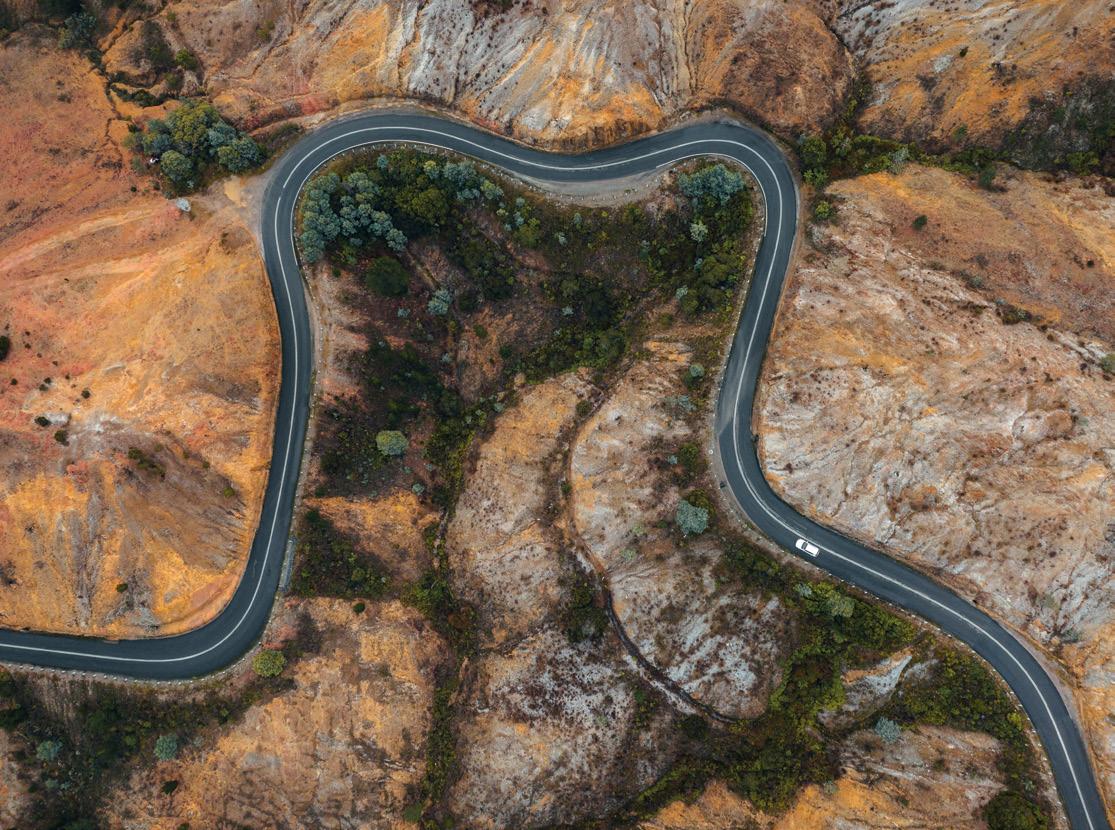
63. Keep it fresh
Oyster lovers and late bloomers (aka those who are yet to be converted), drop in to Tarkine Fresh Oysters in Smithton. The cafe and store is, says owner Jon Poke, “purely for the enjoyment of meeting tourists and locals and providing you with the freshest oysters you’ve ever had”. This winter, order half a dozen or more and say “Off Season” to get them shucked at your table. Open 11am-2pm Mon-Sat. Oysters are harvested from Riya/Duck Bay in North West Nation.
64. Rock and roll
Mountain biking has well and truly made it to the West Coast. If you like a physical challenge and interesting weather then head there this winter for some gnarly routes that will take you on a journey both physical and psychological. Queenstown and Zeehan’s expanding networks offer everything from beginner trails along rocky ridge-tops to steep and highly technical black-diamond single-track of loosely compacted gravel.
65. Retreat to the bush
Tarkine Hotel and the self-contained cottages of Corinna are in a bushland setting beside the Pieman River. There are plenty of things to do around there in winter. Go fishing, walk to Whyte River and Savage River, travel on the world’s only operating Huon-pine river cruiser or go kayaking. Corinna’s twin cottage, the hotel, Pieman River Cruises and Huon Pine Walk are all wheelchair accessible. The name of the area is Kurina/Corinna.
66. Stand on the table
Take the scenic Tollymore Road to get to Table Cape, a 12-million-year-old volcano standing 180m high on the edge of Bass Strait, only a few kilometres from Wynyard. On a clear winter’s day you can see all the way to Low Head. You can drive up to both the wheelchairaccessible lookout and to the lighthouse plus there’s a walking track connecting them. At Tuynplinuk/Table Cape you’re on North West Nation.
67. Go child-free
Gordon River begins in the central highlands and runs for 185km all the way to Paralungatik/Macquarie Harbour. As most people know, you can cruise from Strahan up into this breathtaking natural environment. This Off Season, for every adult ticket you buy to cruise Gordon River on Spirit of the Wild, one child cruises for free. See discovertasmania.com.au for details. Members can save on Gordon River experiences through ract.clubconnect.com.au. T&Cs apply.
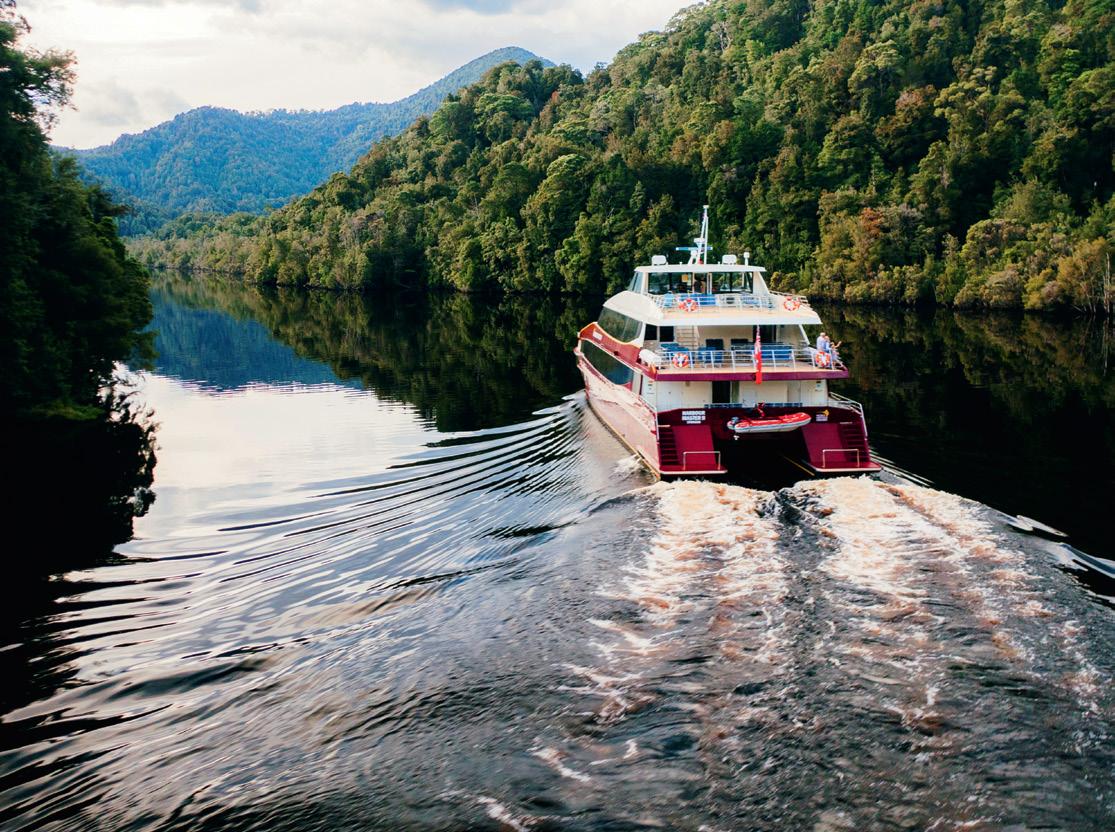
68. Tour by lamplight
Sarah Island, on Macquarie Harbour, is a perfect example of the British Empire’s historic knack of commandeering sublime natural locations to create environments of absolute misery. Visit Langarirruni/Sarah Island with the local, family-owned business, World Heritage Cruises, on its Heritage Morning Cruise. It takes in the sights of Macquarie Harbour, Sarah Island and the Gordon River with a 20% discount this Off Season when you book main deck seating aboard the vessel Harbour Master II
69. Embrace the dark
Some of our best early memories have glow worms in them so take your kids and your inner child to Zeehan Spray Tunnel. This high-ceilinged, 100m-long tunnel was hand cut to allow a train to pass through to move silver-rich ore. The tunnel is straight so you’re never completely in the dark, but only use a red torch if you need one as that’s less disturbing to all the bioluminescent creatures.
You can cruise from Strahan up into this breathtaking natural environment.
The English-style agriculture and colonial architecture around Mole Creek can lull you into thinking it’s a moderate landscape. But an extensive karst system, ancient sandstone and Jurassic dolerite intrusions mean there’s a lot of geological drama. For guided tours, book in with Wild Cave Tours to experience these subterranean caves coming to life in winter with waterfalls and reflection pools. This area, where Tulaminakali/ Mersey River flows, is North Nation.
The Vault is a cafe by day and a bar and restaurant by night. This repurposed Wynyard bank with its cosy booths and friendly staff is fully accessible. It serves craft beers, prioritising North West makers, and premium Tassie wines. “We do pride ourselves on our extensive signature cocktail list, all created by our staff here,” says general manager Richard Cardinale. The Vault’s outdoor seating overlooks Paythinwutik/Inglis River running through North West Nation.
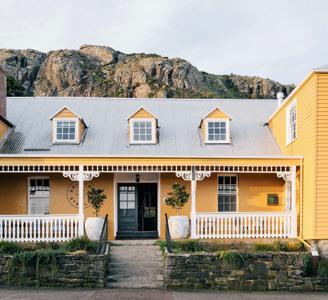
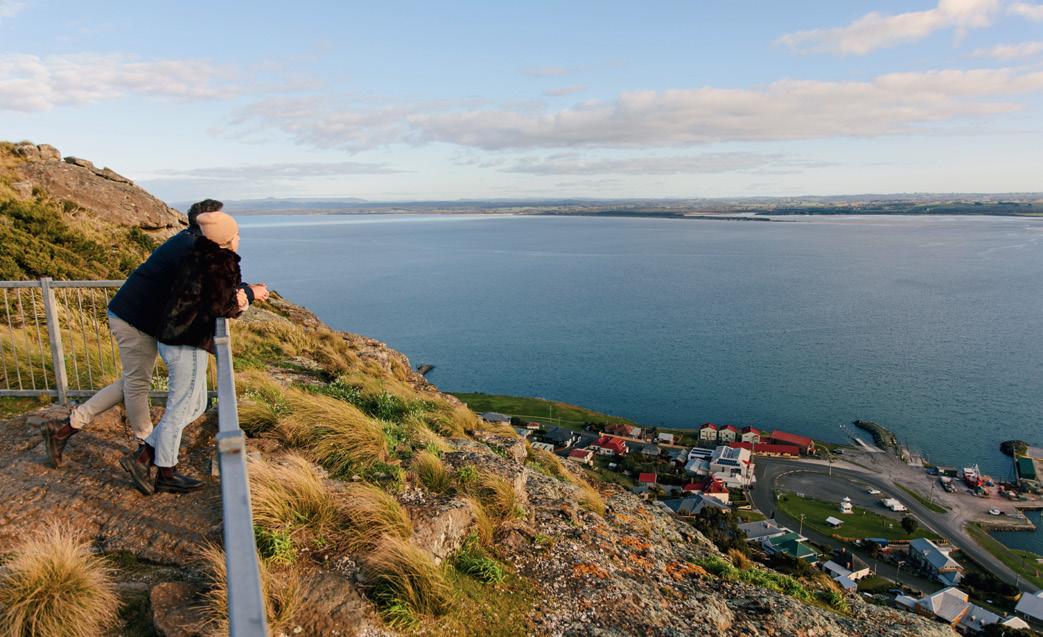
72. Take a sweet side-trip
Don’t miss the indistinct turnoff to Mawbanna from Bass Highway at Paytanarung/Black River. Go inland to visit one of Tassie’s oldest family-owned apiaries, Blue Hills Honey, which has a cafe serving truffle-infused toasties and mead. Further down the road is Dip Falls and Big Tree, which is more than 400 years old and 17m around. There’s a wheelchairaccessible viewing platform above the falls and access to Big Tree.
73. Drive and dine
When you embark on a Tasting Trail crawl, make sure you’re carrying these two essentials in your vehicle: an Esky and a designated driver. The majority of makers on the trail, which stretches from Launceston to Smithton, produce wine, cider, beer or spirits. The rest do chocolate, truffles, hazelnuts, gelato, berries, honey, cheese, olives, seafood, smoked meats and coffee, too, which will help to keep the driver awake.
Within the strip of colonial buildings stretching from Stanley’s beach to its port, one heritage-yellow hotel stands out like a beacon. Ship ballasts and basalt from The Nut, on whose lower slopes it stands, were used to build this sturdy structure to basically buffer Brits from Bass Strait blows. This Off Season, Ship Inn Stanley guests get a complimentary pair of warm mustard-coloured socks for further protection. The Nut is part of North West Nation.
The Nut is the stump of an ancient volcano. In winter the chairlift takes a break so the only way to its 143m summit is under your own steam. The concrete pathway gets very steep in parts on the way to the top, but a flatter path circuits the plateau. Up there you’ll find a lookout to Pinmatik/Rocky Cape and some surprised wallabies. Munatrik/ Circular Head, Stanley and The Nut are on North West Nation.
76. Find your flow
The Blue Tier end of the 42km Bay of Fires trail, connecting Derby with St Helens, closes over winter. However, from Ansons Road, you can enter at the halfway mark and ride from there to Swimcart Beach. A few kilometres from St Helens are Flagstaff Stacked Loops — all green and blue trails, better suited to beginners — and the advanced blackdiamond Loila Tier trails. Dreaming Pools is a 27km adventure ride. Around St Helens you’re on North East Nation.
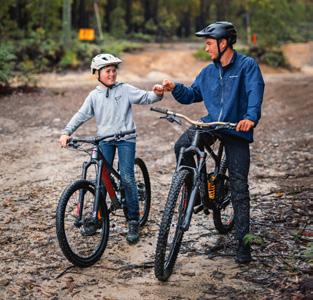
77. Catch a break
If you surf through Tasmanian winters, respect. As you’d know, mid-year conditions can be some of the most favourable with bigger waves and more reliable swells. Not that swell is something we’re particularly short on here. On the East Coast, head to Shelly, where peaks are (usually) as plentiful as affordable camping spots. There’s also Falmouth and, at Bicheno, Redbill Beach.
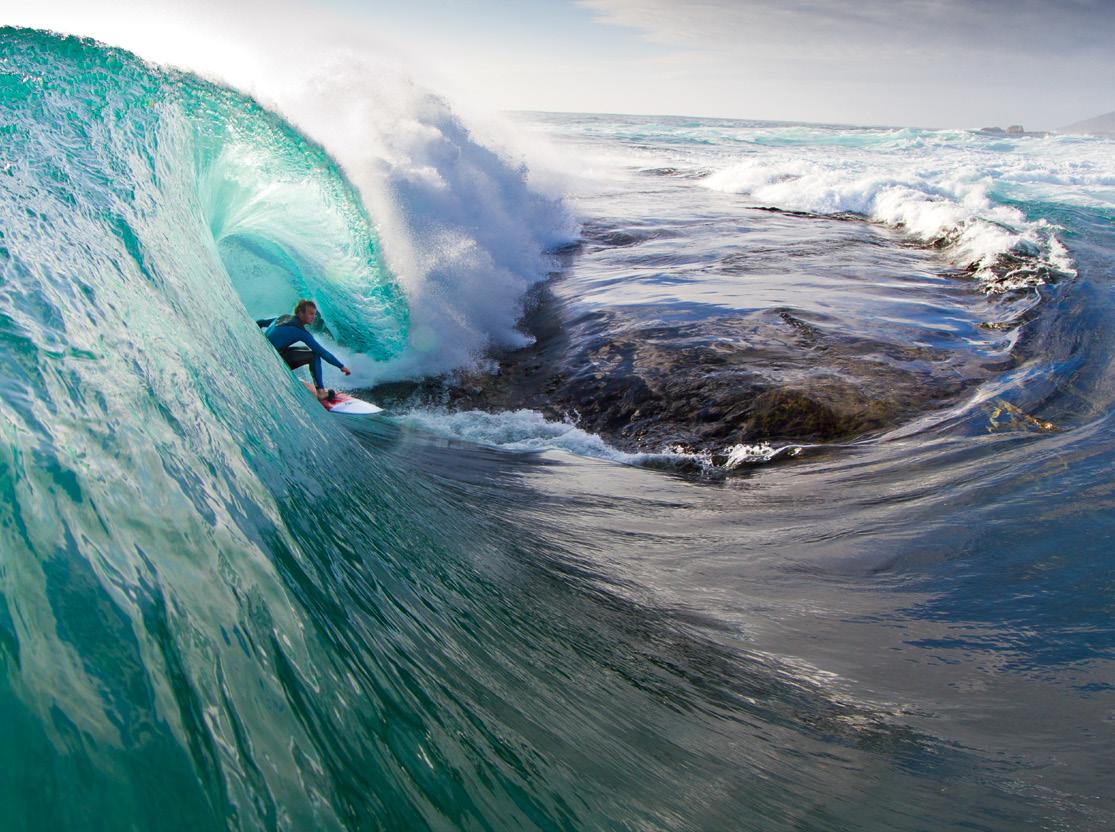
78. Pair up
Devil’s Corner, near Bicheno, with sweeping views across Oyster Bay to Freycinet Peninsula, is part of the Brown Family Wine Group. This Off Season, Devil’s Corner is offering a selfguided tasting experience: four wines from the premium range paired with hand-crafted Tutumaz and The Devil chocolates. Cellar-door tastings require a booking and a fee. No need to book to eat onsite at Tombolo Freycinet or The Fishers. This is on Oyster Bay Nation.
79. Take the plunge
Cold water immersion may offer certain health benefits such as supporting immunity, reducing inflammation and improving metabolism. It’s best done in a gorgeous environment where the water’s easy to get into and out of, such as a freshwater swimming hole. This winter, preferably on a still and sunny day, have a quick dip in a clear pool at Douglas-Apsley National Park near Bicheno. Afterwards, everyone’s eyes will be shining on Oyster Bay Nation.
When it’s low tide and calm weather, walk from Bicheno’s Redbill Beach out along the sand spit to Diamond Island. This little island, of less than 7ha, is an extensive rookery so stay on the rocks or the penguin paths so you don’t disturb anyone’s home. Look out for swift parrots and pelicans, and keep an eye on the rising tide. This sometimesisland and surrounding waters are part of Oyster Bay Nation.
81. Slurp and sip
“Oysters taste so much better in the winter,” says Melshell Oyster Shack owner Cassie Melrose. “Short sharp flavours. Feels like I’ve been for a swim in the ocean.” Enjoy Melshell oysters fresh or self-grilled on the fire pit. Shuck and Chat tours, in early winter, include a shucking lesson, a glass of sparkling, oyster tastings and half a dozen to yourself. Located at Dolphin Sands, on Oyster Bay Nation, it’s open 10am4pm Mon-Fri.
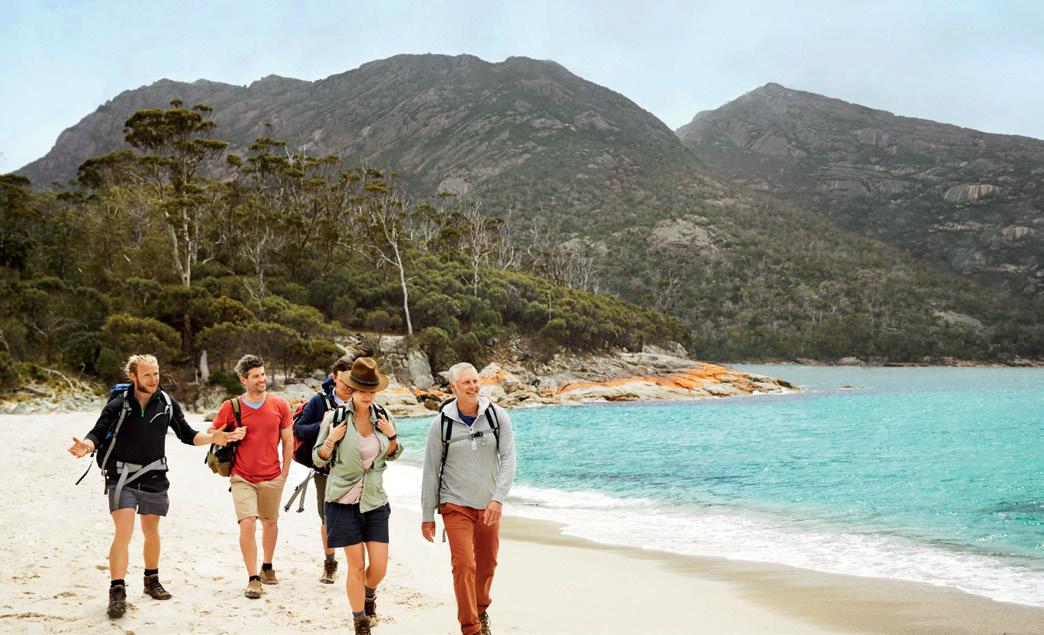
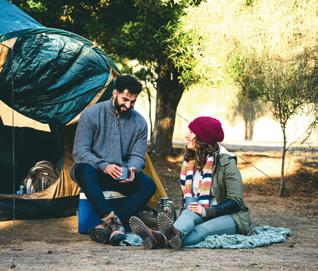
There are two ways to camp at Maria Island National Park. One is to pay a small fee for Darlington camping area, 500m from the ferry, and get undercover fireplaces, barbecues and toilets. The other is to venture south and free-camp near the isthmus. This Off Season, the Maria Island Brass Monkeys’ Swim Club is running a challenge: submerge yourself in the crystal-clear, freezing waters surrounding Maria Island. On Wukaluwikiwayna/Maria Island you’re on South East Nation.
83. Follow the river
St Columba Falls are surprisingly easy to get to and the rewards are great. They’re only a 30-minute drive from St Helens, turning off at Pyengana. The 15-minute hike to the falls is along a picturesque track through tree fern stands. Following South George River, the trail is mainly flat with some uphill and a few steps to the base of these impressive 90m falls. You’ll be travelling on North East Nation.
The Off Season is such a good time to walk Freycinet National Park. The summer crowds no longer clog Wineglass Bay track and the sun has toned itself down for the steep and exposed hike up Mount Amos. If you’re feeling really keen there’s also 27km Freycinet Peninsula Circuit track, which generally takes two to three days and requires total selfsufficiency. Puthimiluna/country at Great Oyster Bay is part of Oyster Bay Nation. Members can save at Freycinet Lodge through ract.com.au. T&Cs apply.
85. Wine your way around
Peak wine tasting, as we know, is sampling while chatting with the winemaker where the grapes were grown and the wine was made. This isn’t always possible, but it will happen at times on your self-guided tour of East Coast vineyards. The Discover Tasmania website makes it easy to know which wineries serve food, are equal-access, are dog-friendly and have special Off Season offers.
86. Forest bathe
Sabi is a stone and timber cottage at Larapuna/Bay of Fires that is beyond just being accommodation. Owners Jessica and Fred Eggleston have drawn heavily on Japanese cultural philosophies related to the healing properties of immersion in nature to create this space. This Off Season, guests can use the ice bath, onsen, wood fire, kimono-style robes and slippers with any two-night stay. Larapuna/Bay of Fires is on North East Nation.
87. Knight vision
Another beauty to tick off your 60 Great Short Walks of Tasmania list is at Evercreech Forest Reserve, outside Mathinna in the Fingal Valley. This 20-minute loop leads you to towering white gums (Eucalyptus viminalis) also called white knights or knightings. Some are more than 90m tall. Flowing through this reserve is Plipatumila/South Esk River. Learn about Mathinna, too – the name is far more than that of a town.
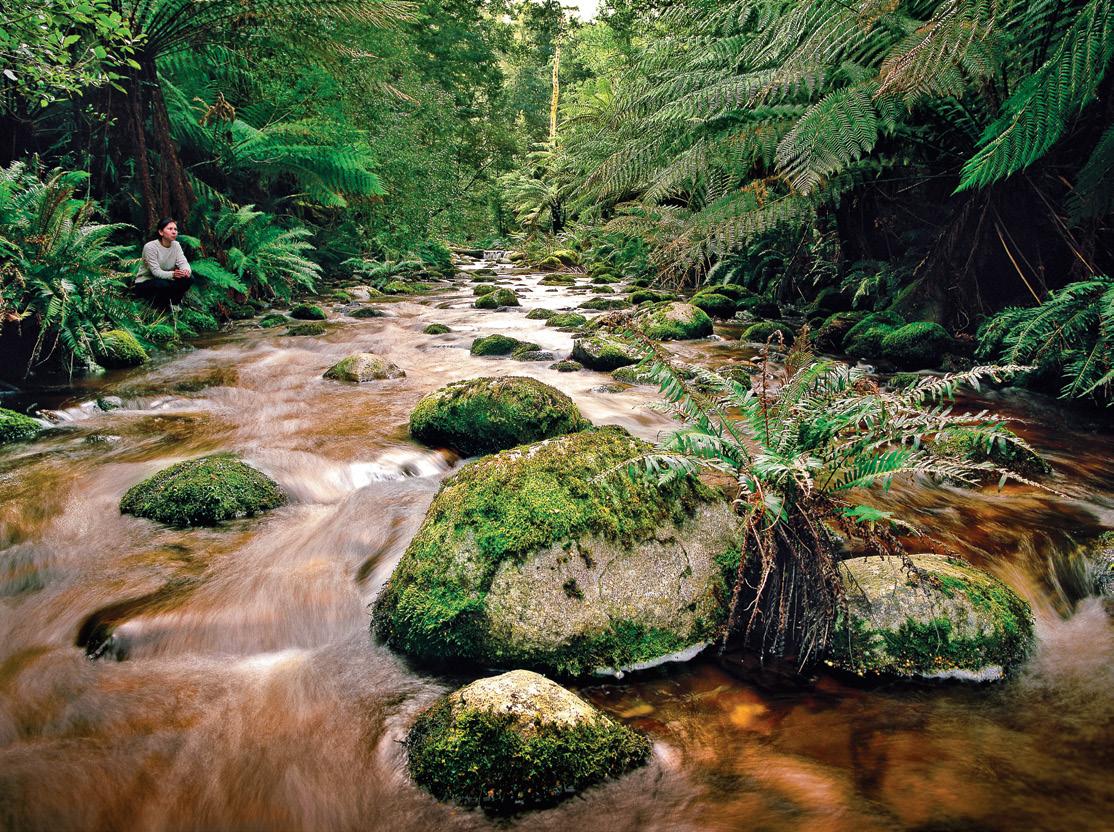
88. Fish to fry
Lobster Shack Tasmania has been serving seafood by the seaside for years. It’s a Bicheno staple, but there’s more great ocean cuisine in other pockets of this coastal town. Along with waterfront takeaways, there’s Food & Brew for a fancier seafood feed. Blue Edge Bakery is also a winner, especially when Mark makes seafood chowder packed with fish, prawns and scallops. At Bicheno, you’re on Oyster Bay Nation.
89. Do time
Darlington Probation Station, in Maria Island National Park, is one of only 11 Australian convict sites recognised as World Heritage by UNESCO. Historically, the probation system was unique to Tasmania and only lasted 14 years. On Maria, you can see 14 convict buildings and ruins, mainly of Georgian architecture, including the two-storey Commissariat Store (c.1825) near the jetty where the ferry docks. Wukaluwikiwayna/Maria Island, is on Oyster Bay Nation.
90. Go out of your way
St Marys Pass and Elephant Pass were both closed at length over the past year so make sure you give St Marys some love. “It’s such a friendly little town. The locals will say hello to you on the street and help you find where to go,” says Elaine Sullivan. She’s owned the Purple Possum for nearly 25 years and makes that famous rhubarb cake. St Patricks Head, nearby, is a rewarding slog. This area is Oyster Bay Nation.
91. Follow the trail
In the winter months, southern right whales, humpback whales and orcas migrate north. East Coast Whale Trail has 14 coastal stops between Eaglehawk Neck and St Helens where you have a better chance of seeing them. At Shelly Point and Barrel Beach there are even binoculars. Although there’s no guarantee you will see whales, this is a great way to learn more about them.
92. Enjoy this foreshore
When in Swansea, take a short walk that starts and ends at Jetty Road. Its name, loontitetermairrelehoiner, relates to a family group from this area. The 2.3km circuit trail takes in Waterloo Beach, Waterloo Point, Schouten Beach, a few blocks of the town and a muttonbird breeding area. The palawa kani name for this important bird is yula. Puthimiluna/ country at Great Oyster Bay is part of Oyster Bay Nation.
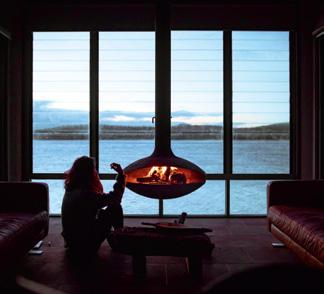
93. Contain your excitement
According to Swims Coffee, “sunrises and specialty coffee is what we do best.”
In a converted shipping container in Scamander, a block from Steels Beach, it’s open surfer-early seven days a week. Sprawl in a beanbag outside or find a sunny place inside next to a window. Swims is fully accessible and serves hot beverages, fresh toasties and baconand-egg rolls that will warm you right up. Scamander is on North East Nation.
A stone’s throw from Freycinet National Park, with views to the Hazards, Picnic Island is a privately owned island with high-end accommodation. They’re offering a three-night winter package for up to 10 people that includes water-taxi transfers. Puthimiluna/country at Great Oyster Bay is part of Oyster Bay Nation.
Seeing Freycinet from the water is a different way to experience the national park. If it’s not too windy you can kayak from Coles Bay around the coastline towards Mayaluwarana/Schouten Island or hire a dinghy, casual cruiser or yacht. Pick your days and keep your wits about you. If you’d rather relinquish responsibility, take a boat tour or charter. You’ll be on Oyster Bay Nation. Members can save on Pennicott Wilderness Journeys and Wineglass Bay Cruises through ract.clubconnect.com.au. T&Cs apply.
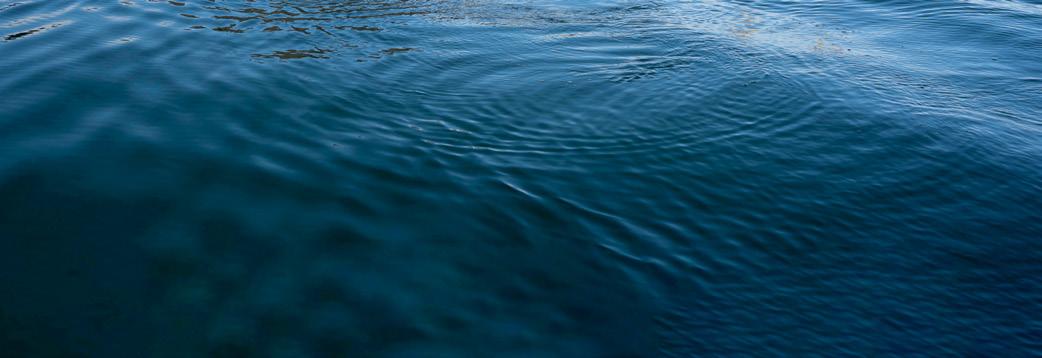
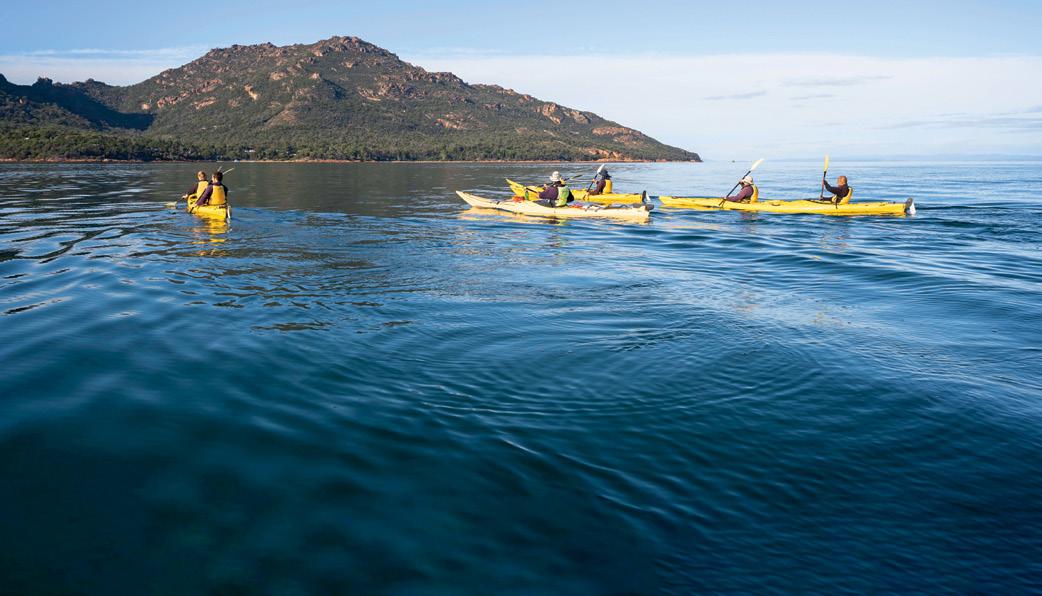
If it’s not too windy you can kayak from Coles Bay around the coastline95. Rock the boat 94. Get marooned
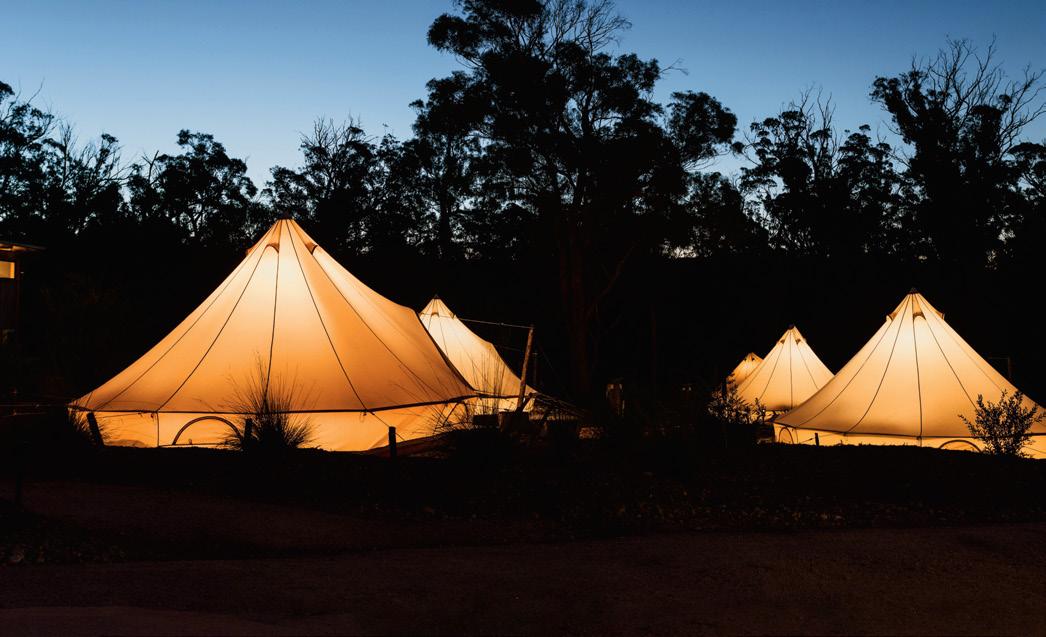
96.
What are you doing on Saturdays in June and July? How about some tasting at Waubs Harbour Whisky? It’ll be around dusk by the fire in the distillery courtyard overlooking the ocean. The team will guide you through the range of single malts, accompanied by oysters and a tasting plate, while you soak in the view and breathe fresh coastal air. That’s every Saturday in June and July. Bicheno is on Oyster Bay Nation.
97. Go to ruins
From Orford bridge, on the northern bank of Prosser River, walk or ride Old Convict Road for about 2km to the ruins of Paradise Probation Station (such an ironic name). Visiting these convictera sites can give us a chance to reflect on and take lessons from aspects of our history. There, beside Lyamangina Minanya/Prosser River, you’re on Oyster Bay Nation.
98. Get in the market
You’ll know a place better after you’ve been to its market. At markets you see what produce comes from the area and who’s making art. You’ll likely fall into easy conversation with locals, flip through record collections and take home a treasure with a story. Find out if the East Coast town you’re visiting has wintertime markets, such as St Helens Market in Portland Hall every Saturday 9am-1pm.
99. Shack up
The term ‘shack’ is used pretty loosely these days in Tasmania, even in the classic seaside towns like Orford. If you’re looking for a holiday shack to rent, it’s more likely to be a three-bedroom house, but at least you’ll be comfortable. Raspins Beach Conservation Area, near town, is a breeding ground for redcapped and hooded plovers and fairy terns. This area, where Liyamangina Minanya/Prosser River meets the sea, is Oyster Bay Nation.
palawa kani is a composite language using words revived from the many original languages of Lutruwita. Its spellings and pronunciations, such as the name Trukanini, can differ from the way these words were interpreted and written down in journals by people from other countries.
Work by the palawa kani Language Program, which began in the 1990s, is ongoing. Audio pronunciations for palawa kani place names are on the Tasmanian Aboriginal Centre’s website (tacinc. com.au/pk/GIS). Hear more palawa kani words spoken at 50 Words Project (50words.online).
Find travel information on the Discover Tasmania website (discovertasmania.com.au). Access information specific to each national park is online at Tasmania Parks & Wildlife (parks.tas.gov.au).
100. Take your pick
Bay of Fires didn’t get its name from the striking flame-coloured lichen decorating coastal boulders. In fact, it was given the name by early Europeans when someone counted more than 200 campfires and cultural burns in the landscape. There are many great camp spots along this coastline, mainly from The Gardens to Binalong Bay, and you probably have a favourite. Take wood.

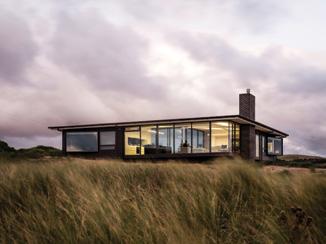
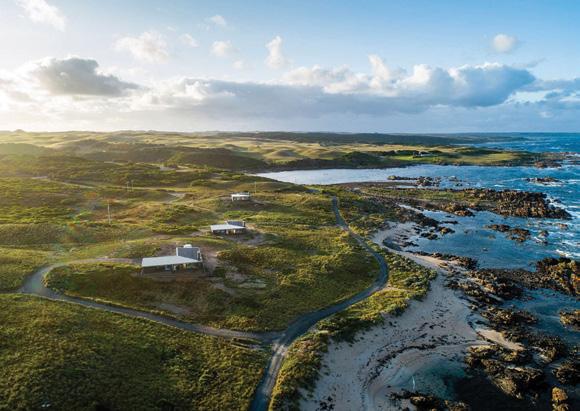
Snuggle up in front of a cosy gas log fire, relaxing on a luxurious sofa, warm cuppa in hand in awe of the Great Southern Ocean swells smashing with explosive force onto the magnificent rock formations directly in front of your retreat, just 50 metres away.
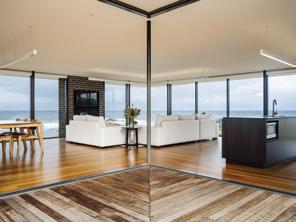
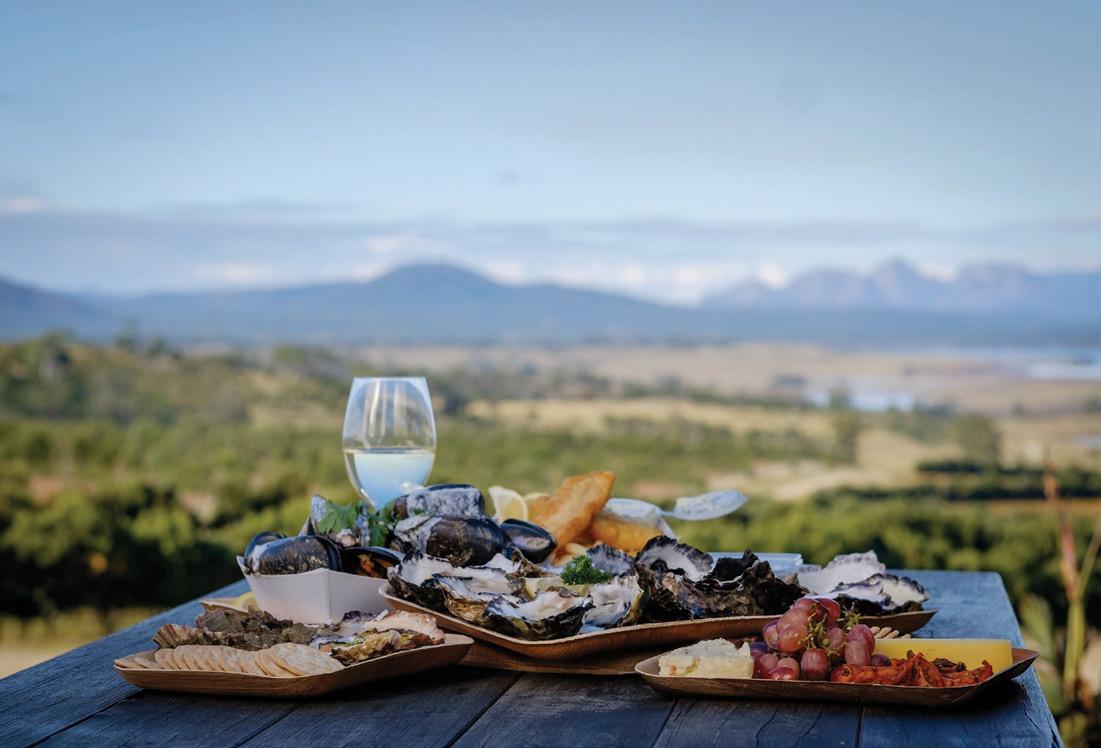
The retreats projecting outward, arrow shaped, floating on a cantilevered floor, like the bow of a ship stand solidly taking on the full brunt of the roaring forties winds. The floor to ceiling large spans of double-glazing leave nothing of the spectacle outside to the imagination, it is all real and enthralling.
Nature’s roaring 40s spectacle is intensified from June through to August and one to be experienced.

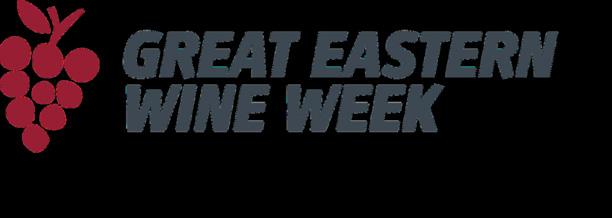
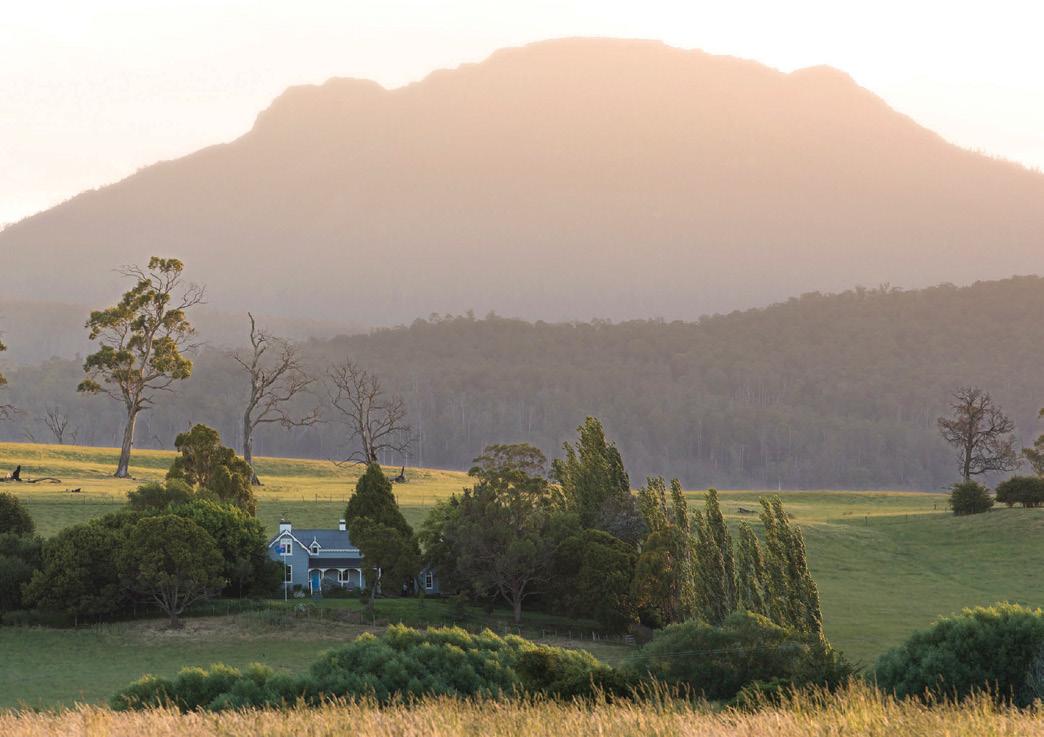

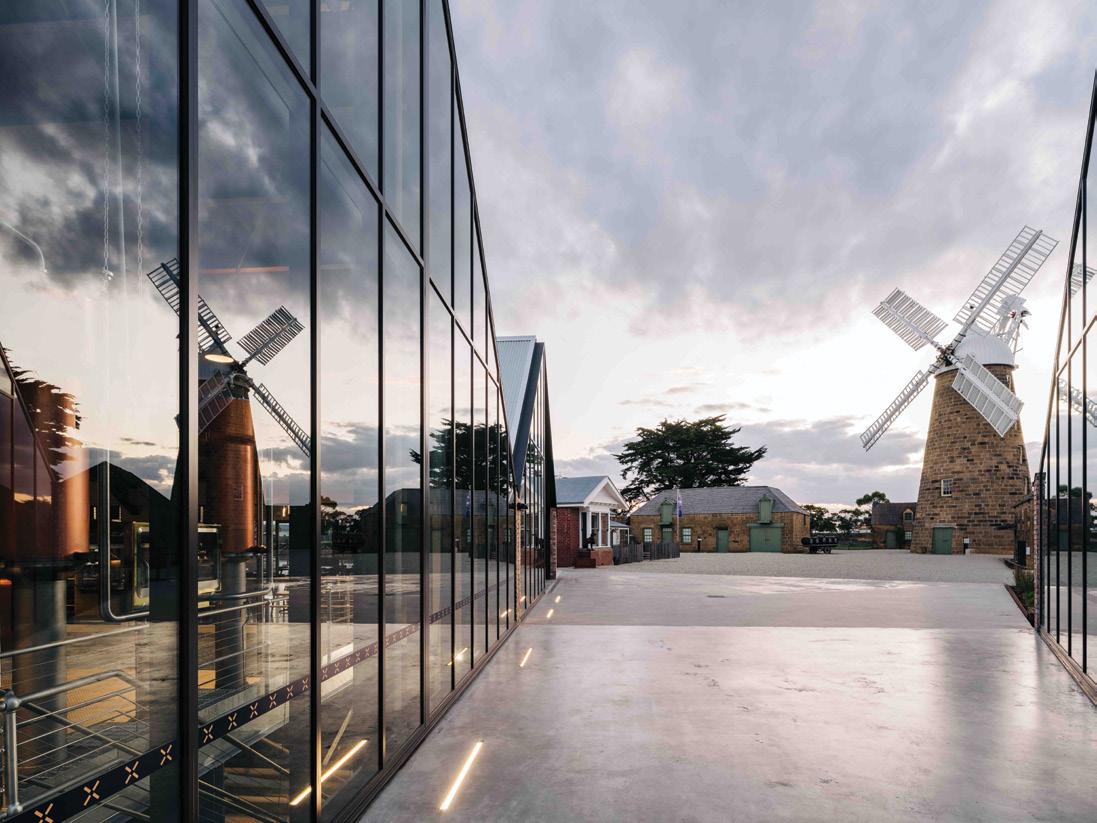
We recognise the 6,060 people lost on Tasmanian roads over the past 100 years.
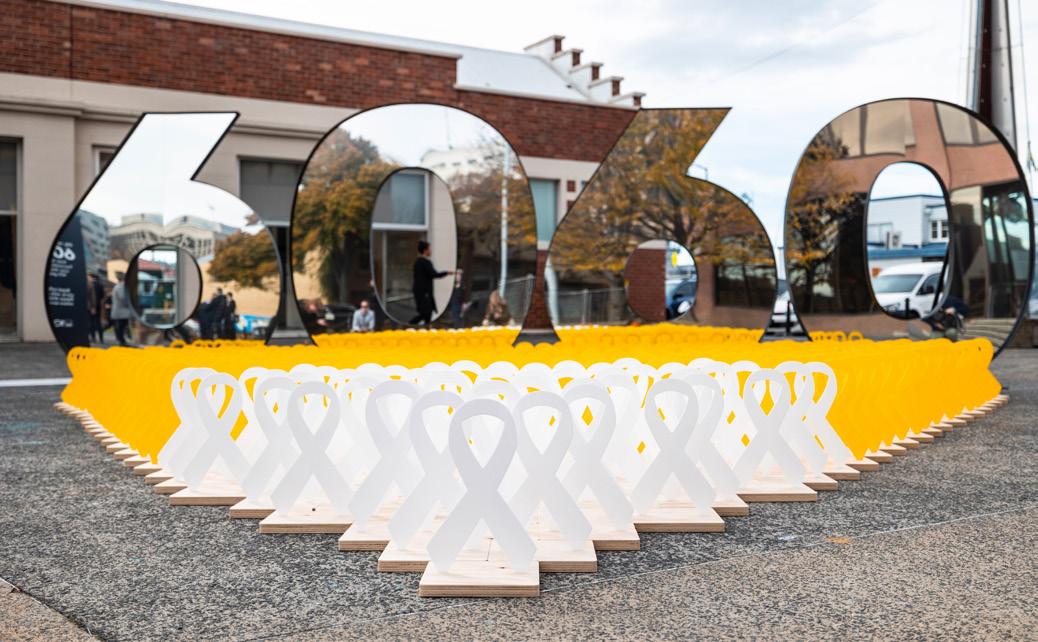
We launched a public awareness campaign for National Road Safety Week, in response to the shocking statistic that an estimated 6,060 Tasmanians have died on the state’s roads over the past century.
We’ve been advocating for road safety in Tasmania for 100 years but the state still bears the highest road toll of any in Australia, and 2023 is off to a grim start. The campaign calls on Tasmanians to pledge to drive down the road toll and raise awareness about the importance of driving safely. “We cannot afford to ignore these statistics any longer,” says our Group CEO Mark Mugnaioni.
At the campaign launch, we were joined by Stuart McPherson, who suffered an acquired brain injury after a serious motorcycle crash. He warns of the consequences of a moment’s distraction on the road: “Every decision you make on the road matters. Drive responsibly and take care of each other out there.”
Throughout National Road Safety Week, we hosted community education programs, media events and activities, while businesses and iconic Tasmanian landmarks were illuminated in yellow to show support for the cause. By encouraging everyone to participate and share the message of road safety, we aim to create a safer driving environment and reduce the number of tragic incidents on Tasmania’s roads.
Our goal was to teach the fundamentals of driving and highlight the importance of safe driving practices to these young learners.
FOR THE PAST 100 YEARS, we’ve been committed to promoting road safety and helping our community, especially young people who are just starting out on the road. As part of National Road Safety Week 2023, we‘ve partnered with some amazing organisations to deliver 100 free driver training lessons to young people in
Children’s safety is paramount when assessing car seat safety and disposing of unsafe seats

Car seats are essential for keeping children safe while travelling, but they can become hazardous due to wear and tear or age. As a part of National Road Safety Week, we led a campaign to emphasise the importance of assessing car seat safety and proper disposal.
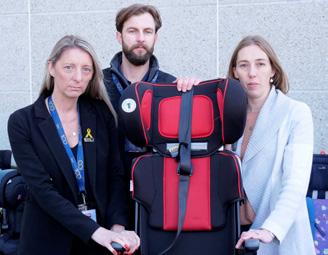
“Passing down or giving away car seats may seem helpful, but it’s crucial to know the seat’s history. Ensure it hasn’t been in an accident, is no more
need of assistance across the state. We worked alongside Kennerley Children’s Homes, the Migrant Resource Centre, Youth, Family & Community Connections Inc., and the Tasmanian Aboriginal Centre to offer the lessons at our Driver Training centres in Hobart, Launceston, Devonport and Burnie.
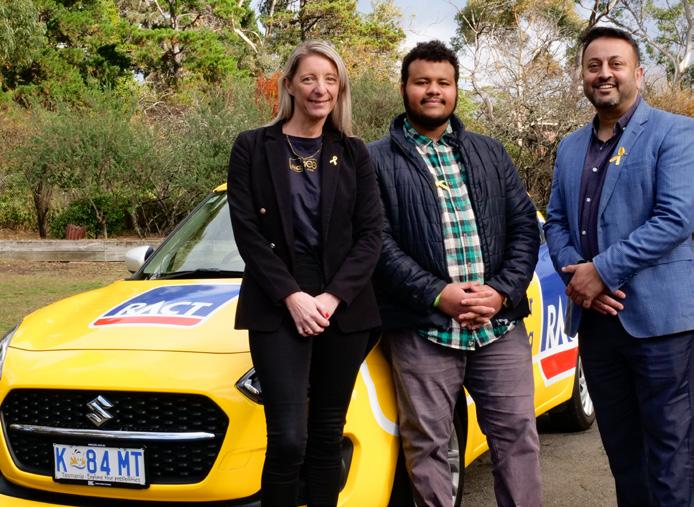
We‘re thrilled that we could offer this kind of training to young people who might not have had access to it before. “Many of the families we support come from backgrounds where this type of training isn‘t readily available. It‘s been wonderful to provide our most vulnerable young people with the chance to learn such an essential life skill,” Cedric Manen said.
“These lessons will provide participants with crucial information about driving and road safety. They’ll learn about the importance of wearing seat belts, the dangers of driving under the influence of drugs or alcohol, and the importance of being alert and attentive while driving,” RACT’s Chief Operating Officer Stacey Pennicott said.
Our Chief Advocacy Officer, Garry Bailey, said, “Not only are we teaching our most vulnerable road users how to drive safely, but we‘re also helping them to become more responsible and informed drivers, which, in turn, helps to create a safer and more responsible community.”
than 10 years old and has securely clicking buckles. Ideally, dispose of child seats appropriately,” RACT Chief Advocacy Officer Garry Bailey said. Our initiative removed 89 unsafe seats from circulation. To dispose of an unsafe seat, follow these steps:
1 Cut the harness, top tether and adjuster webbing.
2 Remove the SAI Global 5 Tick sticker and any date-ofmanufacture stickers.
3 Write “BROKEN – DO NOT USE” on the shell.
4 If possible, remove headrests, bases or other parts before disposing of the unit.


To celebrate the past 100 years of being Tasmania’s shoulder to lean on, we commissioned Tasmanianbased historian and author Nick Brodie to write a limited-edition book, RACT 100 Years of Service. We asked Nick a few questions about the process.
Q What’s the most interesting aspect of RACT’s history that revealed itself to you during your research?
Mental health can be a tough conversation, but as an organisation we’re pushing to break the stigma and to make sure everyone knows that it’s okay to speak up when it matters most. As part of this commitment, earlier this year we partnered with Tasmania’s own SPEAK UP! Stay ChatTY. Through programs, events and community work, it works statewide to deliver key messages around the importance of talking about mental health, seeking help and supporting each other.
Q How did you approach writing a corporate history?
A The company usually has their own ideas and expectations for the story they want to tell. In the case of RACT, my approach was to explore Tasmania’s history through the lens of an organisation that’s lived through the last 100 years of Tasmania.
Q Do you have a favourite story from the book?
A I love the story of the scout mechanics that would drive around looking for breakdowns. The club taking orphans on excursions to Kingston Beach in the early days, and fundraising for an ambulance to support the war effort in the second world war, were also fascinating.
A The relationship between RACT and the advent of automobiles in Tasmania was the most fascinating aspect. RACT played a crucial role in improving Tasmania’s infrastructure to accommodate the growing number of cars on the road. The evolution of the automobile and its impact on Tasmanian society and the economy over the past century was a great story to tell.
Q Besides advocating for better roads, what role has the RACT played over the past century?
A RACT has evolved from a motoring club to a multifaceted organisation that offers roadside assistance, insurance and travel services. It’s interesting to see how they’ve adapted to changing times and technologies to continue meeting the needs of members.
You can purchase a copy of RACT 100 Years of Service via ract.com.au/100year-book and members save at checkout.

In May we held our first member exclusive event at Wrest Point’s Showroom, presenting a lived-experience presentation from SPEAK UP! Stay ChatTY founder and 2017 young Australian of the year, Mitch McPherson. With over 200 people in attendance, it was an unforgettable evening of education, inspiration and positive action. Soon we’ll be hosting a similar event in the state’s north. For more information, visit our website.
On the shortest day of the year (22 June) SPEAK UP! Stay ChatTY’s annual initiative Shorts Day took place. “Shorts Day continues to be an impactful way to bring the Tasmanian community together,” Mitch explains. This year as the major supporter, our staff from across the state braved the cold and wore shorts in the name of mental health. To see what we got up to on the day check out our socials.
As the cold winter months approach, it’s important to make sure your home is prepared for the weather ahead. One aspect of this is having adequate insurance cover in place, but there are a number of other steps you can take to minimise the risk of damage to your property. Here are some tips to help you get started.
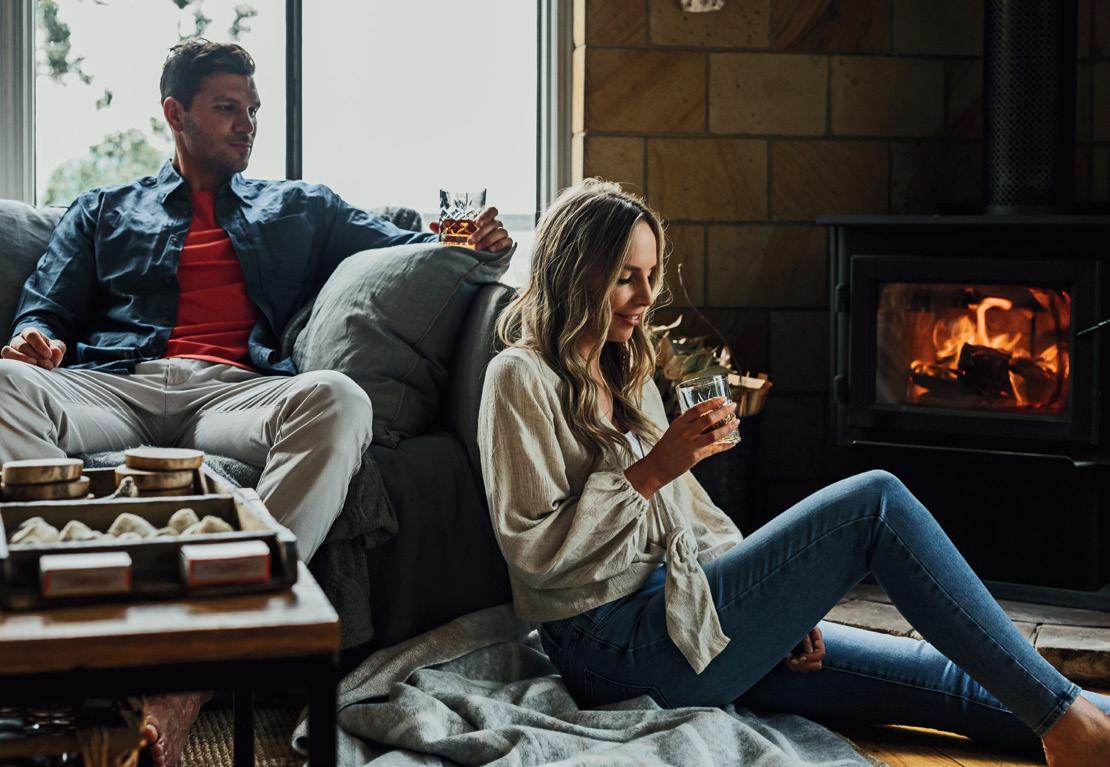
A build-up of autumn leaves in gutters and downpipes can cause blockages and water damage, so make sure they’re clear before winter sets in.
Service woodheaters and heat pumps to ensure they’re running efficiently, and to help prevent potential fire hazards.
Privately-owned ground drainage and gullies can get clogged with leaves. Ensure they’re clear and free of blockages.
Keep your home warmer by checking door and window seals are in good condition and investing in rugs for bare floors.
Heating your home in winter increases the risk of house fires, so check your smoke alarms.
Don’t hang clothes or bedding over heaters, and don’t place furniture too close to heat sources. It may feel cosy but it creates a fire hazard.
Ensure your insurance cover is up to date and the value of your home and contents is appropriate.
Be prepared. Protect your home with a home and contents insurance policy that suits you. For more, visit ract.com.au
In many Tasmanian workplaces, vehicles are an essential tool of the trade. They may be company utes or vans, employer-provided cars, or personal vehicles used for work purposes. In these workplaces, there is often a strong emphasis on safety - with equipment, machinery and even phone chargers undergoing regular inspections and testing to ensure they meet strict safety standards. Workplace health and safety systems are in place to protect workers and employers alike, with stringent sanctions for breaches and training to maintain a safe environment for all.
However, when it comes to vehicles used for work, there is often a gap in safety practices. Workers may leave their workplace and drive off in a vehicle without any knowledge of its safety features or maintenance history. Similarly, passengers may be unaware of the competence or driving history of their workmate behind the wheel.
Four years ago, Tasmania endorsed the “Vehicles as a Workplace: Work Health and Safety Guide” to incorporate road safety into workplace health and safety. Unfortunately, actions taken so
far have been limited to the Tasmanian Government‘s operations and the development of the Department of State Growth’s safe use of vehicles policy. According to the National Road Safety Action Plan, vehicle use in road traffic is the most significant contributor to work-related traumatic injury. Safe Work Australia reports that 68% of worker traumatic injury fatalities since 2017 have involved a vehicle, with half of these incidents occurring on public roads.
The Tasmanian Government needs to implement a comprehensive, whole-ofgovernment approach to road safety in the workplace. This initiative should encompass all agencies and government business enterprises, leading by example and encouraging private businesses to follow suit. Although some Tasmanian businesses, particularly in heavy transport, are already making strides in this area, a coordinated effort is required to integrate road safety, driver behaviour monitoring, and in-cabin and GPS technology into workplace health and safety regimes across the state.
Treat vehicles as dangerous machines, subject to the same safety standards as other workplace equipment.
Regularly inspect and maintain vehicles to ensure they meet safety standards.

Ensure workers using vehicles are competent to operate them.
Implement a training regime to assess, maintain and improve driver competency.
Establish government inspections to ensure compliance and enforce penalties for non-compliance.
Recognise employers’ duty of care to employees operating vehicles.
Encourage employees to adhere to workplace health and safety regulations.
Extend employees‘ duty of care to passengers in work vehicles.
Make road rules the workplace rules when using a vehicle for work purposes.
Use improved workplace behaviour to influence positive change in drivers‘ habits off-duty.
By implementing these measures, we can improve road safety n Tasmanian workplaces, promote responsible driving habits and protect employees. Keep updated with our road-safety advocacy at ract.com.au/advocating-change
The way forward is clear:
The Department of State Growth needs more crossing guards across Tasmania. If you are looking for paid work and want to support your community, you should consider applying.

Dressed from head to toe in fluorescent orange, Annette from Carlton stands out, greeting parents and highfiving students, all while vigilantly keeping an eye on the passing traffic. As the flow of cars slows, Annette holds her stop sign out and the drivers take her cue to slow down and stop.
“It’s a great job,” says Annette (pictured). “I feel a real sense of community doing this job and it’s a great feeling knowing that I’m helping to keep kids safe”.
The Department of State Growth employs around 75 permanent and 30 casual school crossing guards to assist children at busier children’s crossings around Tasmania.
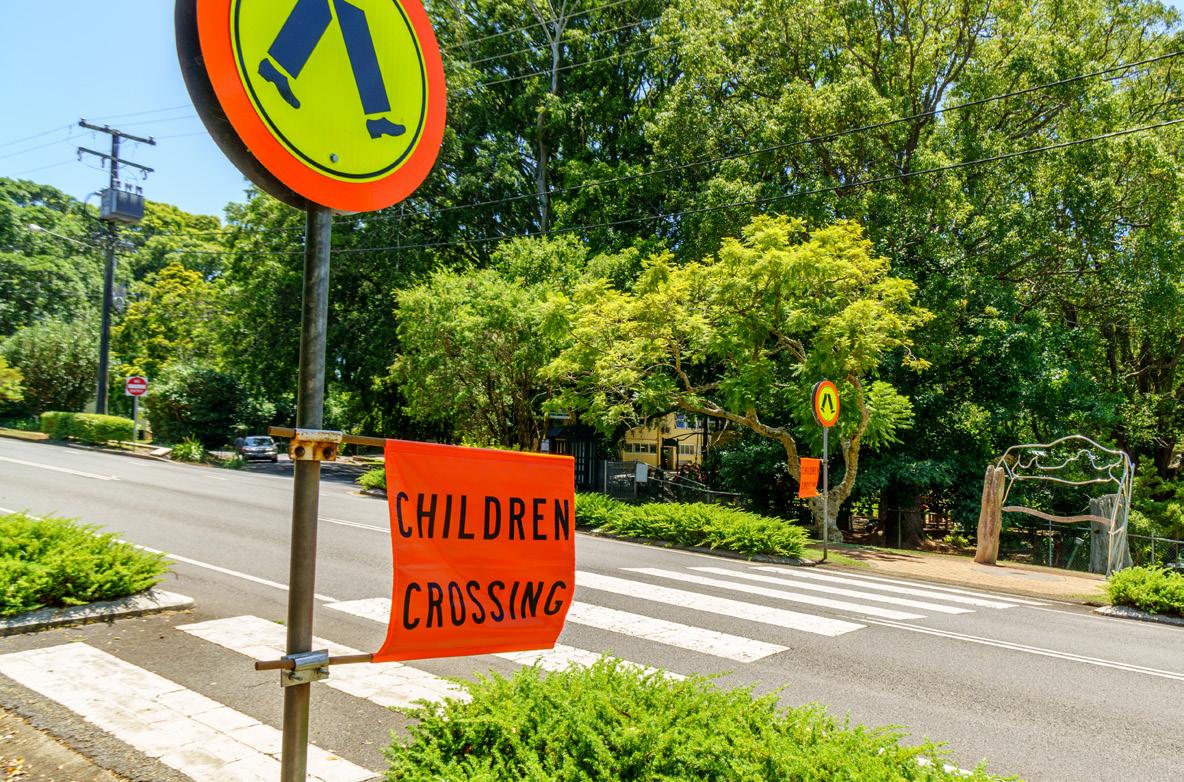
Each day parents send their children off to school and trust that they will get there safely. Our school crossing guards play an important role in this. School crossing guards are the smiling face greeting kids every morning as they head into school and are there to wave them goodbye at the end of each day. Annette says, “It’s hard to have a bad day after greeting the kids each morning. You get to be a part of their day and hear about what they are up to, while also helping to get them to and from school safely”.
Annette highly recommends the job. “In this role you really become part of the school community,” she says. “I know I’m playing an important role in teaching kids to cross the road safely while earning some extra income. I get a real sense of satisfaction from the job and would recommend it to anyone that is considering having a go”.
“Many think this important job is a volunteer role, but it’s actually a paid role. The extra money is useful as things get more expensive and it doesn’t affect my pension.” All equipment and training is provided.
School crossing guards generally work for one hour in the morning at the beginning of school and 30 minutes in the afternoon after school, Monday through to Friday during the school term, but the casual option allows you to choose your availability, meaning you don’t have to work each day. It leaves plenty of time to enjoy the day, finish some chores or care for a loved one.
The role is perfect for anyone heading into semi-retirement or retirement and looking for a way to connect with community or earn a few extra dollars.
If you would like more information on the role or would like to apply, please contact (03) 6166 3248 or email scpo@stategrowth.tas.gov.au
With the chance to earn extra income and teach road safety to kids, school crossing guards fulfil an important role in our community.

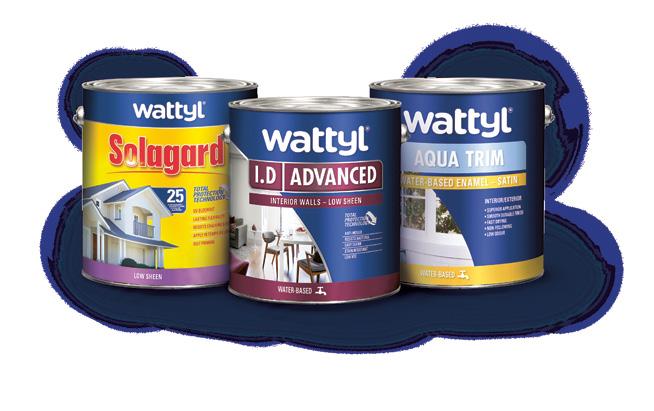
Group CEO Mark Mugnaioni said, “At RACT, we understand the importance of fostering an inclusive environment that values the contributions of all members of our community. The establishment of the DIWG reflects our dedication to promoting diversity and Aboriginal empowerment.“
One of the major initiatives currently being undertaken by the DIWG is the development of RACT‘s first Reconciliation Action Plan (RAP). The RAP is a strategic framework that outlines the steps and actions we will take to promote understanding, respect and recognition of the rights, histories and cultures of Aboriginal and Torres Strait Islander peoples.
This year is a significant milestone in Australia‘s journey towards diversity and inclusion, as the nation prepares for the Voice to Parliament referendum.
As Australia engages in this important conversation about the representation of Aboriginal and Torres Strait Islander peoples in policies and legislation, RACT is proud to support and promote diversity and inclusion.
To demonstrate our commitment to these values, we have recently established the Diversity and Inclusion Working Group (DIWG). This group‘s primary goal is to create and foster a more inclusive and supportive environment for all members of our community, including Aboriginal and Torres Strait Islander peoples.
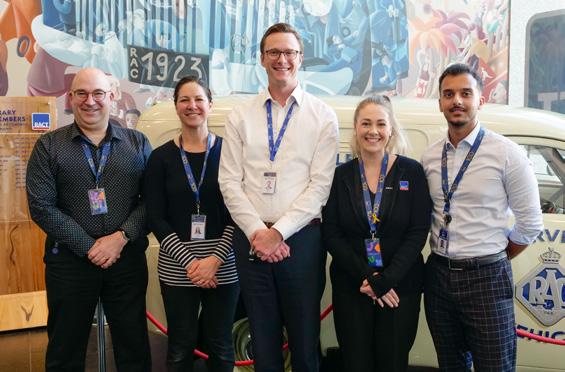
“Our Reconciliation Action Plan will focus on strengthening relationships with palawa and pakana communities, ensuring our services are accessible and culturally appropriate, and providing opportunities for professional development and career progression for First Nations people,” sad RACT‘s Chief People Officer, Ingrid Shannon-Smith.
“We recognise that our journey towards diversity and inclusion is ongoing. We’re committed to learning from our past, embracing our present and actively working towards a more inclusive and equitable future for all Australians.”
Through RACT’s DIWG and the development of our Reconciliation Action Plan, RACT is dedicated to empowering Aboriginal and Torres Strait Islander peoples and ensuring their voices and strong connection to Country are acknowledged and respected.
RACT is proud to be leading the charge in this key moment in Australia’s journey.
Make the most of these rewards this winter
RACT Finance
Make your dream car a reality with flexible repayment options and no monthly service fees from RACT Finance.
Save 1% p.a. on loan rates by quoting your membership number when applying. Member discount does not apply to the new car special rate. Go to ract.com.au/ract-finance

SAVE 1%
SAVE 10%
Warm up the look of your home with fresh colours. Members save 10% on paints, stains and accessories at Wattyl Paint Centres in Launceston and Hobart every day.*

See ract.com.au/wattyl-paints
Parrs Heat Pump and Refrigeration Centre
Keep your family warm all winter by regularly servicing your heat pump.

Save 10% on heat pump servicing.* Go to ract.com.au/parrs-heat-pumpcentre
SPECIAL RATE
Relax with some delicious popcorn and a new release movie. Treat the whole family or have a date night in Gold Class.

Pay only $14.50 for standard movie eVouchers and $35 for Gold Class. Price is subject to change.*
Go to ract.com.au/village-cinemas
SAVE 10% SPECIAL RATE
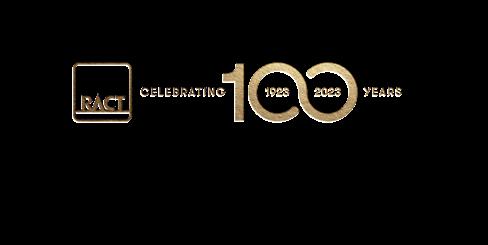
Health and Fitness World
Get the heart rate up by starting a new fitness routine. Members can access a special rate of $32 per fortnight at Health and Fitness World Launceston. You’ll also enjoy flexible cancellation, with no lock-in contract.*
See ract.com.au/health-and-fitnessworld-launceston
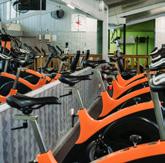
Heading off on a winter trip? Check out these rewards
eGift cards
Whether you want to refresh your whole wardrobe or just treat yourself to some warmer pieces for winter, you can save a little bit extra on a range of eGift Cards.
Save up to 10% on eGift Cards.*
See ract.com.au/egift-cards

SAVE 10%
Don’t
SAVE 20%
Enjoy the best of Hobart in winter and make a reservation at Sullivans Cove Apartments. Choose one of four vibrant locations around the Hobart waterfront.
Save 20% on apartment accommodation.*
Go to ract.com.au/sullivans-coveapartments

SAVE 10%
Stay at home and explore this winter. Make the most of our island state with a range of activities and experiences for the whole family.
Save up to 10% on experiences in Tasmania.*
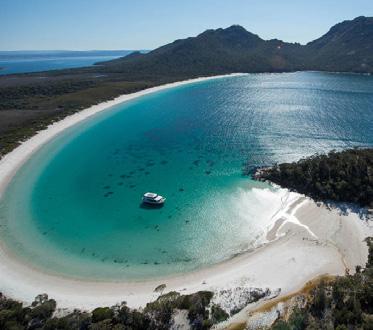
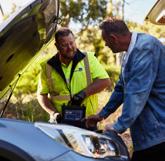
Go to ract.com.au/experiences-tas
Thinking about heading to Queensland for the sunny weather? Don’t forget to check out all the activities and experiences you can save on across the state.
Save up to 10% on experiences in Queensland.*

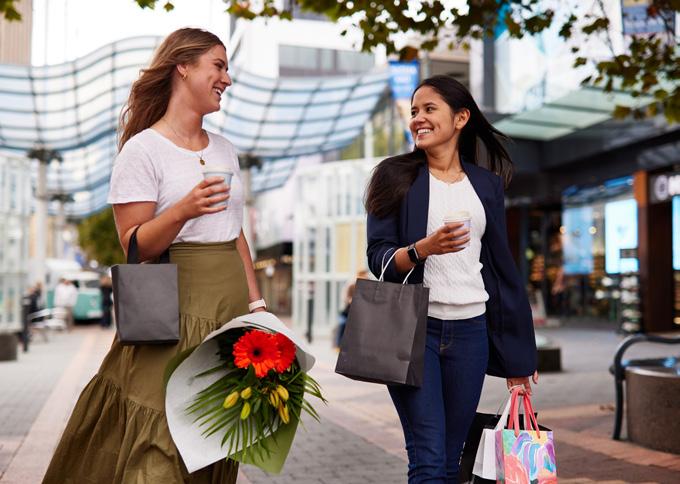
SAVE 10%
Go to ract.com.au/experiences-qld

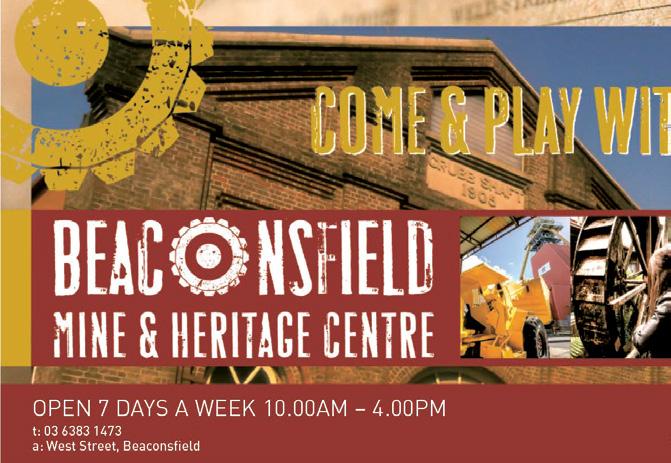

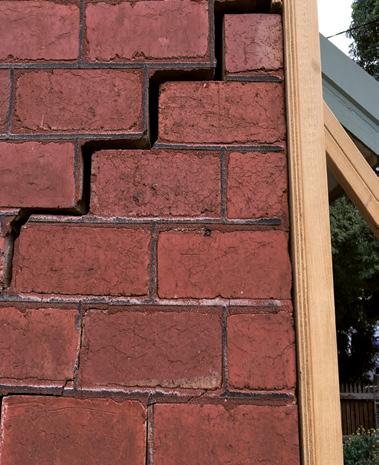



1 The Beaconsfield mine collapse, which killed one and left two miners trapped underground for a fortnight, occurred on 26 April ____ ?
2 What was the official name of the first Holden in 1948?
3 In what year did Prince Charles and Princess Diana divorce?
4 Which country has the largest coffee-growing industry in the world?
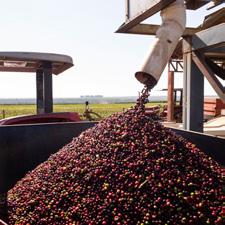
Crossword
25 That is to say; namely (2,3)
7 Not malignant (6)
8 Medium-sized sailing boats (6)
28 Inferior end of a neck of mutton (5,3)
1 Form a unified whole (6)
4 Large bay in south-east Tasmania (5,3)
29 A rehearsal of a performance or procedure (3,3)
10 Unspecified place (9)
11 Frantically busy; hectic (5)
12 Embed (material or a design) flush with the surface of an object (5)
Down
13 For the duration of a night (9)
14 Give an odour or scent to (7)
1 Hard, relatively brittle alloy of iron and carbon (4-4)
16 Pull or take something out of water or a receptacle (4)
19 Stare at in a lecherous manner (4)
21 Thin sheet of card, plastic, or metal with a pattern or letters cut out of it (7)
2 Rural locality in central Tasmania. Located 73km north-west of Hobart (8)
24 Very thick fog (colloq.) (3-6)
5 Of the thing just mentioned; of that (7)
26 Japanese writing using Chinese characters (5)
27 Large semiaquatic reptile native to the Americas and China (9)
6 Enjoyable recollection of past events (9)
28 Inferior end of a neck of mutton (5,3)
29 A rehearsal of a performance or procedure (3,3)
7 Not malignant (6)
1 Hard, relatively brittle alloy of iron and carbon (4-4)
8 Medium-sized sailing boats (6)
9 Far-away (6)
3 Noisy and disorderly (5)
5 Of the thing just mentioned; of that (7)
15 Growing abnormally so as to press into flesh (9)
6 Enjoyable recollection of past events (9)
18 Historically an iron heated on a hotplate or fire and used for pressing clothes (8)
9 Far-away (6)
15 Growing abnormally so as to press into flesh (9)
17 Drinking water with ice cubes added (3,5)
18 Historically an iron heated on a hotplate or fire and used for pressing clothes (8)
20 Give a reason so as to justify or excuse (7)
20 Give a reason so as to justify or excuse (7)
21 One of Tasmania’s oldest towns on Orielton Lagoon (6)
5 In 2003, which Tasmanian won the reality TV show Big Brother?
6 True or false: Australia has the world’s longest fence?
7 For what style of music was rock band Nirvana known?
8 Which language, apart from English, did Queen Elizabeth II speak fluently?
2 Rural locality 73km north-west of Hobart in central Tasmania (8)
21 One of Tasmania's oldest towns on Orielton Lagoon (6)
22 Each of the wire rods connecting the centre of a wheel (6)
23 A way in which a thing is done or happens (6)
25 Very large cat native to forests of Asia (5)
9 How many legs do butterflies have?
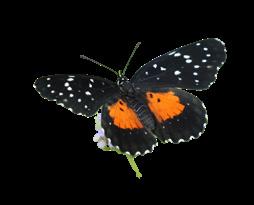
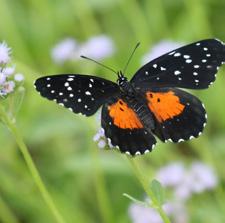
10 Which famous race driver had a Holden Torana named after him?
SOLUTIONS
3 Noisy and disorderly (5)
17 Drinking water with ice cubes added (3,5)
22 Each of the wire rods connecting the centre of a wheel (6)
Across: 1 Buckle, 4 Edifying, 10 White Gums, 11 Refer, 12 Lucky, 13 Park Grove, 14 End Note, 16 Gray, 19 Gday, 21 Atelier, 24 Esplanade, 25 Where, 26 Vocal, 27 Deloraine, 28 Decrypts, 29 Recess. Down: 1 Bewilder, 2 Coincide, 3 Leery, 5 Dishrag, 6 Fern Glade, 7 Inflow, 8 Gorges, 9 Yuppie, 15 Old Bailey,
23 A way in which a thing is done or happens (6)
Want to find out how you did? Find the answers online at ract.com.au/puzzles
Tasmania as captured by our talented members
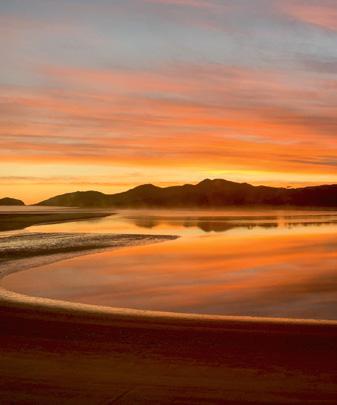
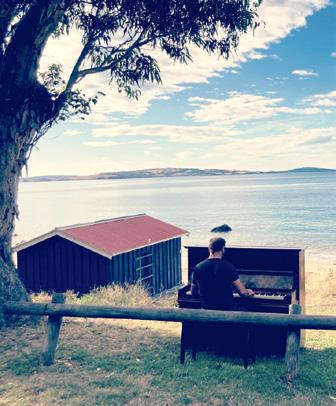

Want to see your photo here? Send your shots of our beautiful island to journeys@ract.com.au or tag us with both @ractofficial and #yourjourneys on lnstagram, Facebook or Twitter.
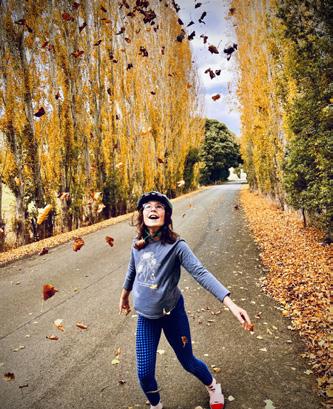
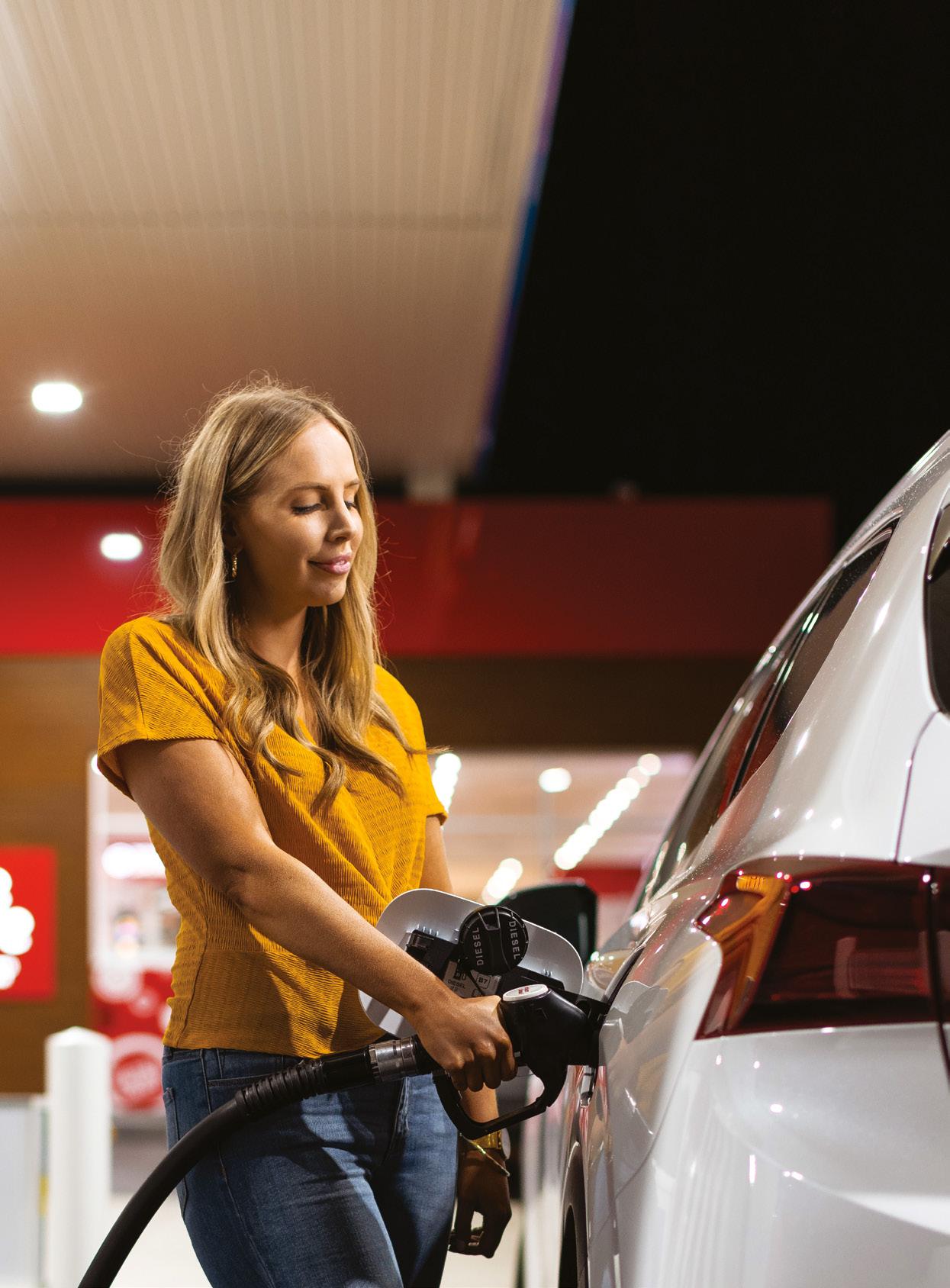 Jason Murray, Spirit Super CEO
Jason Murray, Spirit Super CEO
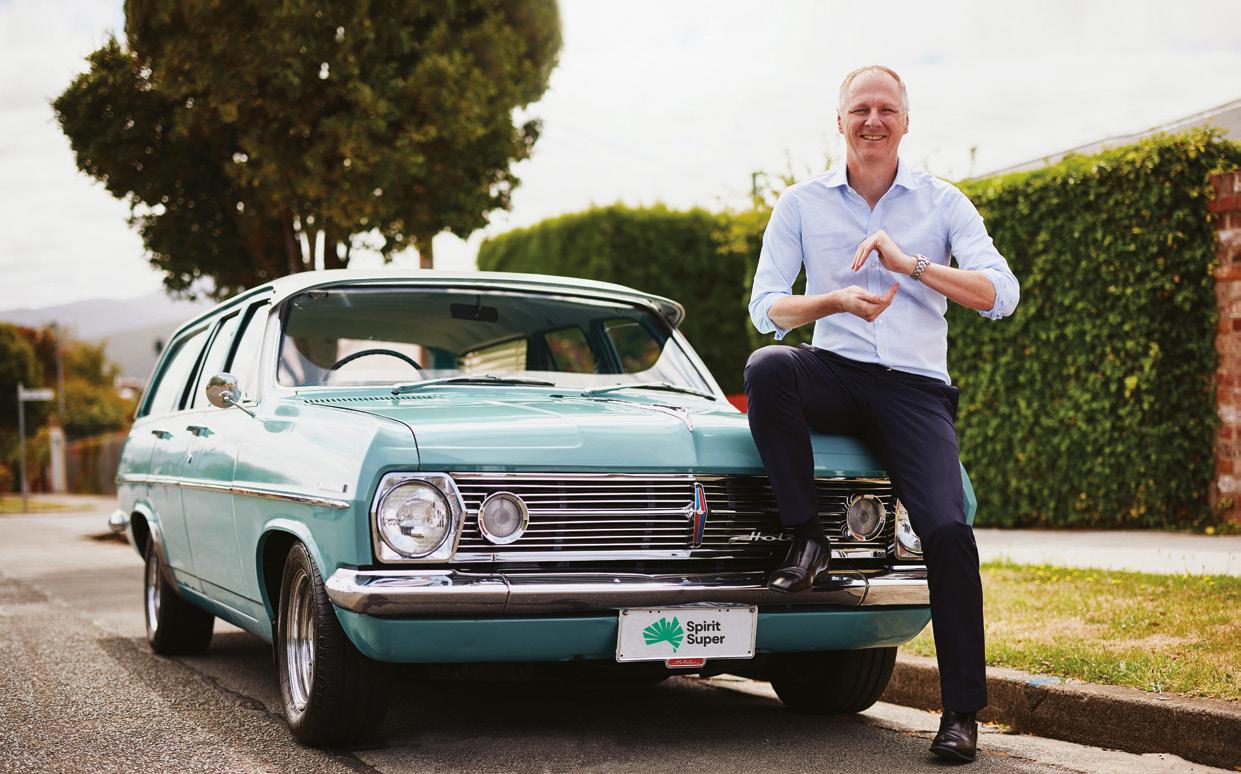
You’ve probably heard of an Industry SuperFund and know they’re a good thing, but do you know why?
An Industry SuperFund runs only to benefit members, has low fees and doesn't pay commissions to financial planners.
Industry SuperFunds were originally set up to look after the super and retirement needs of people in specific industries, protecting them from high fees and commissions. Now all Australians can join, no matter what industry you work in.
For more information about the benefits of being with an Industry SuperFund, scan the code below, or visit spiritsuper.com.au/about us/isa
